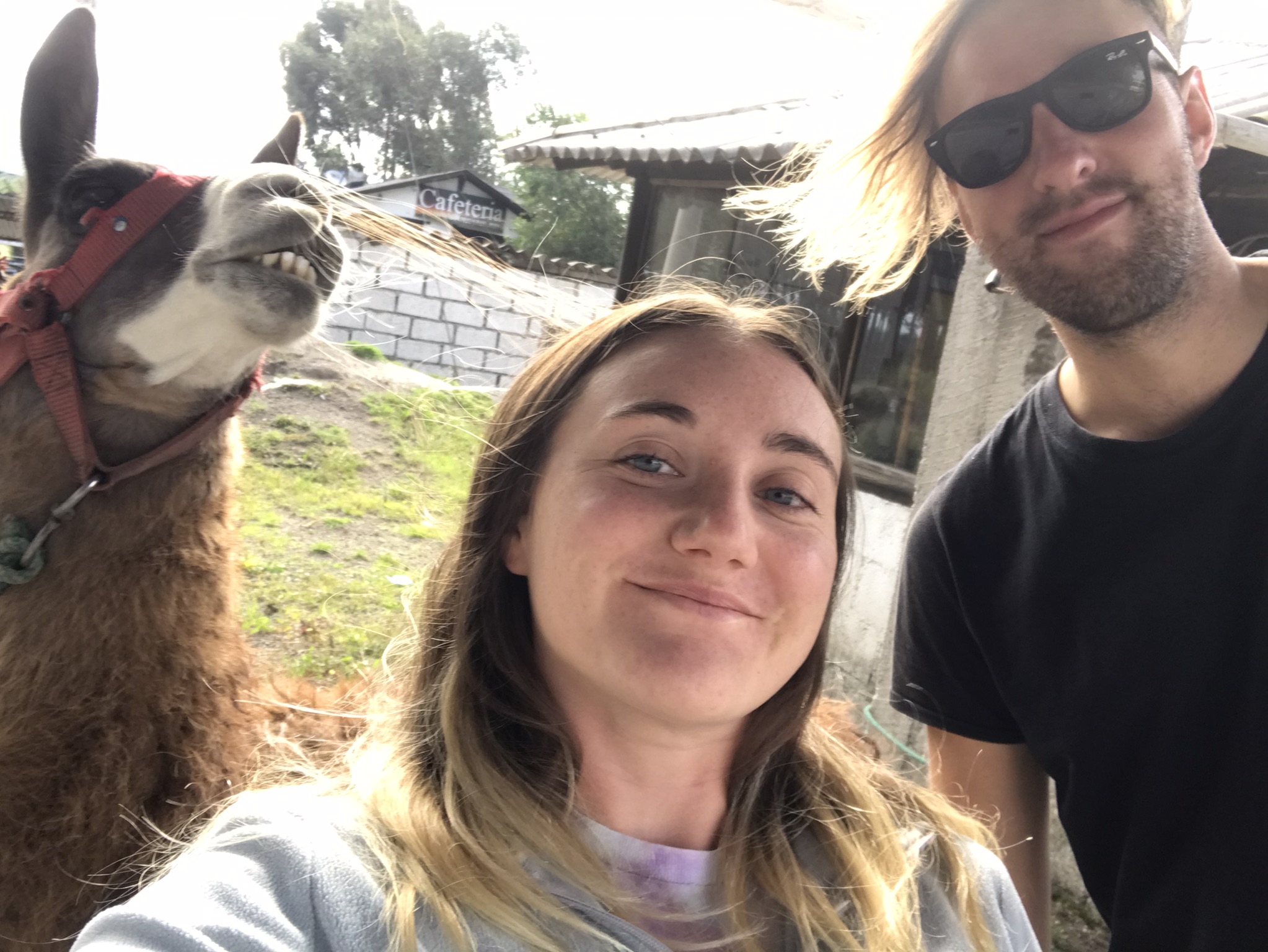With its wide variety of landscapes, grand colonial cities, world-class archaeological sites, world-renowned food scene and unique and distinctive culture, there is something for everyone in Mexico. We visited 14 states, dozens of interesting places and barely scratched the surface. Check out our Mexico travel experiences below!
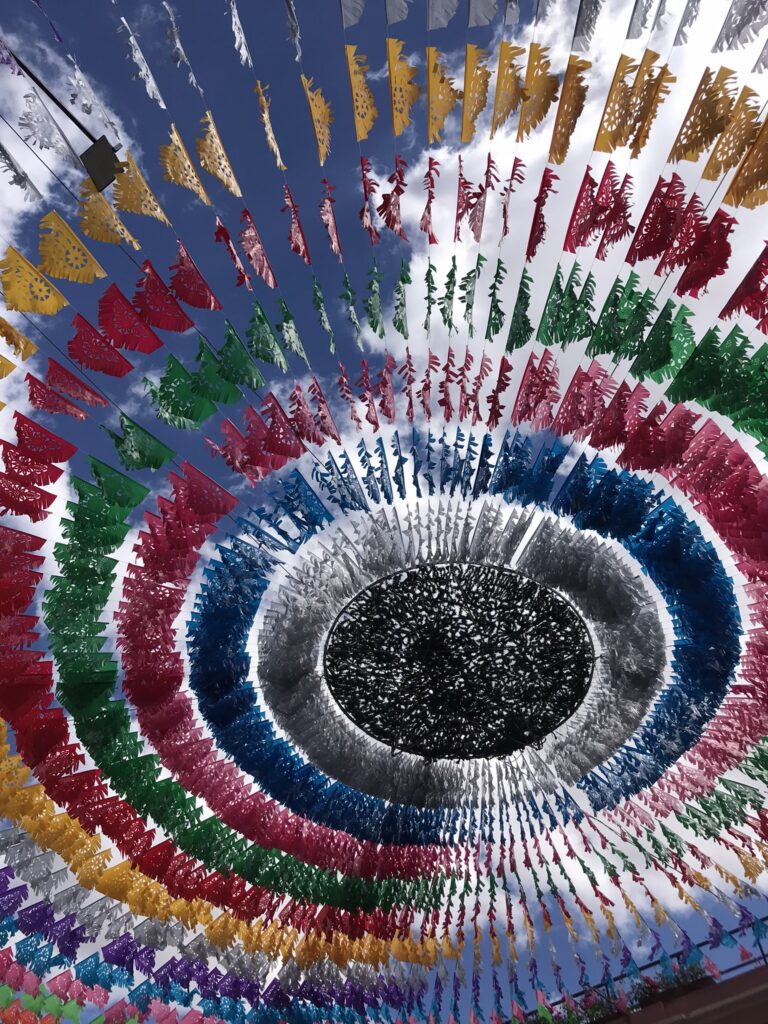
Mexico City, Tepoztlán, Morelia, Patzcuaro, Tzintzuntzan, Guanajuato, San Miguel de Allende, Queretaro, Puebla, Oaxaca, San Cristóbal de las Casas, Palenque, Campeche, Bacalar
When people think of Mexico, often the first thing that comes to mind is deserts and cacti. However in reality that is only one of the many diverse landscapes in Mexico. There are mountains, volcanoes, lakes, jungle and beach areas, as well as several geographically unique places. Mexico’s regional cities often have a storied history and distinct regional culture. Many of the Mexican city centres are UNESCO World Heritage Sites due to their colonial architecture and town planning. Outside of the cities, Mexico also benefits greatly from the ‘pueblos magicos’ initiative, a promotion of internal tourism by the Mexican government. There are nearly 200 small towns designated as pueblos magicos or ‘magic towns’, each with their own unique attraction, feature or local legend making them an interesting place to visit. The pueblos magicos receive funding from the government to ensure they have adequate facilities to welcome visitors, and they have strict standards to meet in return. We loved visiting the pueblos magicos, which were often vibrant places bursting with local culture and with few foreign tourists. There is at least one pueblo magico in each of the Mexican states, and in some areas there are dense concentrations of these magic towns to explore.
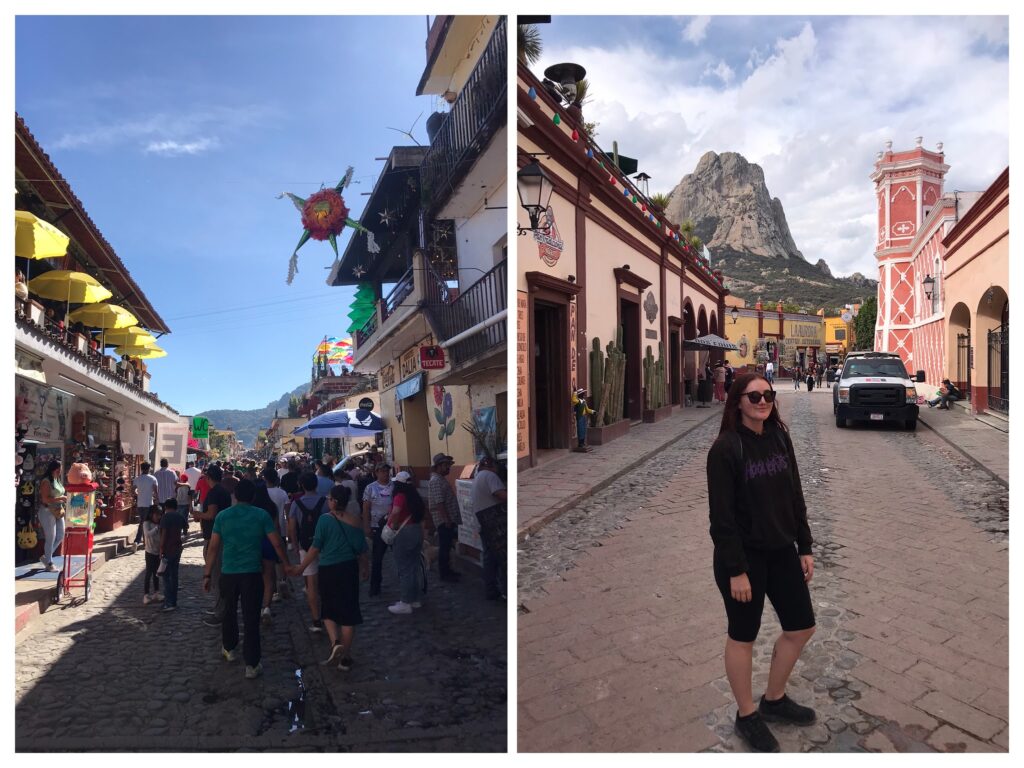
Two of our favourite pueblos magicos were Tepoztlán and Bernal
Mexican food, such as enchiladas, tacos and quesadillas, is popular throughout the world. However the Mexican food in Mexico is quite different to the ‘Mexican’ food you might find elsewhere. Most of the food in Mexico is made using corn tortillas, which gives a very different taste and texture to the wheat tortillas that are often used in foreign countries. Corn (or maiz) is impossible to avoid in Mexico. Before the arrival of the Spanish it was an essential native crop for the sustenance of the large population and the basis of a majority of indigenous foods. Corn had a borderline religious status in the region, ancient civilisations including the Aztec and the Maya worshipped a corn god. Today it can still be found in almost every meal. Sadly, we are not the biggest fans of corn tortillas. To be honest, we much preferred the tacos and quesadillas in our own country to those in Mexico because they were made using wheat rather than corn. On the few occasions that we were able to find wheat tacos in Mexico we jumped at the chance.
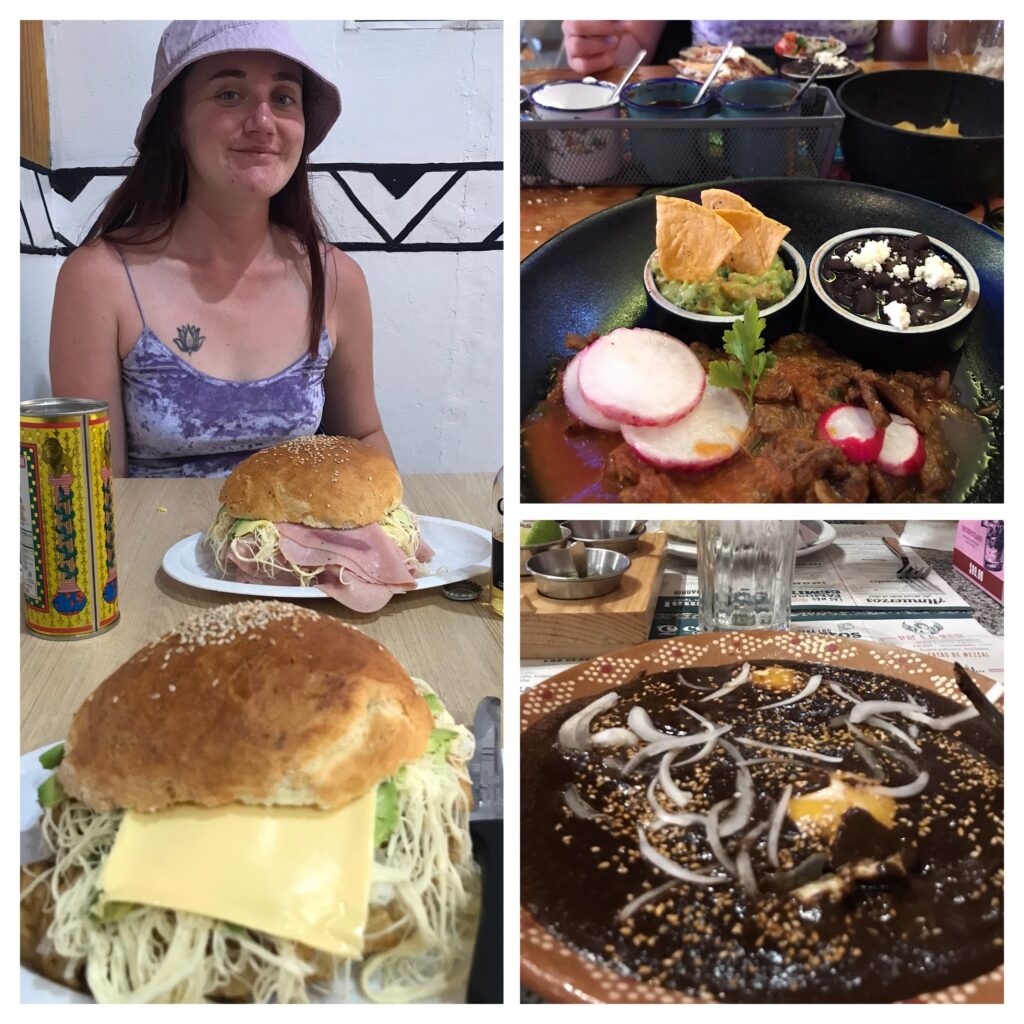
Each area has regional specialities such as cemita poblana in Puebla, mole in Oaxaca and cochinita pibil from the Yucatan region
As well as tacos, there are many other regional foods that are popular throughout Mexico but not as well known internationally, such as chilaquiles, mole and cochinita pibil. We found it interesting that burritos, considered a classic Mexican food by most people overseas, are actually not really all that popular in most of Mexico. They are only really consumed in northern parts of the country near the US border. Mexican cuisine is vast and varied, there are great culinary variations between different regions and states and one of the best things about travelling to a new state is trying the local specialties. There are also variations in liquor – Mexico is known worldwide for tequila but it is also the home of many other regionally-produced drinks and spirits such as mezcal, pulque and pox.
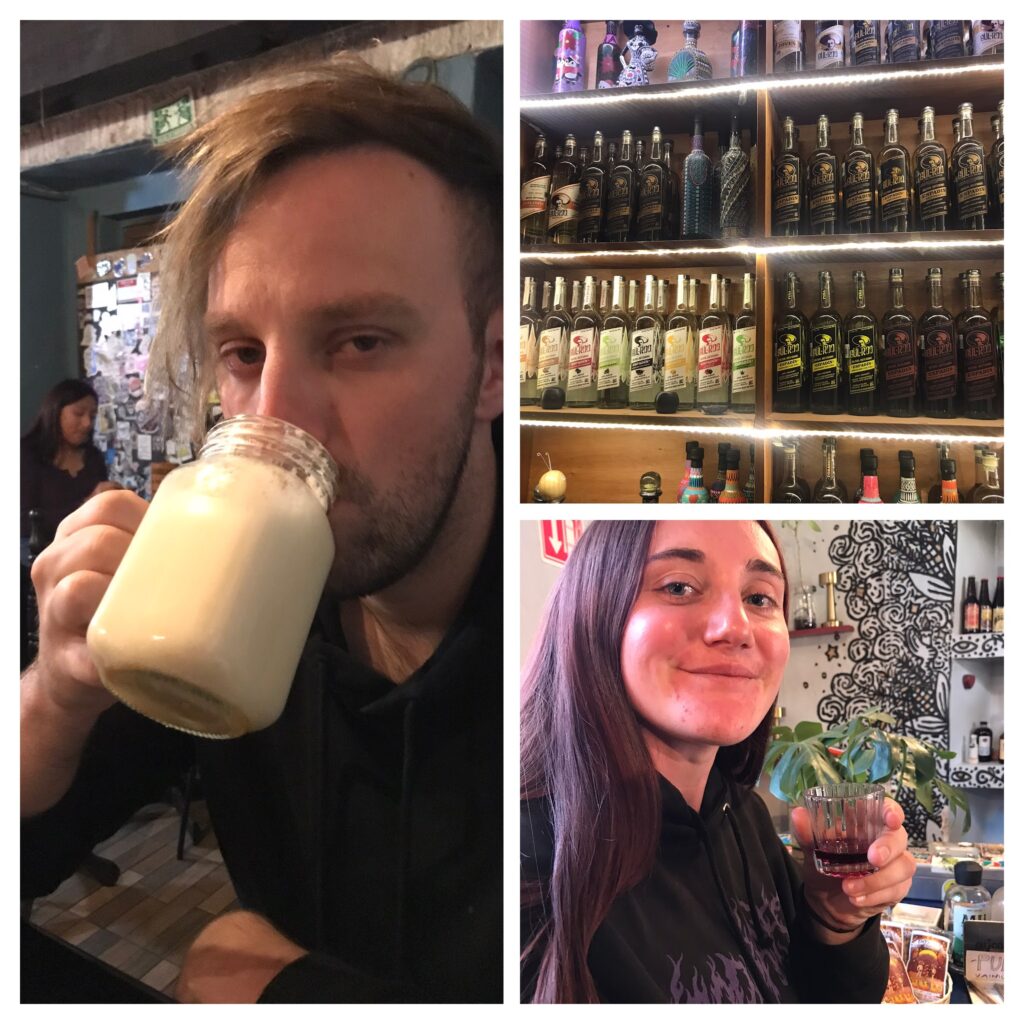
Sampling the local spirit: fruity pulque in Puebla, mezcal in Oaxaca and pox in San Cristobal de las Casas
The history of modern Mexico can be traced back to the early 1500s, when the Spanish conquistadors defeated the Aztec empire and colonised their capital city, which became Mexico City. The Spanish then established the territory as the colony of New Spain. Today the Spanish influence is evident in the many grand colonial cities and buildings that are present throughout the country. Indigenous populations were assimilated, creating the mestizo population that makes up most of the nation’s people today. The Spanish also brought Catholicism, which became a huge influence on Mexican culture. Almost every town and city in Mexico is centred around a colonial-style church, and the churches and cathedrals in Mexico are some of the most impressive in the world.
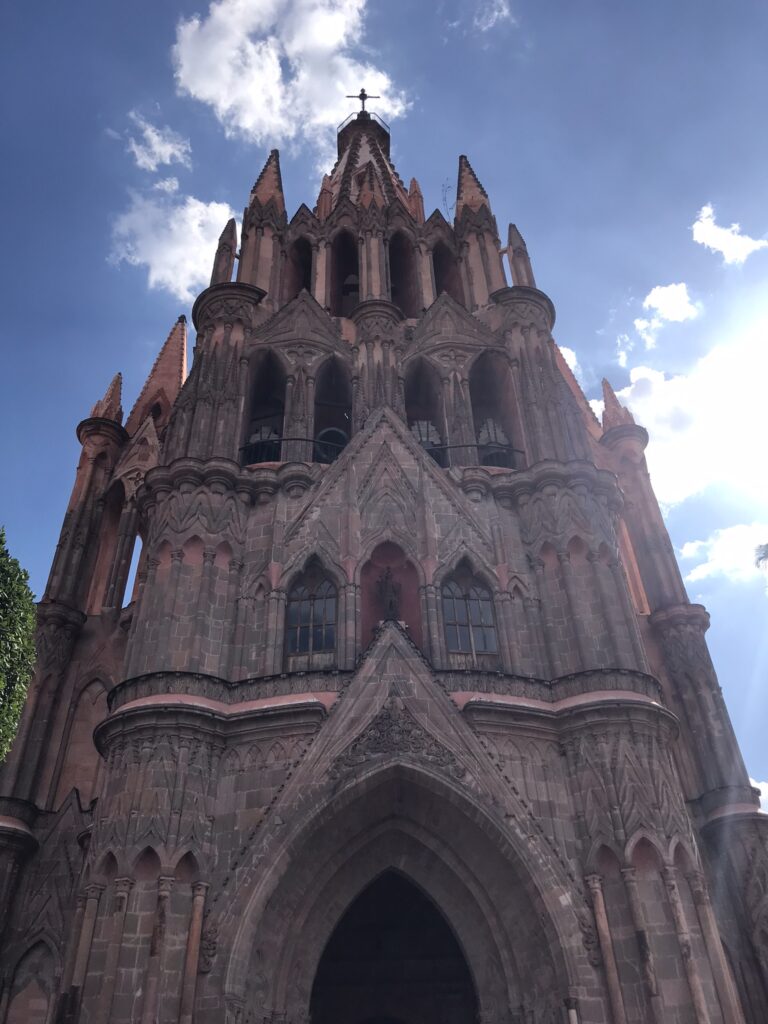
The Cathedral in San Miguel de Allende is a stunning example of European architecture in Mexico which was brought over by the conquistadors
After several hundred years of colonial rule, Mexico eventually got its independence from Spain in the 1820s following a protracted War of Independence. Many of the revolutionary figures involved in the independence movement are revered in Mexico, such as the likes of Hidalgo and Morelos who now have cities and states named after them. Following independence, Mexico had two short-lived monarchies, a period of instability in which it lost the area that is now the US state of Texas, a war with the USA in which it lost the area that is now the states of California and New Mexico, and a 35-year quasi-dictatorship ending in a revolution in the early 1900s. In modern years, Mexico has struggled with drug cartels and gang violence. The Mexican cartels are some of the most advanced and heavily armed non-military organisations in the world and many parts of the country are still considered dangerous no-go areas due to the cartel influence.
Mexico is possibly most famous for its pre-Columbian civilizations (before the arrival of the Spanish).The two best known are the Aztecs and the Maya. The Aztecs controlled an area in the centre of Mexico, while the Mayan territory covered the Yucatan peninsula in the east of the country and spread right down to Guatemala and Honduras. It is difficult to visit Mexico without seeing some reference to the Aztec or Maya cultures. Mexico is named after the Mexica people, which was another name for the Aztecs. Meanwhile, today many ethnically Maya people still live in the eastern parts of Mexico as well as Guatemala. Ironically, the indigenous Maya people have been historically maligned since the Spanish conquest and today many indigenous people in Mexico live in rural communities and suffer from economic hardship and poverty, a huge contrast from the days of the great Mayan cities.
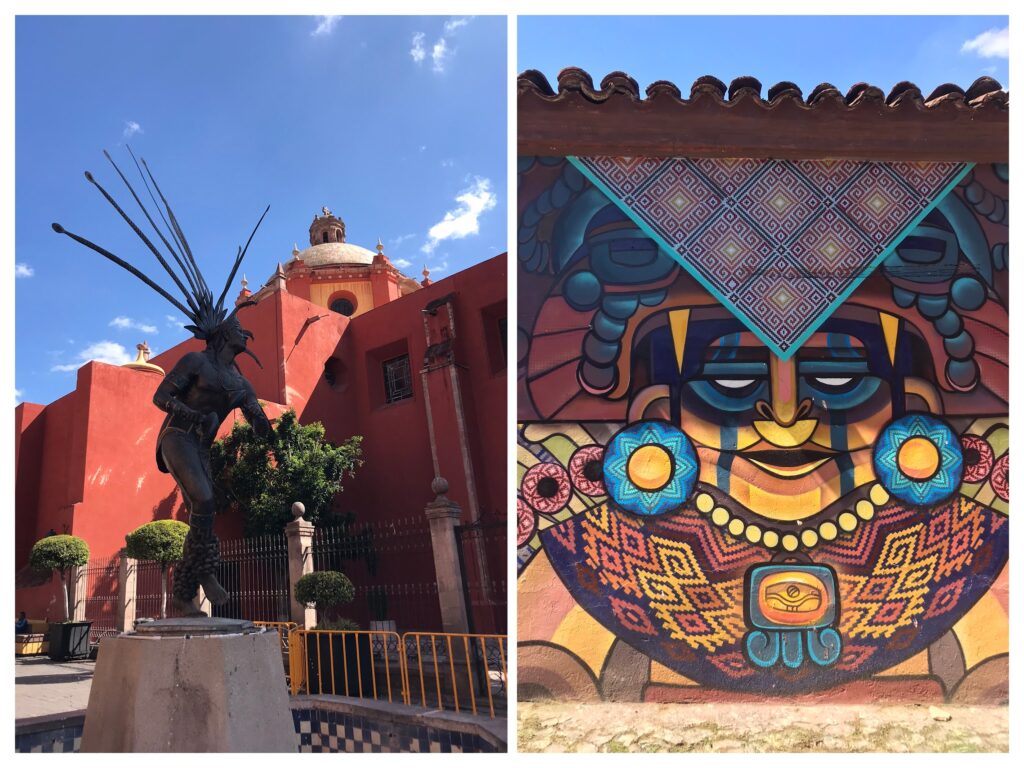
Mexican history is still very much present in cities, from El Danzante Conchero Chichimeca in Queretaro to Maya-inspired street art in San Cristobal de las Casas.
The Aztec empire was centred around Mexico City, which was previously known as Tenochtitlan. Unlike the Aztecs, the Maya were not a singular empire with one ruler, instead the Mayan civilisation was a collection of loosely-affiliated city-states. Many of the Mayan cities were reclaimed by the jungle and lay undiscovered for centuries.
Debunking the Maya Civilisation
The Maya civilisation was not one empire but was actually made up of many devolved city-states linked by a complex trade network, each with its own ruler and elites. Kingdoms rose and fell during the Maya epoch. These territories warred, built relationships and established trade with each other. Maya is a modern term used to categorise peoples with a shared language, religious and cultural traits from the Yucatan peninsula in Mexico, Guatemala, Belize and parts of Honduras and El Salvador. What we would call Mayans did not call themselves Maya or recognise any political unity or common identity.
Kingdoms within the Maya civilisation shared many commonalities such as architecture: major cities always included palaces, pyramid temples (in which common gods were worshipped), ceremonial ball-courts (the ball game was a ritual game which ended in the loser being sacrificed for religious purposes) and buildings used for astronomical observations (there was a strong emphasis on the importance of astronomical observations and calculations). Notable Mayan sites are Chichen Itza, Calakmul and Palenque in Mexico, Tikal in Guatemala and Caracol in Belize. The Maya civilization developed a complex system of hieroglyphic writing (which they used to record important dates and victories over enemies). They are credited with creating a distinctive calendar and practising ritual sacrifice to appease their gods (both auto-sacrifice or individual blood-letting and sacrifice leading to the death of another). Maya communities prized jade, obsidian and shells over all other natural materials. One by one, the city-states were eventually toppled by the Spanish conquistadors. Descendants of the Maya still live in the same areas as their ancestors, numbering over 6 million collectively in Mexico, Guatemala, Belize, Honduras and El Salvador and speaking around 28 Mayan languages.
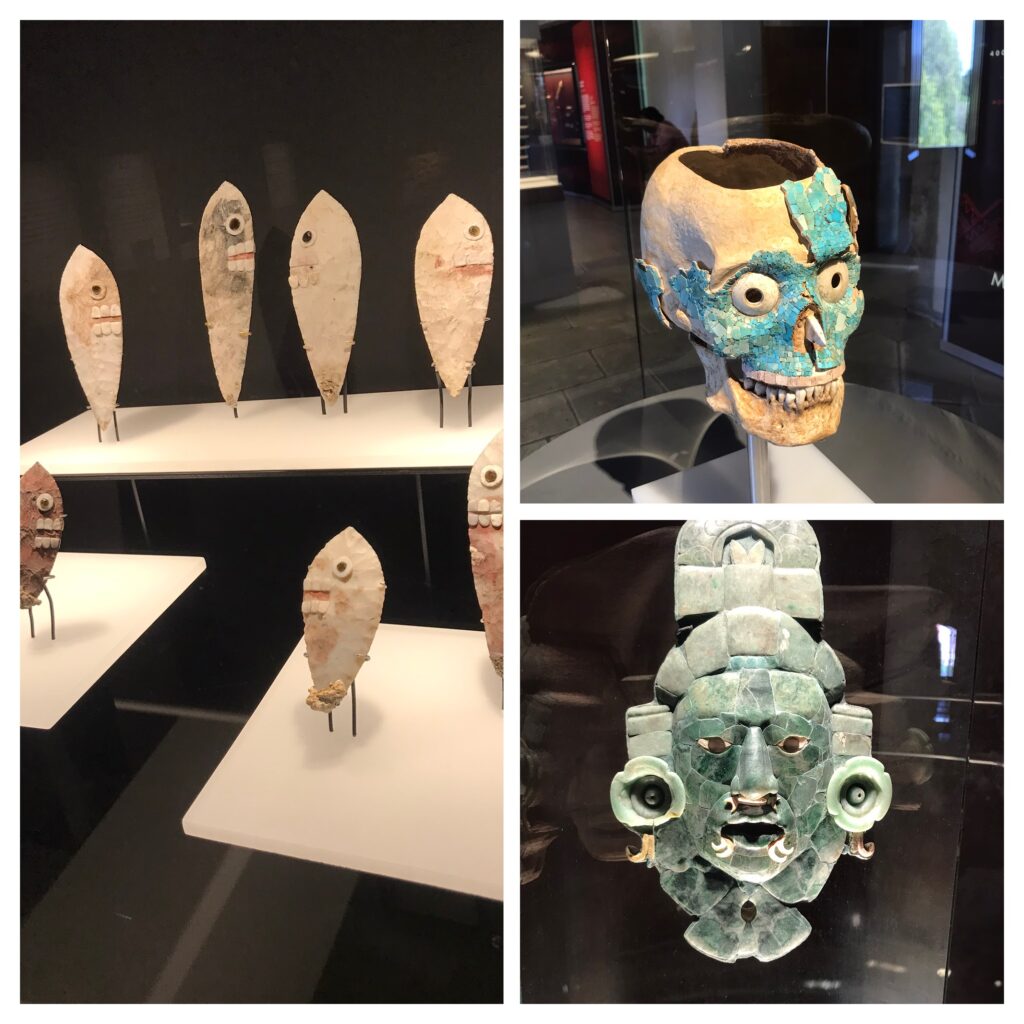
Shell blades displayed in the Museo Nacional de Antropología in Mexico City, jade mask (top) displayed in Oaxaca and another jade mask displayed in Campeche.
It is important to know that the Aztecs and Maya were not the only pre-Columbian civilisations in Mexico. Like the Incas in South America, the Aztecs were a relatively late arrival themselves and just happened to be the most powerful and organised group when the Spanish arrived. There were many different civilisations in different parts of the country over a period of more than a thousand years, with some such as the Purepecha in Michoacan state retaining a strong cultural identity to this day. Many other civilisations have been lost to time, while some left behind great archaeological ruins of their own before abandoning their cities for unknown reasons.
What is known is that Mexico contains some of the most impressive ruins in the world, a must-see for archaeology or history buffs. Even people with no interest in those subjects would surely be impressed by the grandeur of some of the archaeological sites. Lots of museums and sites are free for Mexicans on Sundays (sometimes we got away without paying too). Attractions will be very crowded on Sundays as a result.
Mexico City
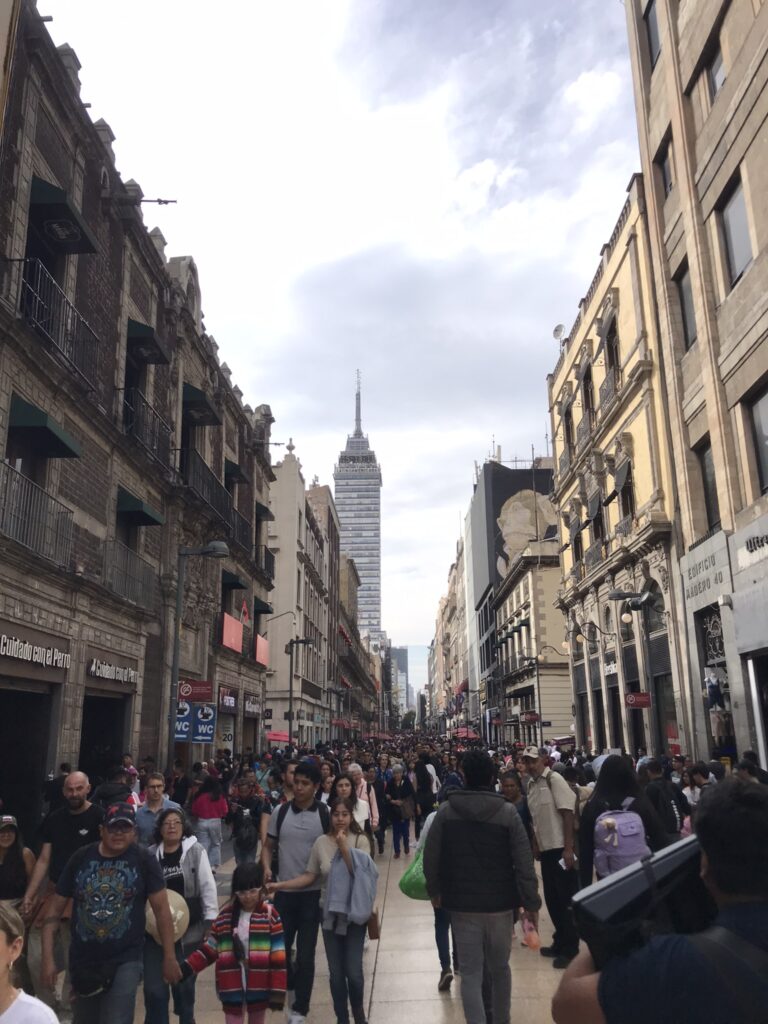
Mexico City is the largest city in North America, the cultural, spiritual and literal capital of Mexico. With so much to see and do, I struggled to fit everything onto one page! For my Mexico City content, check out this post.
Tepoztlán
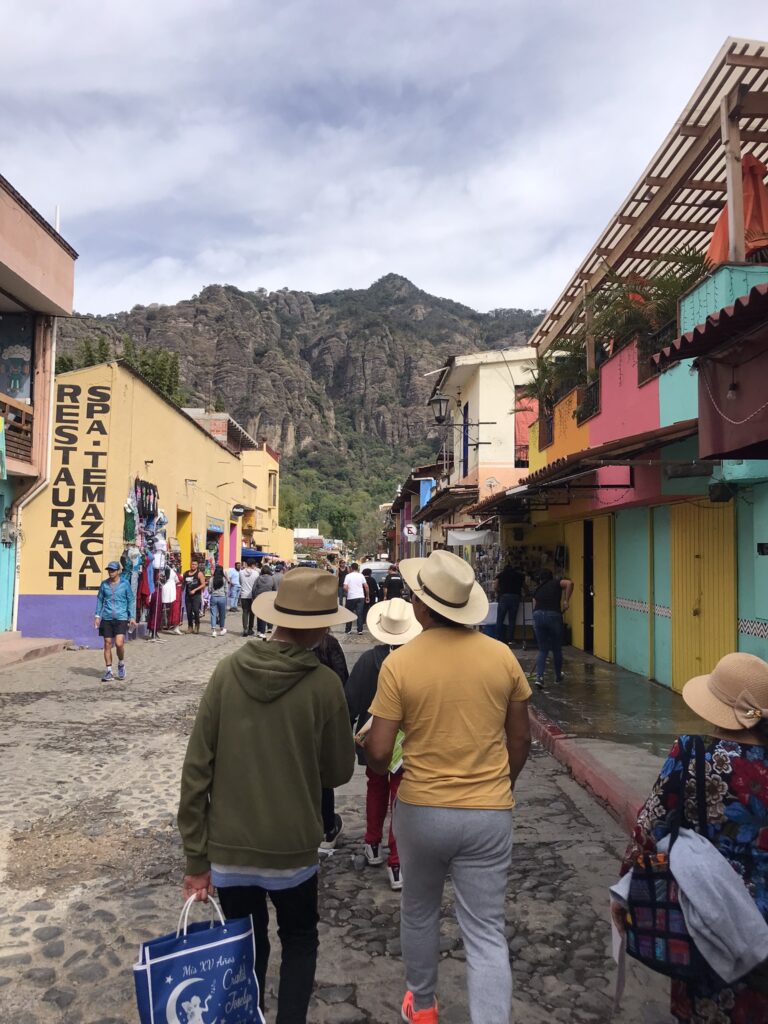
We took a day trip to the pueblo magico of Tepoztlán from Mexico City. It was easy to catch a bus to Tepoztlán from the Taxqueña terminal in the south of CDMX, which is easily accessible from all parts of the city by the metro. Be aware that there is another nearby pueblo magico called Tepotzotlan – this is not the same as Tepoztlán! Make sure you don’t end up in the wrong place. Tepoztlán is a small town in Morelos state, about one hour south of Mexico City in the volcanic mountain range surrounding the Valley of Mexico. The town is said by some to be the mythological birthplace of the Aztec snake god Quetzalcoatl. Today it is mostly known for the Tepozteco National Park, El Tepozteco archaeological site, a UNESCO World Heritage-listed monastery as well as the lively small-town vibe usually associated with the pueblos magicos.
We visited Tepoztlán on a Sunday and found there to be a festive atmosphere. The town comes alive at the weekend with colourful bunting, crowds of Mexican families and live music in the square. The place was packed and we saw very few other foreigners.
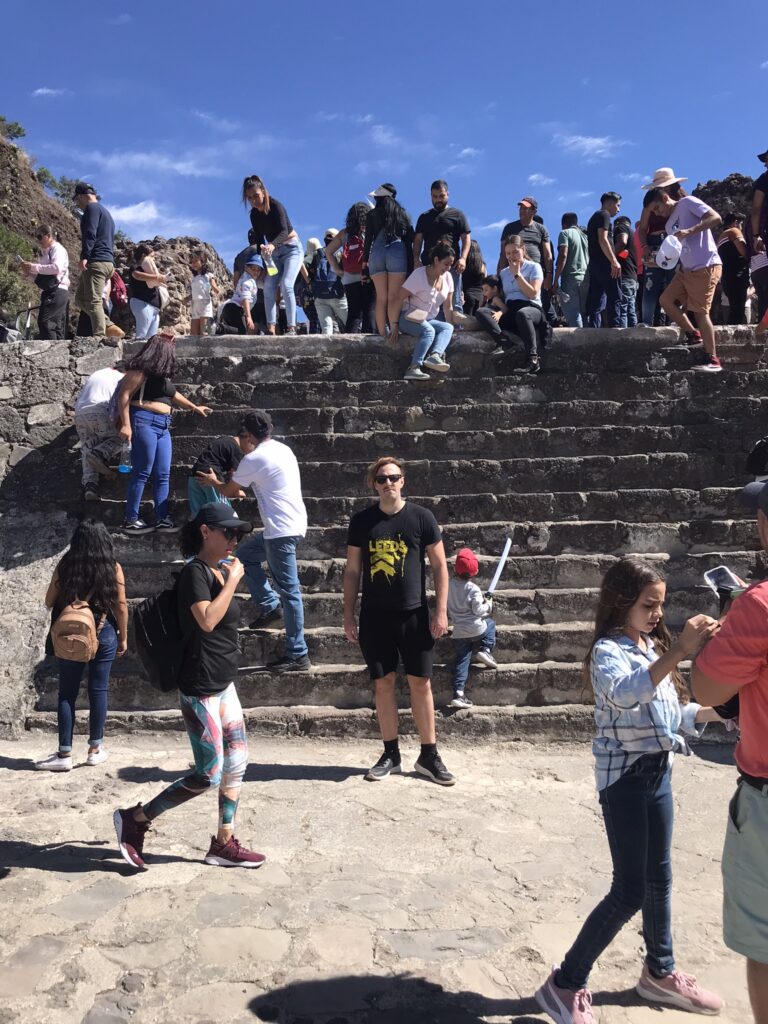
An accurate depiction of how busy El Tepozteco gets on a Sunday
Immediately after arriving, we headed for El Tepozteco to get the toughest part of the day out of the way first. El Tepozteco is an Aztec temple dedicated to the Tepoztēcatl, the god of pulque. The temple sits high atop a cliff, towering over the town of Tepoztlan. From the town, the ascent looks pretty daunting. The streets on the way to the start of the trail up to Tepozteco are lined with stalls selling handicrafts, souvenirs and alcoholic beverages. It’s a strenuous climb to the top but we saw couples with young children, mothers clutching babies and even elderly grandmas making their way up. With plenty of rest stops, we were able to make it without too much drama. There were some vendors stationed on the way up selling water, Powerade, chocolate, snacks and frozen ‘paleta’ ice-lollies, which were a great help when we were inevitably sweaty and overheated halfway up!
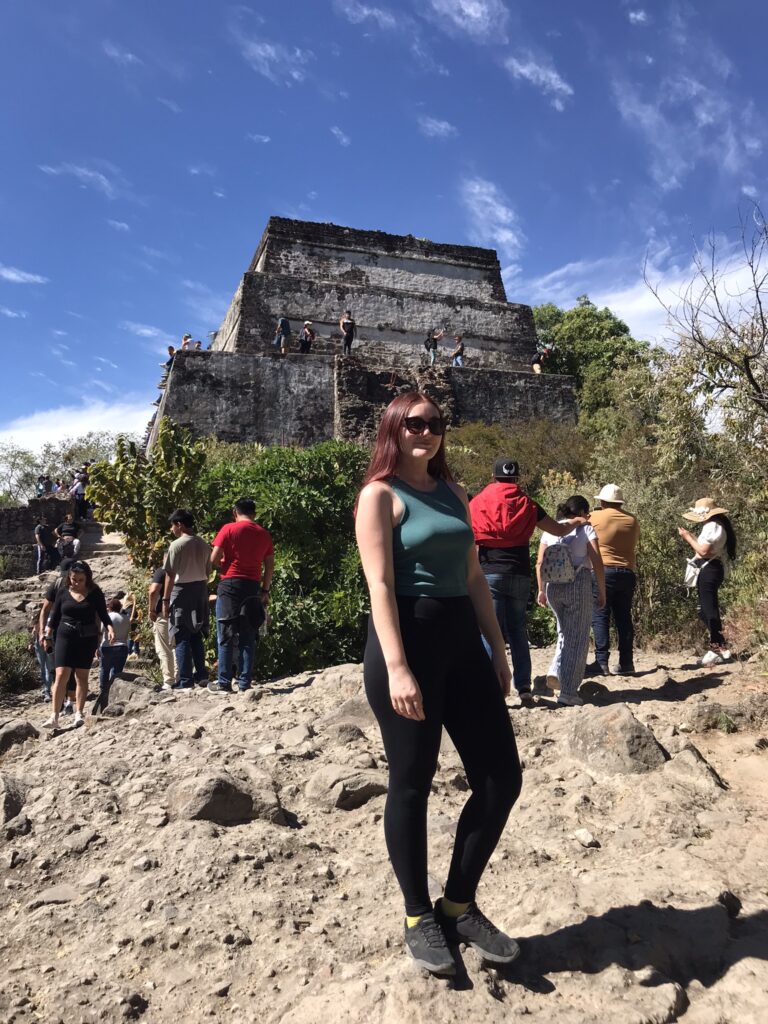
It seemed like everyone from Mexico city had descended on Tepoztlán for the weekend
I wouldn’t recommend the climb to people with a low fitness level who aren’t acclimatised to the altitude. Expect somewhat uneven terrain at points too. Bring plenty of water, suitable footwear and snacks. Also expect crowds at the weekend. Archaeological sites are free for Mexicans on Sundays, so when we arrived at the small temple it was really busy at the top with families crowding the stepped pyramid. On the plus side, we didn’t have to pay as the ticket guy had downed tools, probably not expecting to see any non-Mexicans there.
The temple and nearby plateaus provide stunning views over the valley. Keep an eye out for coatis nearby as they often scrounge for food in the area. They may look cute and friendly, but keep your distance as they scratch!
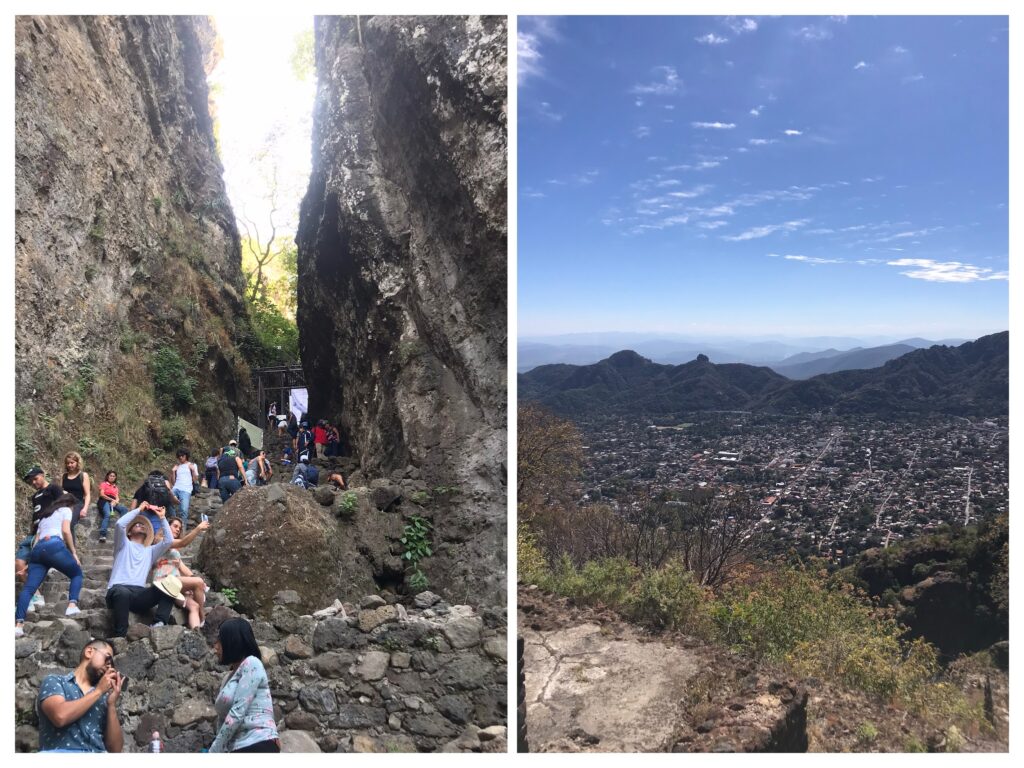
The hike up can be quite challenging but the view from the top is worth the effort!
Museo y Centro de Documentación, Ex Convento de Tepoztlán – this former convent (known as the ‘ex convent’ in the town) is part of the wider UNESCO World Heritage Site called Earliest Monasteries on the slopes of Popocatepetl. It is probably the most accessible of the 16 monasteries that make up this World Heritage Site, which are mainly located in small towns and according to UNESCO played a key role in the development of Christianity in Latin America. The interior walls of the convent are beautifully decorated with intricate designs in red pigment. You can even visit the original latrines in the convent. We found that admission to the convent was free when we visited on a Sunday – I’m not sure whether or not this is the case everyday.
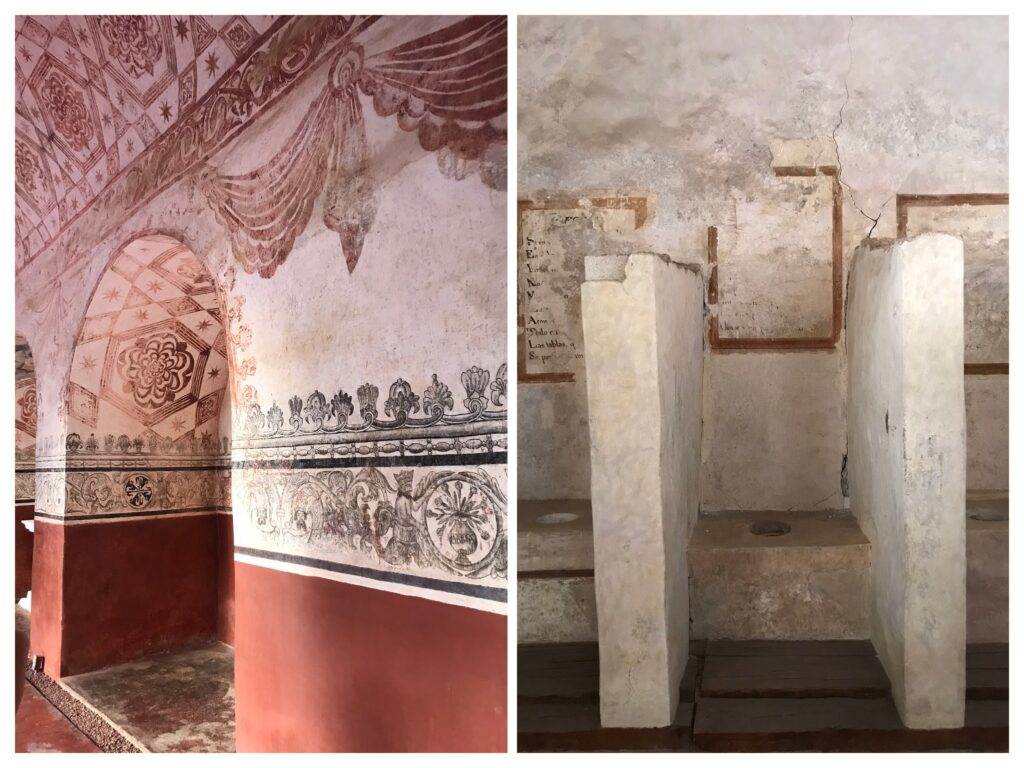
Don’t miss checking out the original toilets in the convent!
Foodie Places
There are many food options in Tepoztlán, both for sit-down meals and street food.
We couldn’t resist grabbing a choripan hot-dog from one of the on-street vendors, which was ridiculously tasty. However, the young server conveniently ‘forgot’ to bring our change as he was busy with the large crowds of customers.
Morelia
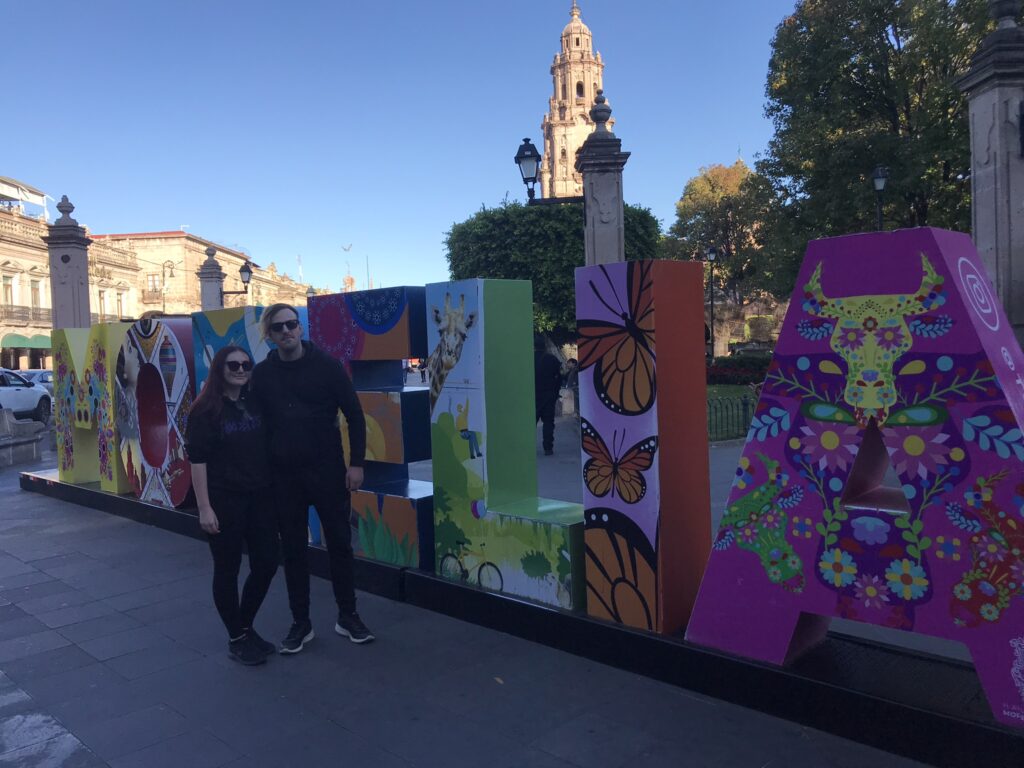
The capital of Michoacán state, Morelia is a city of exquisite churches and squares. Originally named Valladolid, the name of the city was changed in the 1820s in honour of Jose Maria Morelos y Pavon, a local man who became one of the heroes of Mexican independence. For some reason, Morelia is a less visited city – you’ll find it difficult to spot many gringos here. Morelia is a university town, the university here is claimed to be the oldest in the Americas dating back to the 1500s. The city has a youthful, vibrant feel with a surprisingly high prevalence of trendy coffee shops and vegetarian and vegan restaurants.
Accommodation
Hotel Casa José María – rooms in a stylish colonial house with an inner courtyard. We were in a room directly next to the main road at the front of the property, but we had no problems with noise or distractions.
Foodie Places
Super Vegetariano – a vegetarian buffet open at lunchtime, a great option if you want to fill up for very little money.
Onix Restaurant Bar – a cool place to sip beer and people watch. This was one of several restaurant/cafes directly overlooking the Plaza de Armas.
Activities
We took a stroll around the city to admire the architecture. The main attractions are the city’s colonial churches, which are impressive even by Latin American standards. Even if you think you’re all churched-out, the churches in Morelia are worth a look!
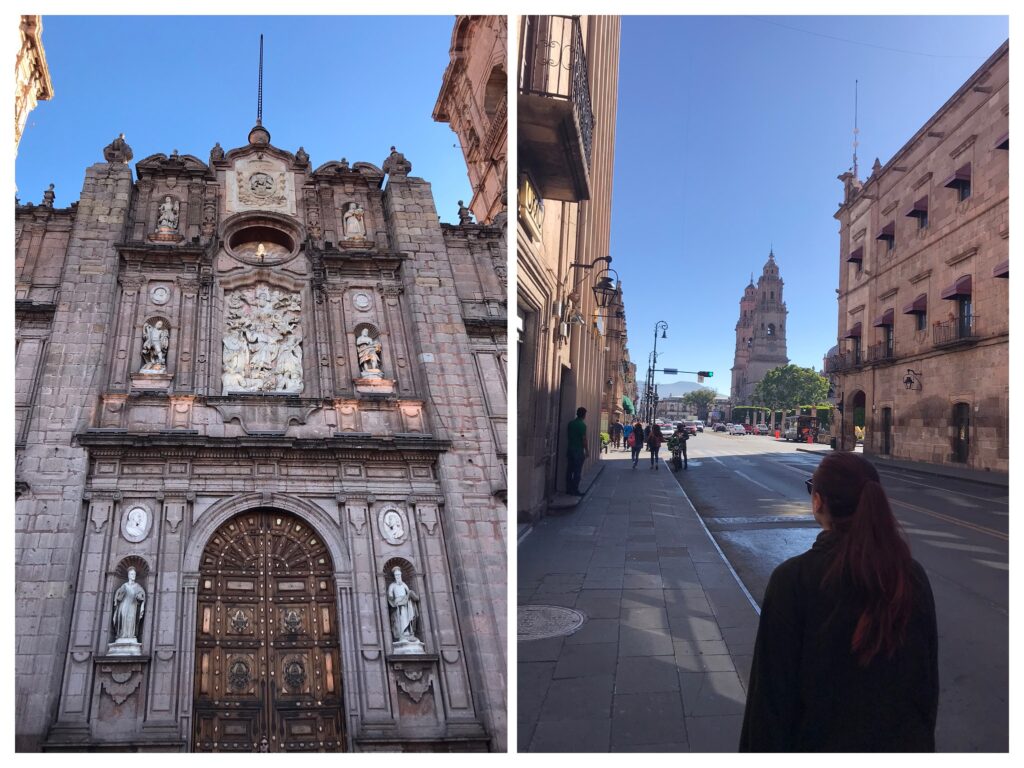
Churches, churches and more churches in Morelia
Morelia Cathedral, the centrepiece of the Plaza de Armas, is a grand colonial cathedral with a unique pink hue. Other notable sites in the city are the Jardín de las Rosas, Plaza de Armas, Templo de San Francisco de Asís, Plaza de San Agustin, Templo de Santa Rosa de Lima (close to the Garden of Roses), Biblioteca Pública Universitaria y Fondo Antiguo (university students congregate in the gardens with books from the library clutched in their arms, a meeting point for young crowd).
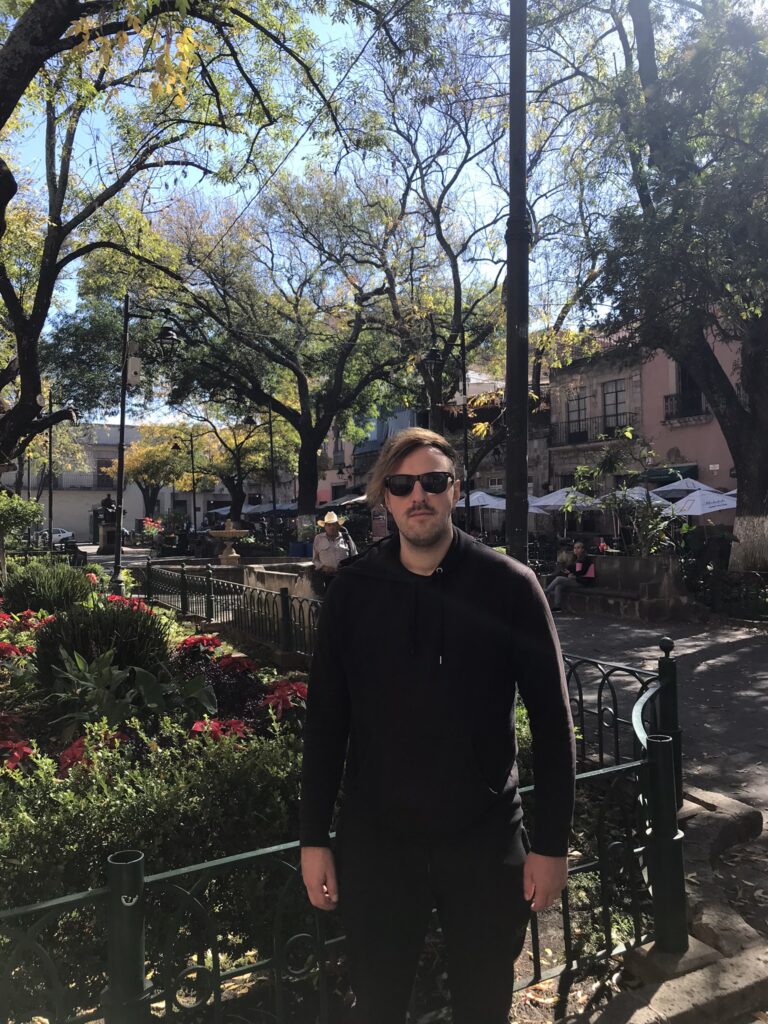
Garden of the Roses is a great place to watch the world go by with a good book
Museo Casa Natal de Morelos – we stumbled upon this museum whilst walking around Morelia. Entry is free. This colonial house was the birthplace of the illustrious revolutionary José Maria Morelos. Morelos was a priest who became a key figure in the Mexican War of Independence, leading the independence movement from 1811 until he was captured and killed by the Spanish in 1815. Morelos is considered a national hero and one of the founding fathers of the nation of Mexico. The museum contains information and memorabilia about Morelos, his life and his contributions to the independence effort.
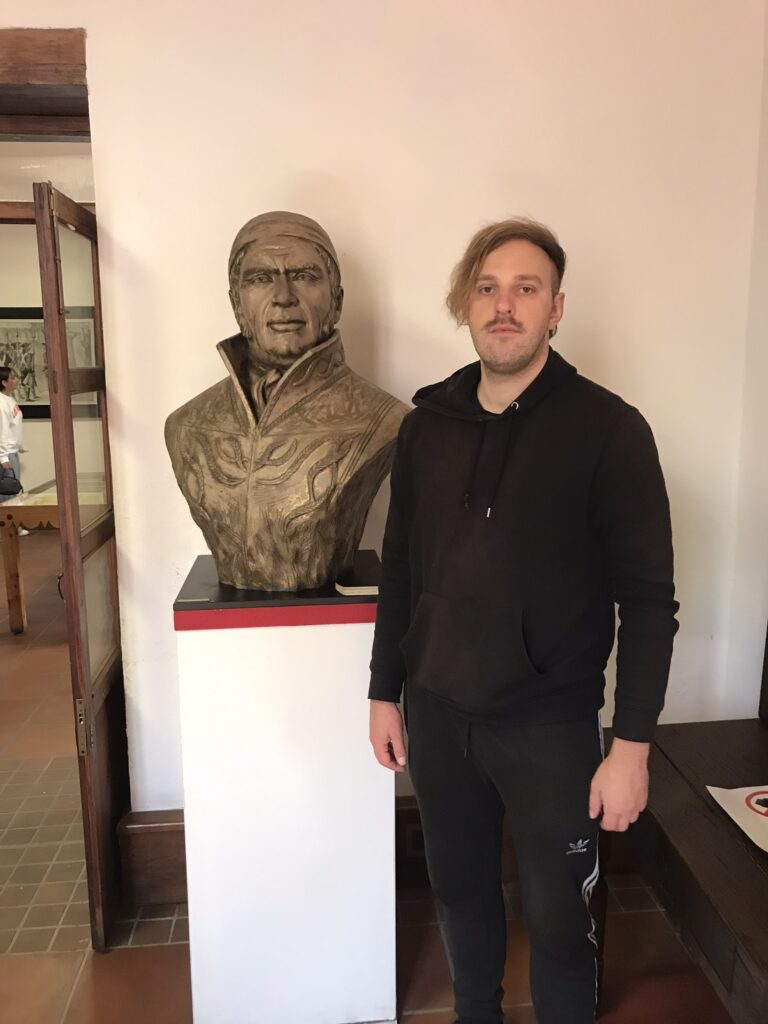
Dan and a sculpture of the revolutionary hero, Morelos
Patzcuaro
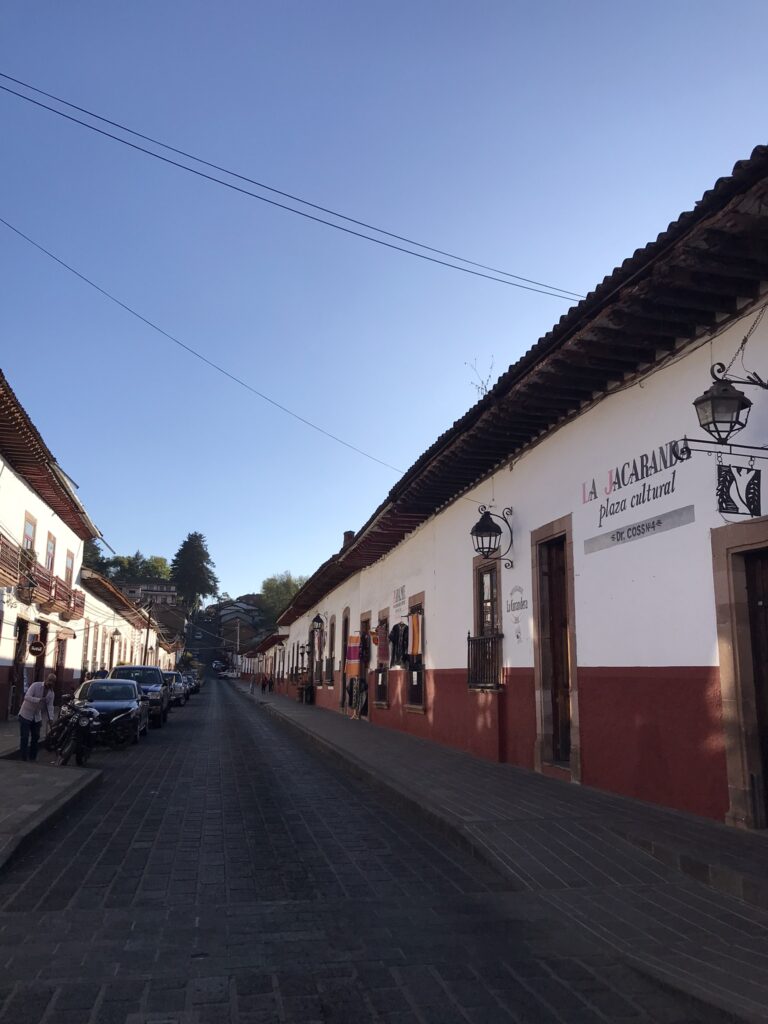
Patzcuaro is a picturesque pueblo magico in Michoacán state. The buildings in the town all follow a uniform architectural style, right down to the shop signs which have to use the same font/style for the business name, even Starbucks. This makes the town extremely photogenic, we enjoyed taking photos of the streets with the perspective effect created by the uniform buildings. Plaza Vasco de Quiroga, the town’s main square, is one of the biggest town squares in Mexico, second only to the Zocalo in Mexico City. The plaza is home to many upmarket restaurants and trendy cafes, but be aware that these fancy establishments come with high prices. Patzcuaro is a popular tourist destination for Mexicans however it still seems to be a little off the beaten trail for foreigners, we saw very few gringos around.
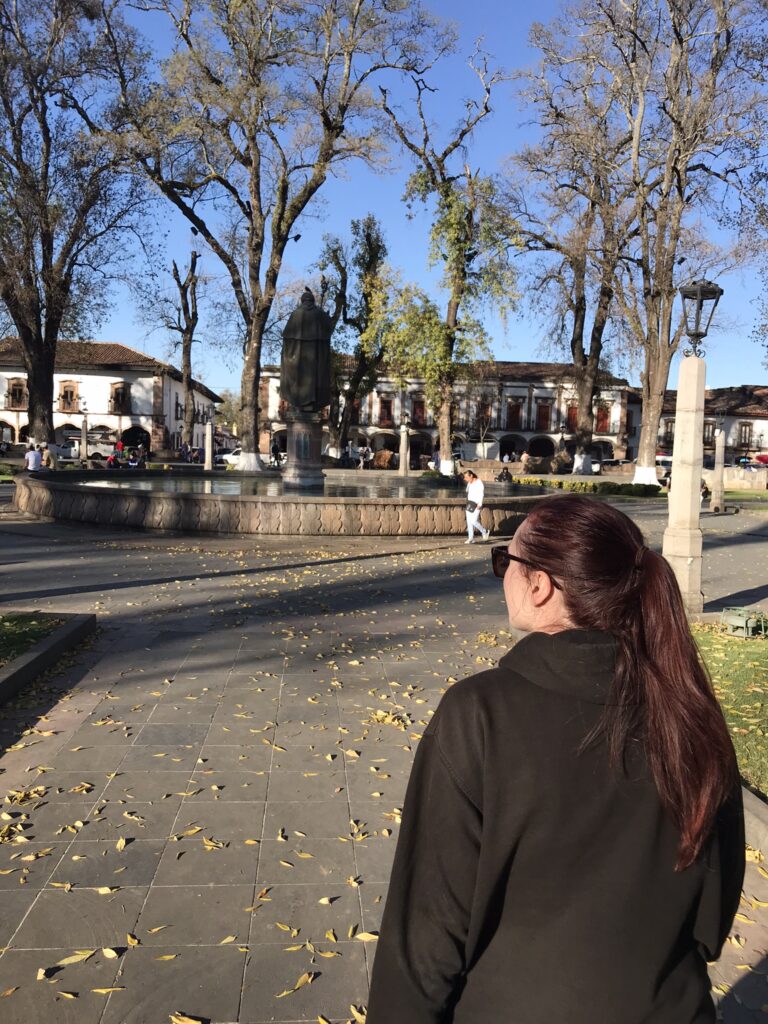
The only gringo in Plaza Vasco de Quiroga
You can get buses to Patzcuaro from the main bus station in Morelia, or from the Xangari bus stop in Morelia located here. The bus we took to Morelia was operated by a local company and was more like a chicken bus, with cramped seats and loud Mexican music playing over the speakers. The intercity buses drop off at the main bus station in Patzcuaro, which is 20 minutes walk from the town centre. There are also microbuses which run from the bus station in Patzcuaro to the town centre and back for those who don’t fancy the walk. Microbuses are a big deal here, running from Patzcuaro to many of the small regional towns and hamlets nearby and providing a vital public transport service for the local people.
Patzcuaro has an interesting history as this region was the home of the Purépecha empire, a civilisation which rivalled and successfully fought off the Aztecs before submitting to the Spanish crown without a fight following the Spanish conquest of the Aztec Empire. The Purépecha identity is still strong in the region, and you can find many unique foods and cultural elements here relating to the local Purépecha heritage. Patzcuaro is also known throughout Mexico for its Day of the Dead celebrations. The celebrations around Lake Patzcuaro are some of the largest and most renowned in the country.
Accommodation
OYO Posada De Los Angeles – a good place to hunker down close to the town centre. We spent a day here confined to our beds, recovering from severe food poisoning. The accommodation was incredibly cheap with private en-suite rooms. It was pleasant to sit outside the room in the courtyard garden and read while Dan was puking into the bin. Even though this hostel is part of a chain, it’s owned and run by a family that live in the adjoining house. The reception area led into the families’ living room, which was a little strange, but you get used to this quirk very quickly.
Foodie Places
La Casa De Las 11 Pizzas – a good choice if you’re looking for a budget meal in the town centre. We appreciated the comedy name. It’s also the cheapest place in the main square, although it’s not the easiest to find as you have to go through a small passageway from Plaza Vasco de Quiroga. The pizzas here are huge! Believe me, when it says ‘grande’ it actually means it!
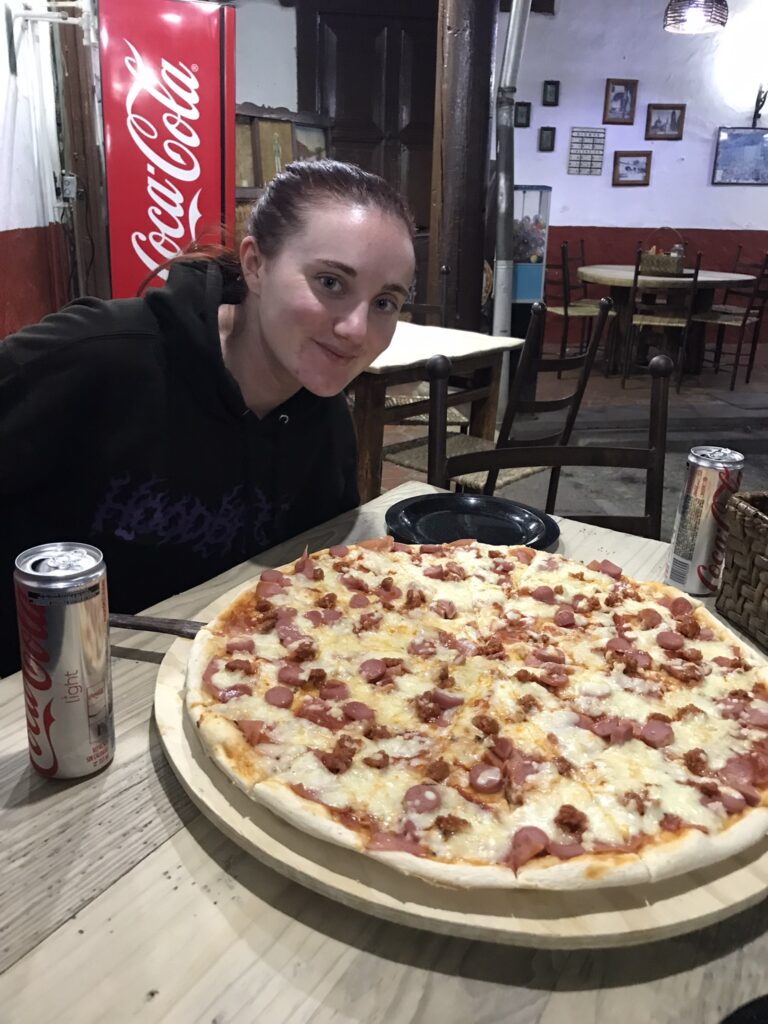
It’s safe to say we underestimated the size of the pizzas at La Casa De Las 11 Pizzas
La Surtidora – Surprisingly affordable and in a prime location in Plaza Vasco de Quiroga. I couldn’t get enough of the club sandwich here, I ended up having a club sandwich two nights in a row. Be aware that a waiter tried to short change me here, I suspect it was because I was alone and not with Dan – another perk for lone female travelers!
Loretta café Colonial – nice café, prices are higher than average due to the prestigious location in the main square. The café offers outdoor seating under the portico. This is the place to be seen for more affluent residents. We thoroughly enjoyed our Oreo frappe with whipped cream, just what we needed to relax after exploring the city.
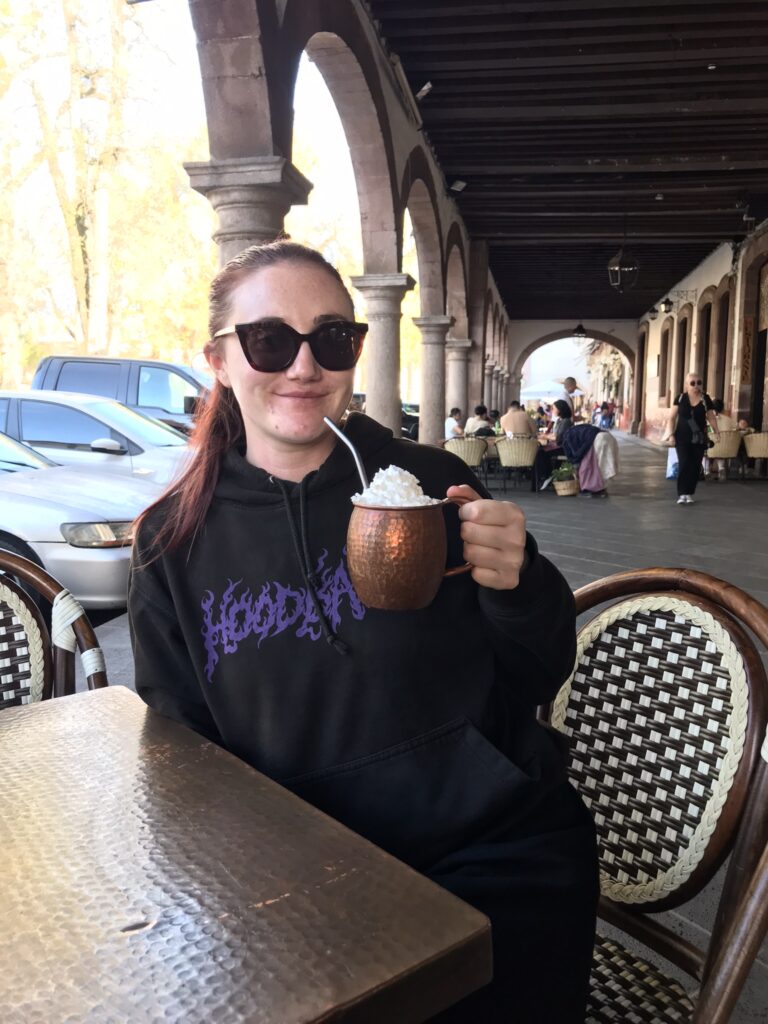
Head to Loretta café Colonial for an indulgent oreo iced frappe!
For street food head to Plaza Gertrudis Bocanegra, also known as Plaza Chica. Here you will find an array of women slaving over the grills.
Activities
Just walking around town is an activity in itself due to the array of interesting buildings and architecture. The main sights we found were Plaza Vasco de Quiroga, Parroquia del Santuario de Guadalupe, Centro Cultural Antiguo Colegio Jesuita and Templo de El Sagrario. The Templo de El Sagrario is a picturesque church with especially poignant signs of ageing, the exterior walls looked very old/worn which added to the unique character of the building. We often see churches that have been beautifully restored so it was refreshing to see one that wasn’t.
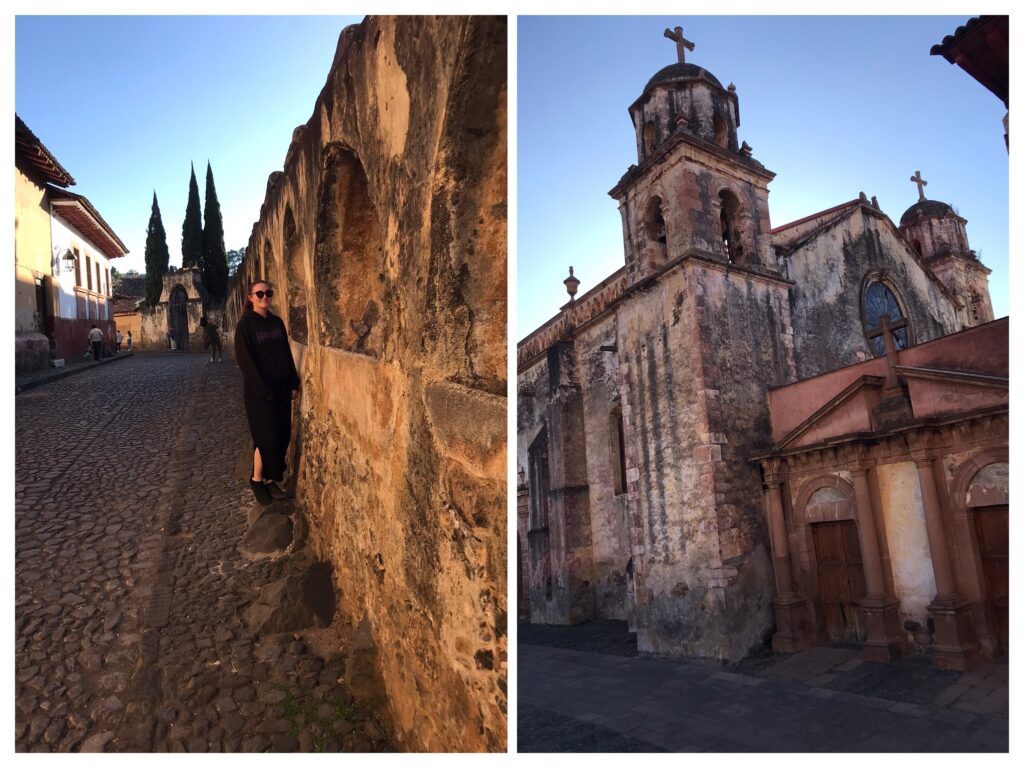
Head to Templo de El Sagrario at sunset for beautiful photos of the church and grounds
Casa de los Once Patios – known for once having 11 courtyards, this former convent building is now open to the public and entry is free. Some of the courtyards contain little art studios and craft shops for visitors to browse around.
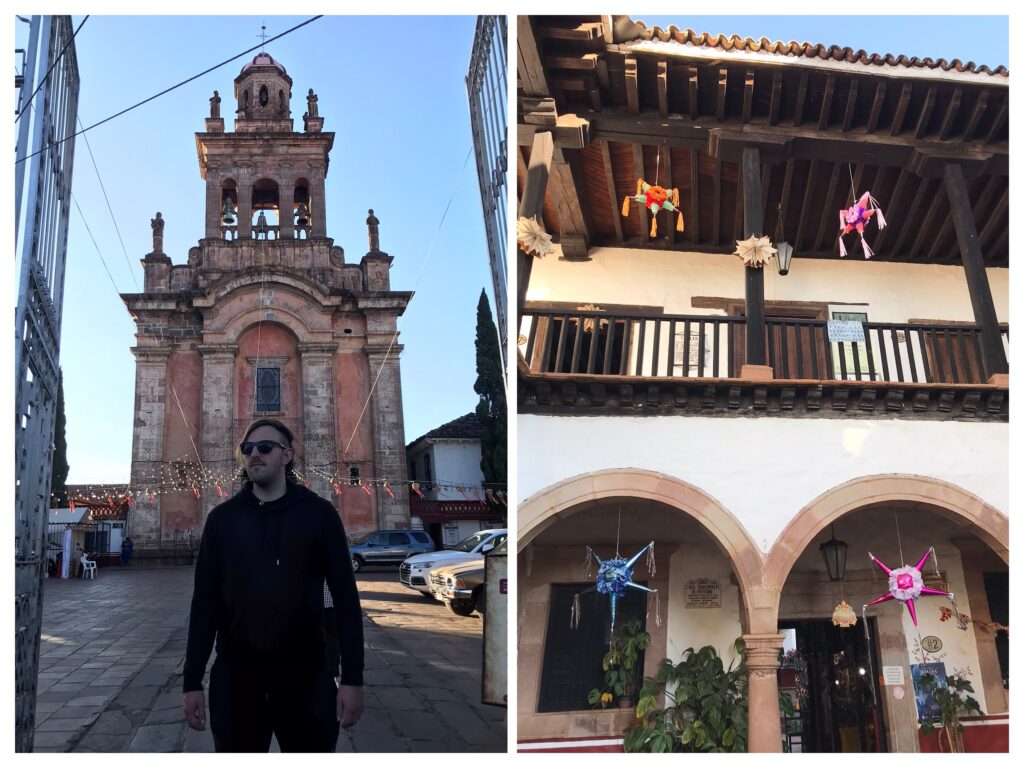
Parroquia del Santuario de Guadalupe and Casa de los Once Patios are two great spots to visit in Patzcuaro
Day trip to Janitzio – Janitzio is the largest island in Lake Patzcuaro, a densely-populated mound rising out of the lake atop which sits a huge statue of the Mexican independence hero Jose Maria Morelos. The boat to Janitzio departs from Muelle General pier. You can get a colectivo to the pier from the centre of Patzcuaro, or walk if you have time and are feeling energetic. Tickets for the boat can be bought at the pier.
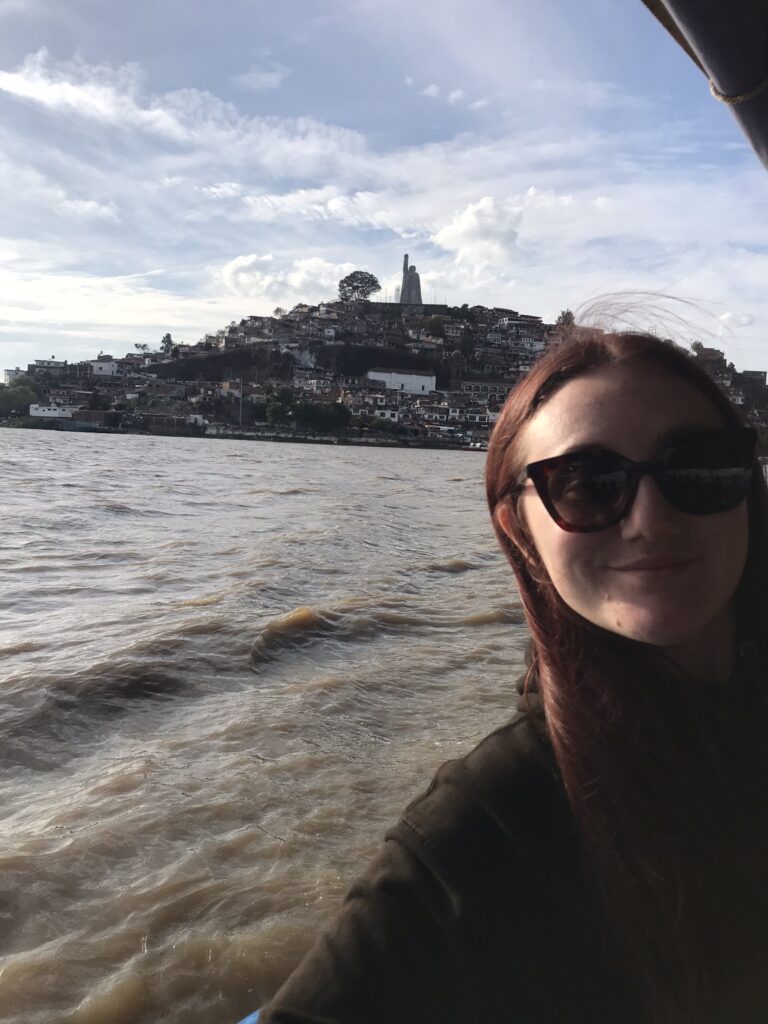
Janitzio is an eye-opening place. Previously known for its butterfly-net wielding fishermen, this industry has all but died out and the people of the island-town now rely solely on tourism for their livelihood. Some fishermen may still perform a display with their nets, but this is purely for tourists. There is very little for them to actually catch in the lake. Despite this, the people of the island still try to keep the illusion alive. I can still vividly remember the smell of fried white bait sizzling away in oil, very stinky and off-putting. Don’t eat the fish, the lake is very polluted and there are basically no fish left there.
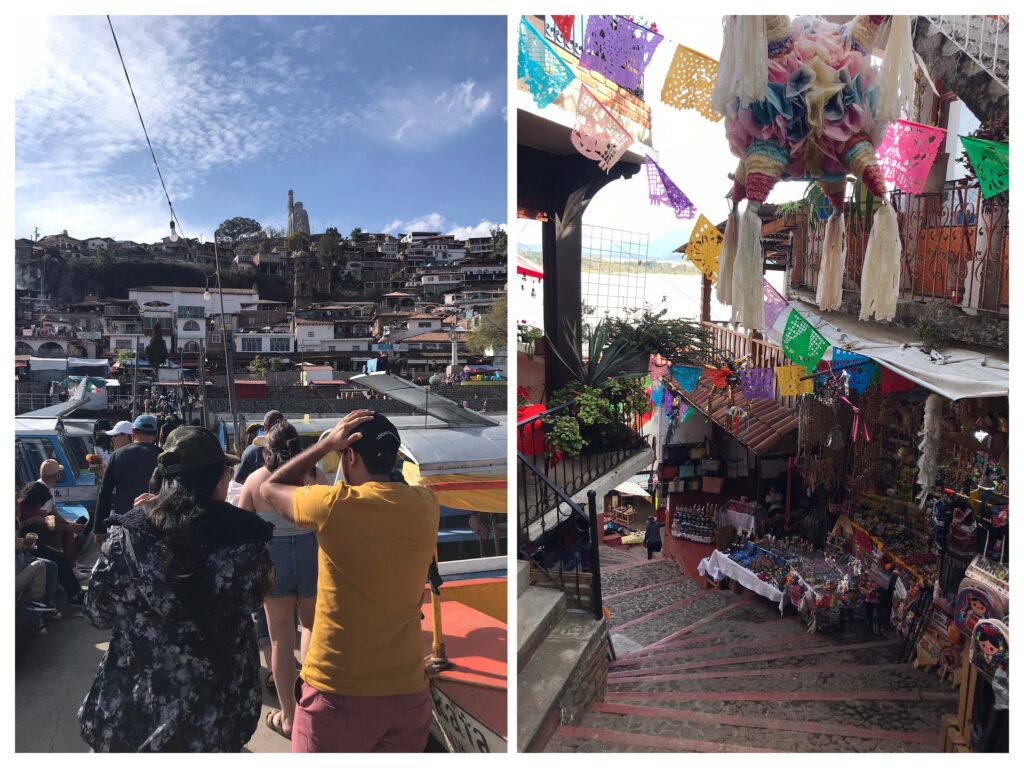
Janitzio is a densely populated island on Lake Patzcuaro
The main attraction on the island is the huge statue of Morelos at its centre. Morelos is depicted with a revolutionary raised fist, a pose it is unlikely he ever actually made in real life as he was a priest. The monument is hollow and you can climb to the top of Morelos for the best views over the lake. It can be quite windy at the top so hang on tightly. The inside of the statue is covered in interesting murals and depictions of Morelos’ life. There is a small entry fee to get into the area surrounding the statue, but this is a nice plaza with bathrooms and restaurant facilities along with benches where you can relax and enjoy the views over the lake.
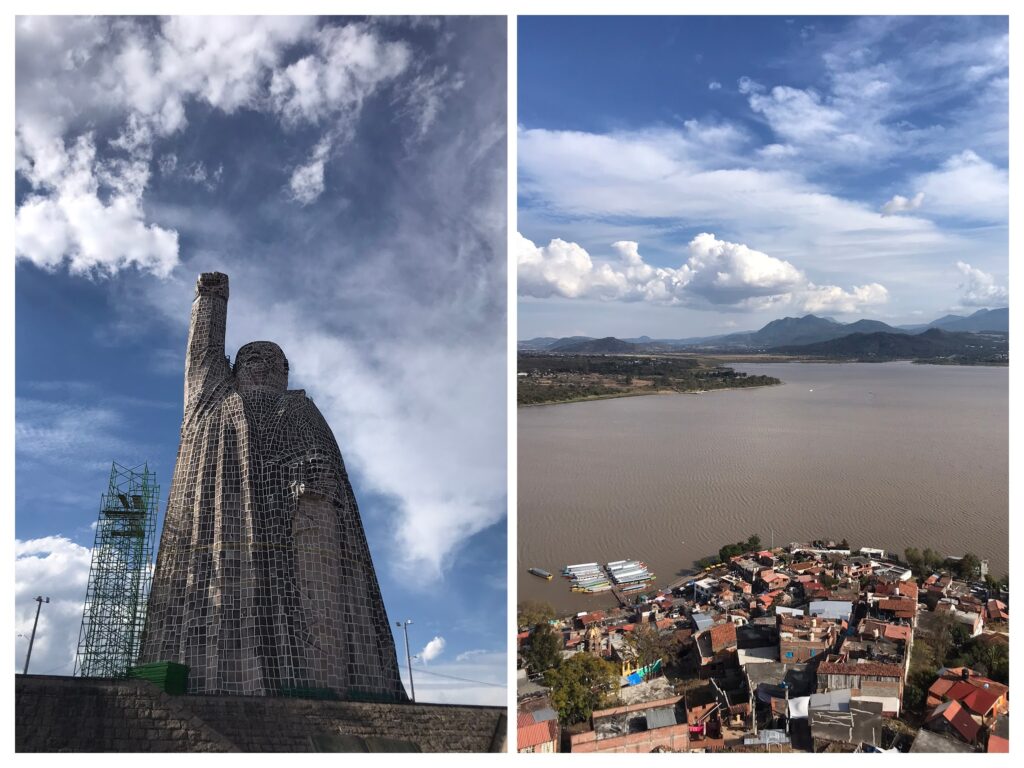
Climbing the statue of Morelos is the number one thing to do on the island
Tzintzuntzan
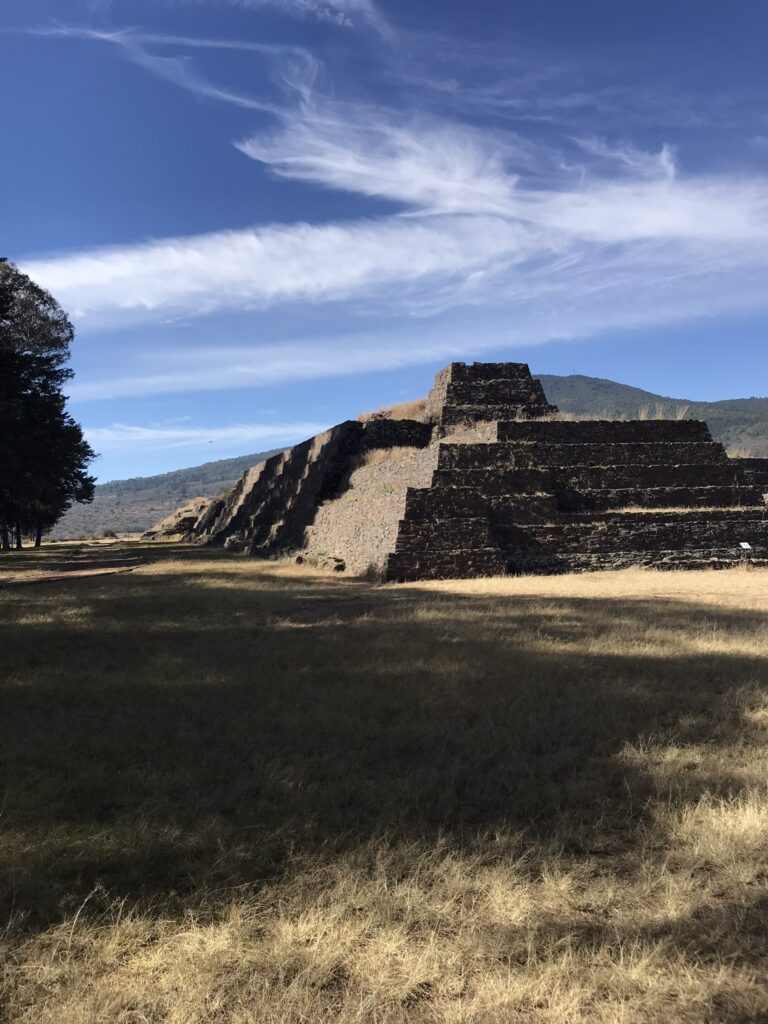
If you’re a history buff and looking for an adventure, look no further than Tzintzuntzan. Tzintzuntzan is another pueblo magico located close to Patzcuaro. It is notable for being the original capital of the Purépecha civilization, and today it is also known throughout Mexico for its participation in the region’s Day of the Dead celebrations.
To get to Tzintzuntzan, you can take a colectivo microbus from the centre of Patzcuaro. We found very little exact information online about getting to Tzintzuntzan using public transport, and it was trial and error to find the correct place to be picked up. We eventually jumped into a passing colectivo which had a sign for Tzintzuntzan at Biblioteca publica Gertrudis Bocanegra, located around here (19.516520713371012, -101.60855281239182). The colectivos don’t really have a proper stop and there is no obvious place to wait or embark, but they should all pass through here and you can flag one down if it displays a sign that it is going to the right place. The colectivos to Tzintzuntzan seemed to depart very irregularly, you might have to wait 5 minutes or even an hour for the correct vehicle. Be aware that several other towns in the region have similar names, you need to make sure your colectivo is going to Tzintzuntzan!
The small town itself is worth checking out, with plenty of interesting craft stalls and some nice places to eat. However the town is mainly known for the nearby archaeological site, which is also called Tzintzuntzan.
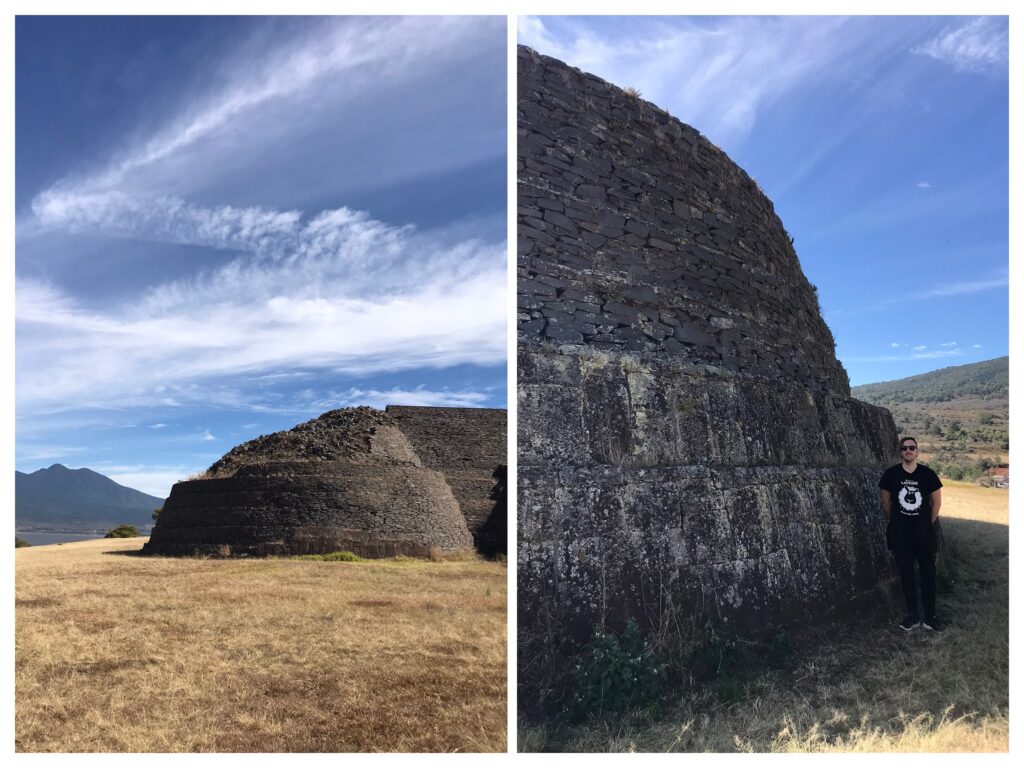
Check out the Yacatas (round structures) at Tzintzuntzan
After being dropped off by the colectivo in the town of Tzintzuntzan, the archaeological site is a short walk up the hill. This place was a treat and the opposite of many of the crowded archaeological sites in Mexico. As the only visitors, we practically had the whole site to ourselves except for a friendly dog and the occasional security guard. The Yacatas (round stone buildings) are incredibly unique and a stark contrast to the usual stepped pyramids in the Aztec and Mayan sites. A marvellous architectural feat. Keep an eye out for inscriptions and spirals carved into some of the rocks around the site. We really liked this blog post, which provides more information than the plaques situated around the site.
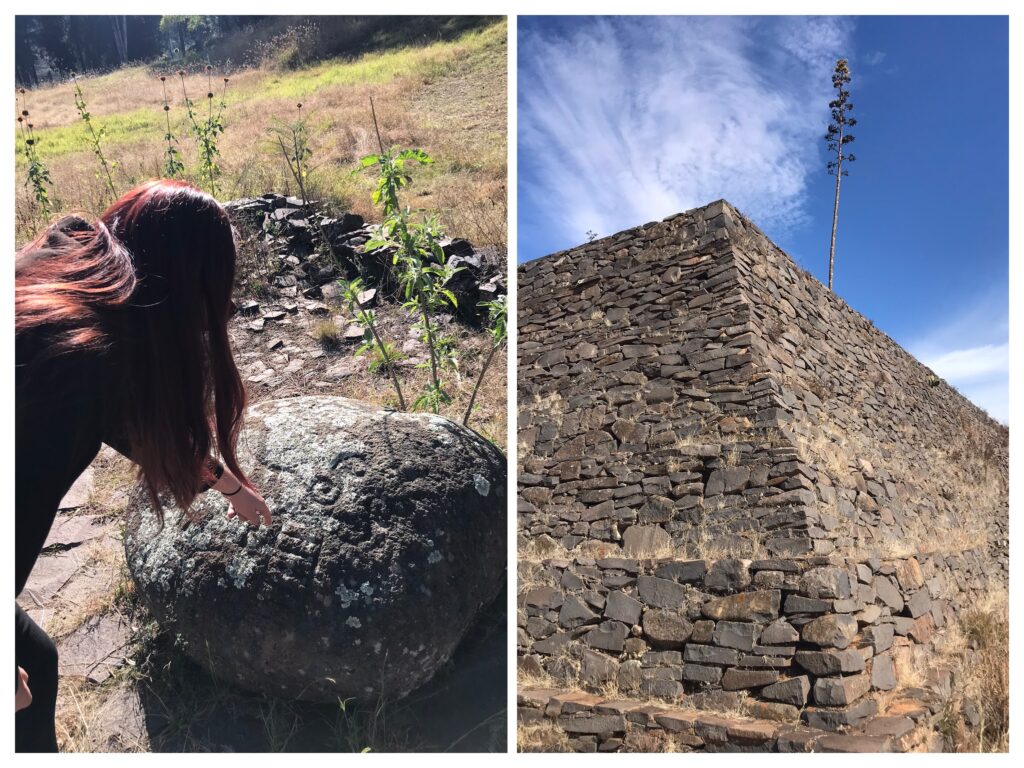
Tzintzuntzan was a highlight of the Mexican leg of our trip
The Tzintzuntzan archaeological site is set on an artificial steppe, it was a ceremonial centre for the Purepecha people and from the top it provides beautiful vistas over Lake Patzcuaro. Artefacts are housed in a modern museum building onsite which is included in the entry ticket. The museum building was tastefully designed, I really appreciated the design of the building!
The other popular place to visit in Tzintzuntzan is Ex Convento de Santa Ana, located within a complex on the other side of the main highway in town close to where the colectivo drops off. Parts of the convent were constructed with stone from the archaeological site. Some of the original brick has been left exposed (by whom and how nobody knows), with indigenous designs visible on some of the bricks. Original wall paintings of Biblical scenes and saints are still visible in the courtyard and adjoining rooms, while the former convent now also contains a small museum. The display of indigenous arts and crafts was particularly interesting, with straw figures, intricate ceramic plates and other curiosities.
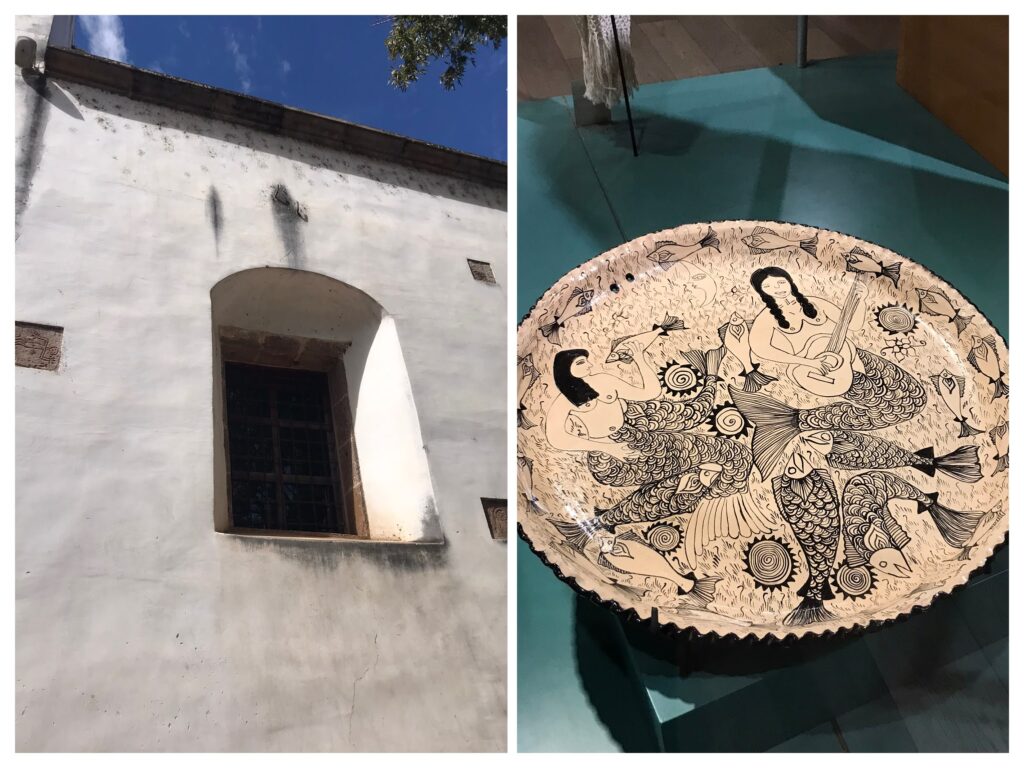
If you look closely at the facade of the convent, you notice that some of the brickwork is exposed showing indigenous designs underneath. Local craftwork is also on display in the convent such as this plate.
You can see that this tradition of handicrafts is still alive in the town of Tzintzuntzan today. The carpentry shops lining the main road were pretty cool.
Before leaving Tzintzuntzan we had lunch at Cocina tradicional La Casa de Blanca – a highly rated traditional restaurant serving local Michoacan food made by a group of traditionally-costumed senoritas using traditional cooking methods. No ovens or microwaves in sight here!
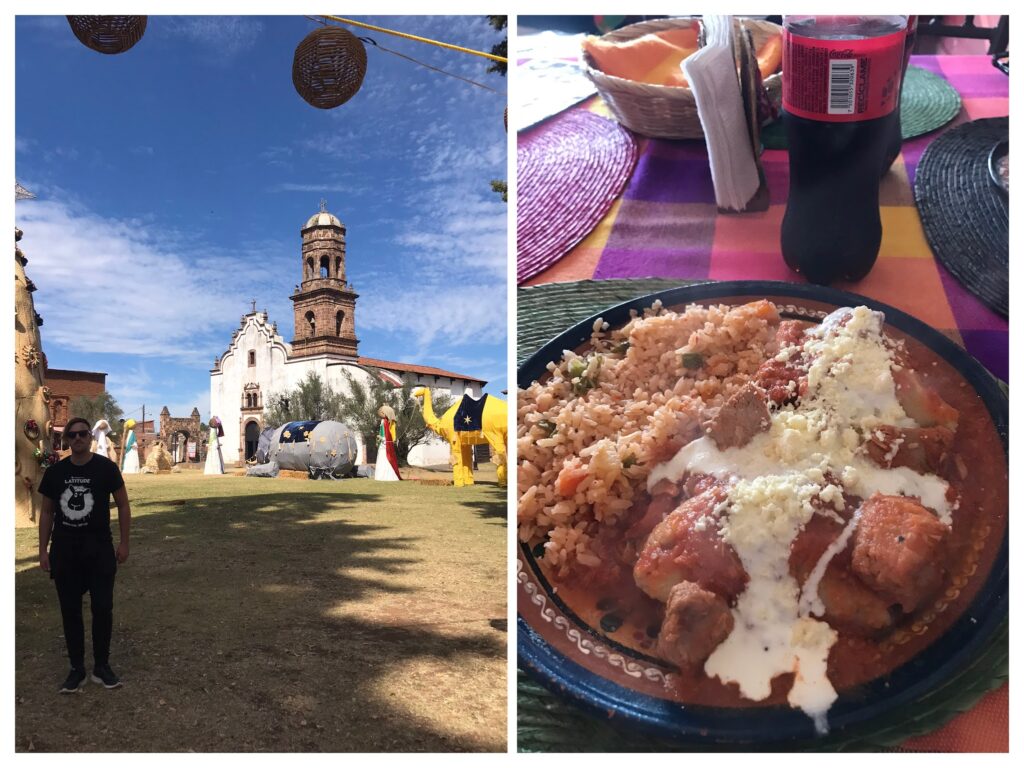
Even though we visited in mid-January the nativity scene was still on display outside the convent – don’t miss out on a traditional Michoacan meal at Cocina tradicional La Casa de Blanca.
The colectivo picked us up at the side of the main road in town, just across from where we were dropped off (around here). Some local women were also waiting for the colectivo back to Patzcuaro so we were able to confirm with them that we were in the right place. On the way back we decided to stop the colectivo before we got to Patzcuaro and get out on the road near to the Muelle General to take an afternoon boat trip to Janitzio, as the colectivo was heading past the muelle anyway on the way back to Patzcuaro.
Guanajuato
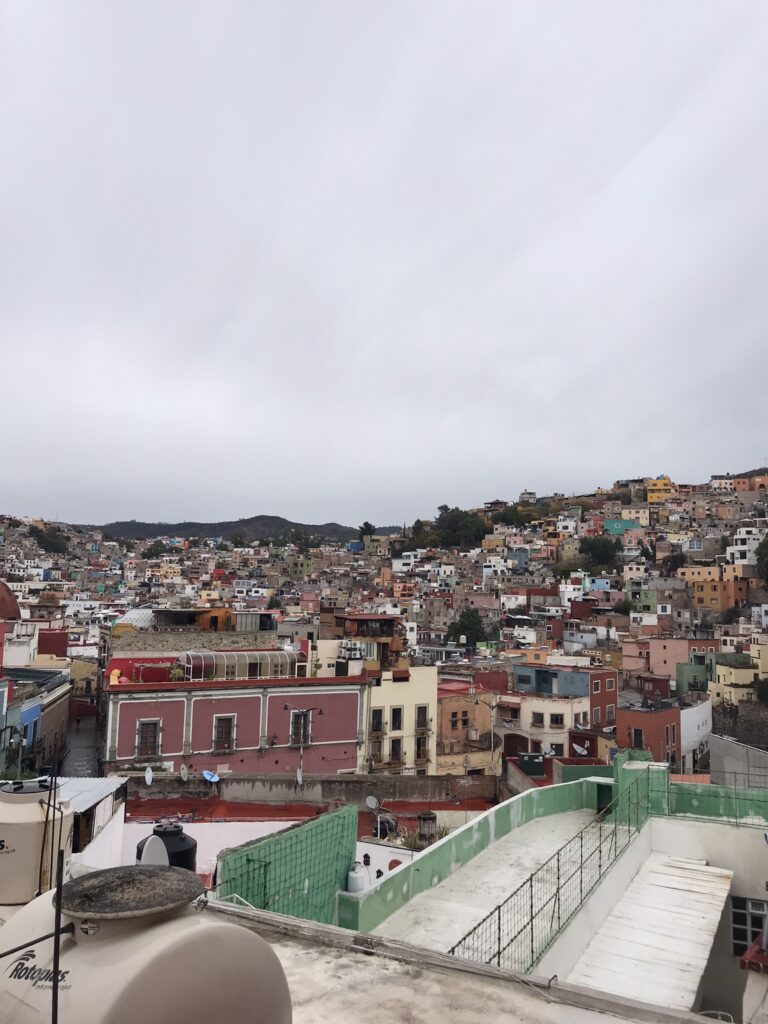
Guanajuato is unusual for major Mexican cities in that it does not follow the typical block layout. Instead the city is built into a valley and is filled with higgledy-piggledy streets, narrow alleys, stairways and underpasses. The city’s layout is very unique and it can make maps hard to follow at times, with multiple roads and routes often converging on top of each other. The city is also very photogenic, with colourful houses in the barrios along the sloped sides of the valley.
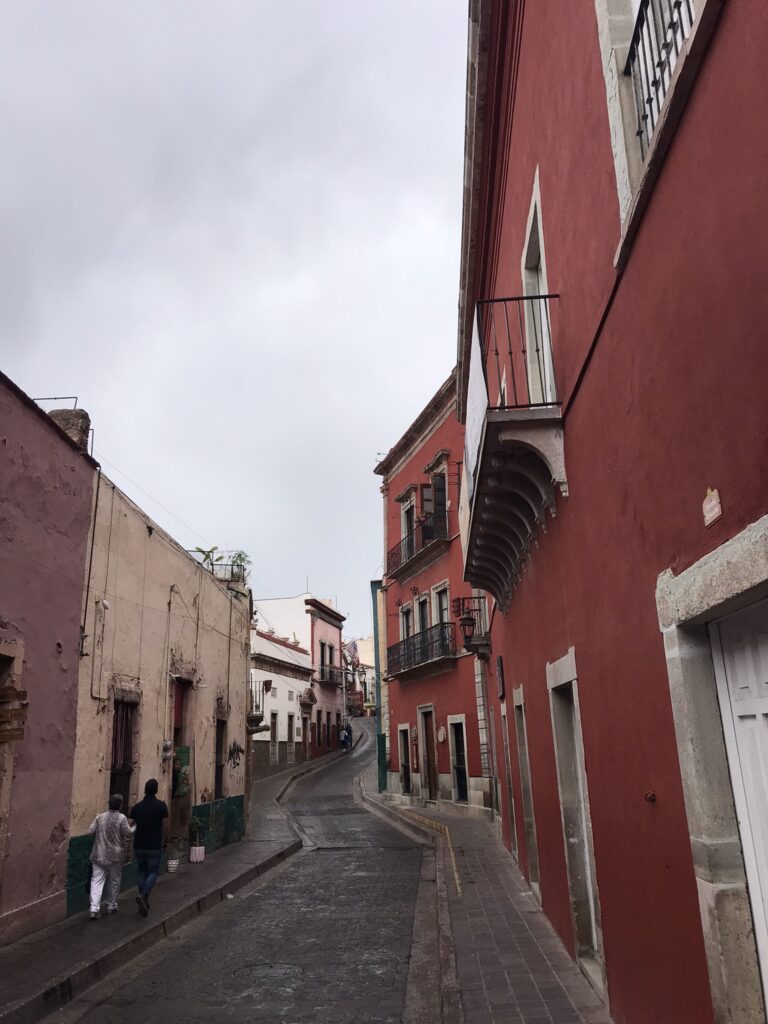
It’s difficult to find a straight road in the centre of Guanajuato
We found Guanajuato to have a youthful and vibrant feel with lots of students and young people around, no doubt due to the presence of the large university in the city. We also heard a number of American voices, both tourists and expats now living in the city. This was definitely more noticeable for us after spending time in Michoacán state, where there were virtually no gringos to be seen.
Accommodation
We stayed in a really nice Airbnb close to Cafe Tal.
Foodie Places
Bánh Mì – Asian food in a trendy restaurant which was playing English-language hipster indie music the whole time we were there. The pad thai and drunken noodles were ace.
Street Garden – an American-style burger joint, this was a street-dining experience with seats in the small plaza outside the restaurant. There were no toilets or inside seating when we were there. Tasty burgers at a good price.
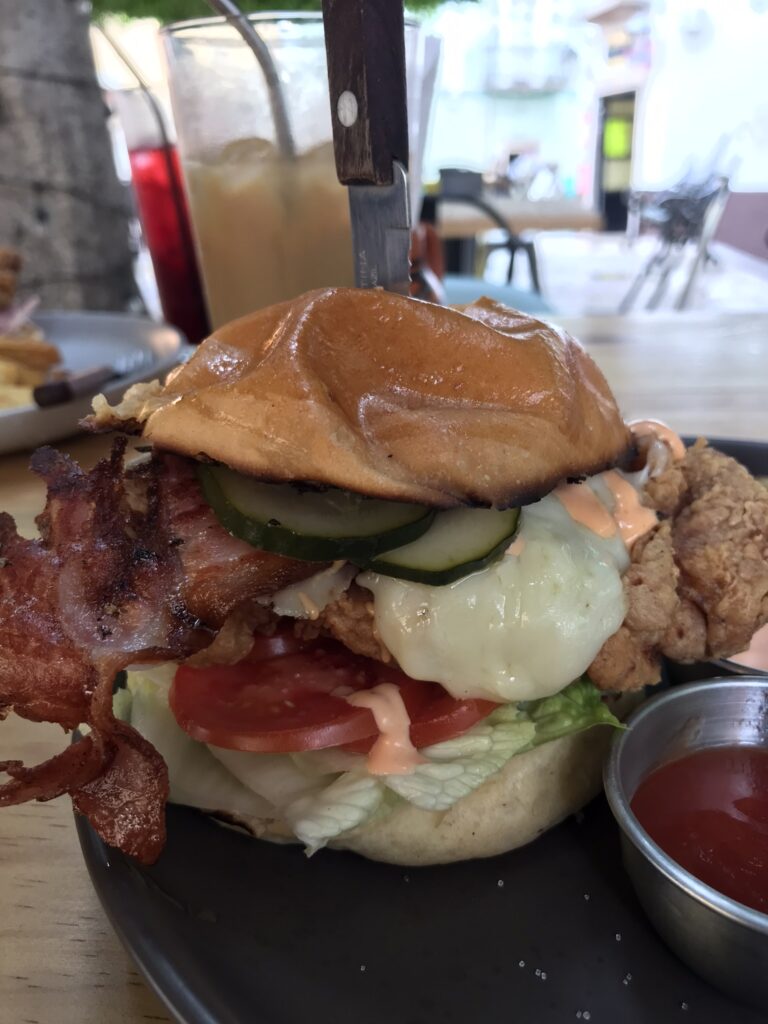
Craving a burger? Head to Street Garden for a down-to-earth alfresco dining experience
Activities
Mummy Museum (Museo de Momias) – an intense and at times shocking and gruesome experience. After visiting it might be difficult to get a good night’s sleep. This museum contains a collection of mummified human corpses that were exhumed after the introduction of a local burial tax in the mid-1800s. The unfortunate souls on display are the ones whose relatives couldn’t afford to pay the tax and weren’t reburied. The ground and climate in this area was particularly good at preserving corpses, so many of the exhumed bodies were naturally mummified and were kept in storage. They were then put on display in a makeshift museum in the late 1800s when people expressed a desire to pay to see the mummies. Morbid. It was particularly harrowing to see the paper-like skin of the mummies drooping off the corpses and the pained/ghoulish expressions of the mummies. The infant mummies were truly shocking. You could even see the hair on their heads and original clothing. There was a foetus mummy and its mother on display too. This honestly was more like something out of a zombie movie than a museum. There was very little knowledge to be gained, but it was definitely a memorable experience. We were confused to see a number of Mexican families in the museum. It was really strange that people brought their children here.
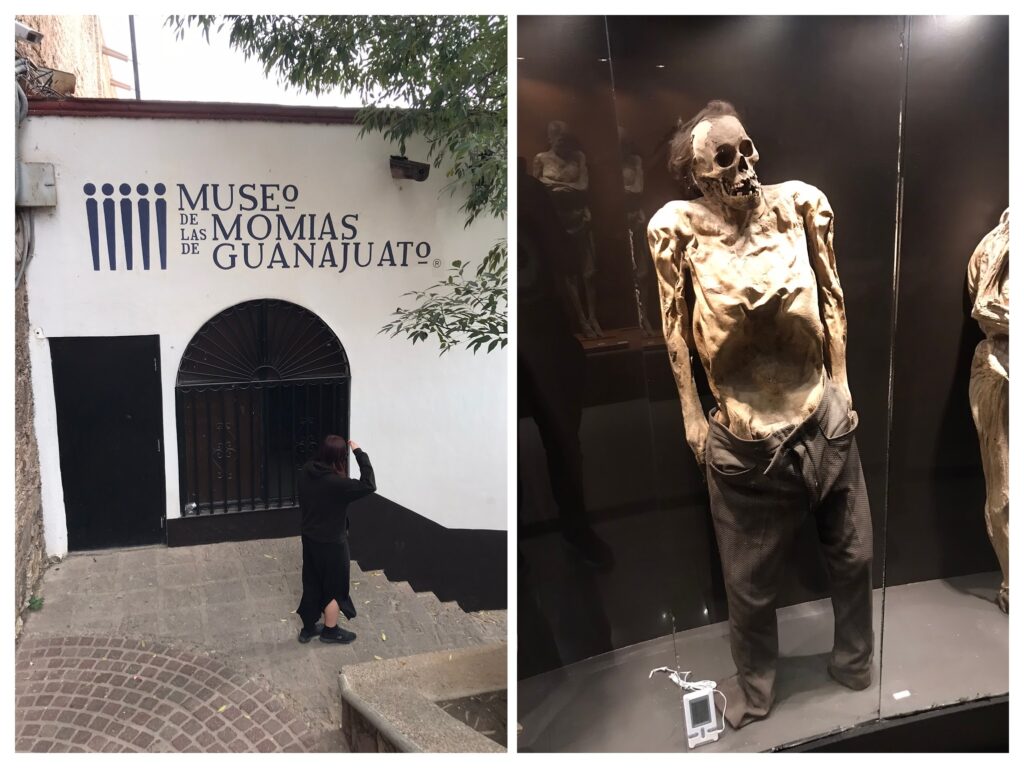
The Mummy Museum is not for the faint hearted!
Diego Rivera Museum – this museum is set in the birthplace and childhood home of Diego Rivera, one of Mexico’s most famous artists. Information about his life, his artwork and the various phases of his artistic progression are on display, you can follow the young artist finding his footing and his own style through the evolution of his artwork. There are Picasso-style paintings by Rivera made during his early trips to Europe, which are very different from the art that he was later known for. There are also portraits of Rivera, both self-portraits and portraits by other artists. As well as Rivera, there are works from other artists on display too, as well as a large area dedicated to temporary exhibitions. A must-visit for art lovers.
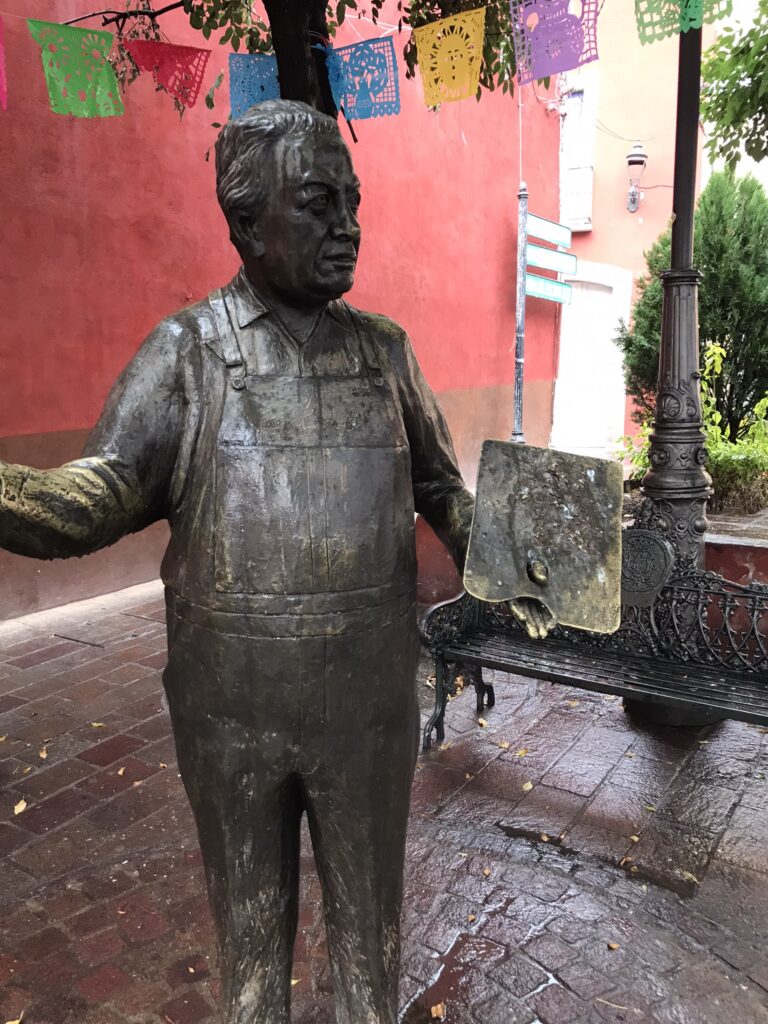
Close to Diego Rivera’s former home is a cool statue of him on a street corner
Self-guided walking tour including Teatro Juárez, Basílica Colegiata de Nuestra Señora de Guanajuato (a church with a striking yellow facade, we saw a wedding taking place here), Templo de la Compañía de Jesús Oratorio de San Felipe Neri, University of Guanajuato, Faculty of Architecture with its large and famous staircase, Museo de Arte Contemporaneo Primer Depósito (a demon-looking head peeking out from the roof) and Callejón del Beso (also known as Alleyway of the kisses, the alleyway is so narrow couples can kiss from the balcony on each side, a romantic photo op for couples who are so inclined). Guanajuato’s interesting architecture is a major highlight and attraction of the city.
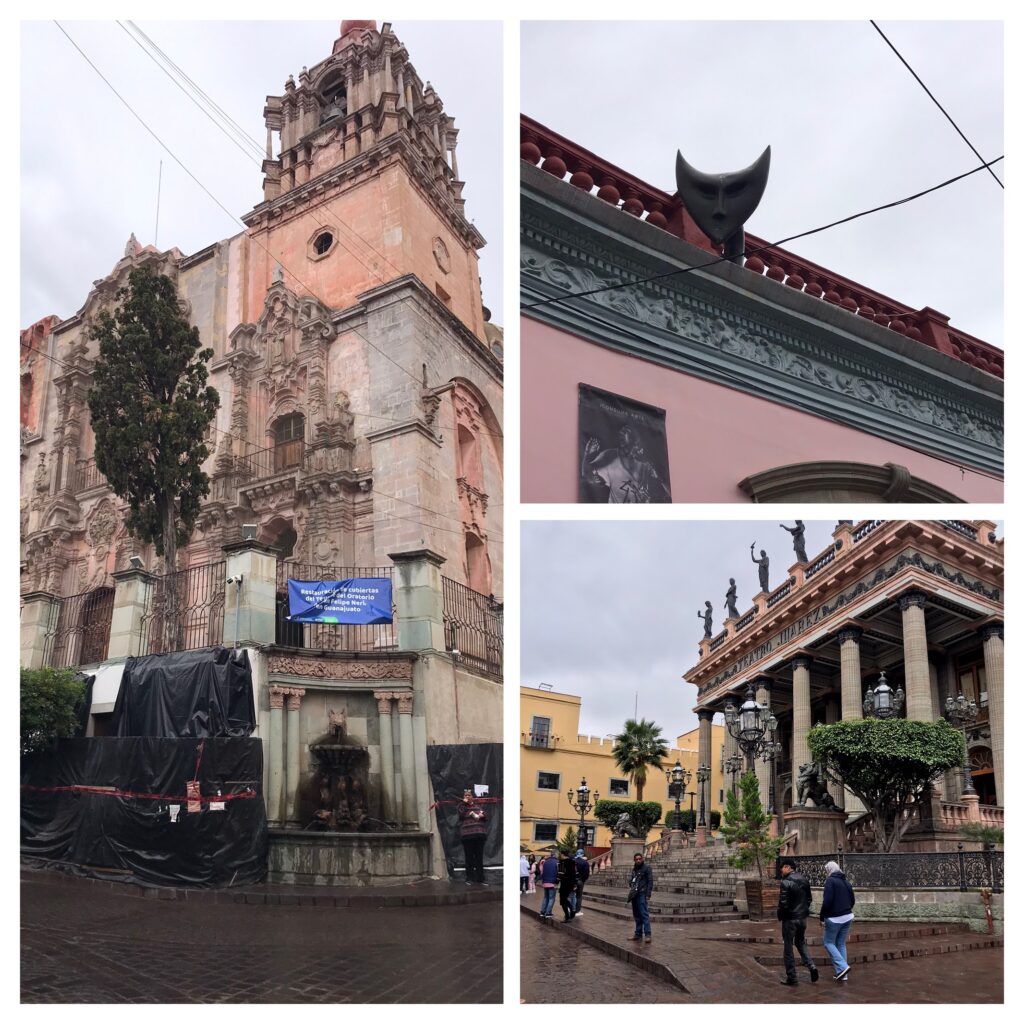
Notable landmarks in Guanajuato
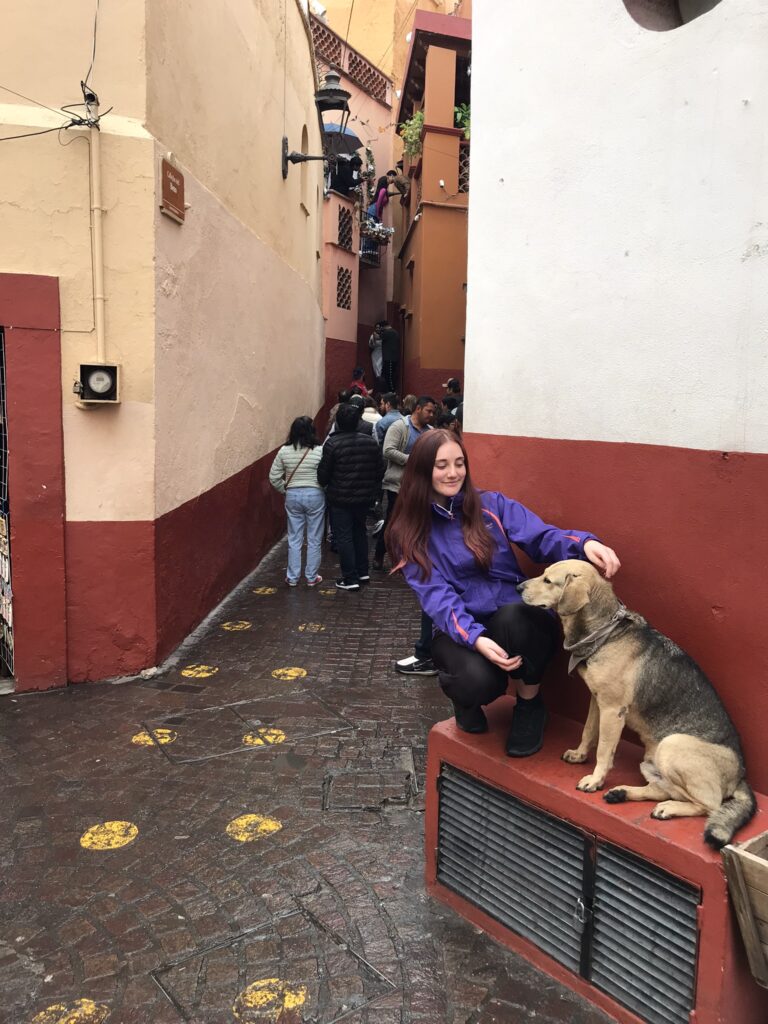
My alleyway of kisses experience!
San Miguel de Allende
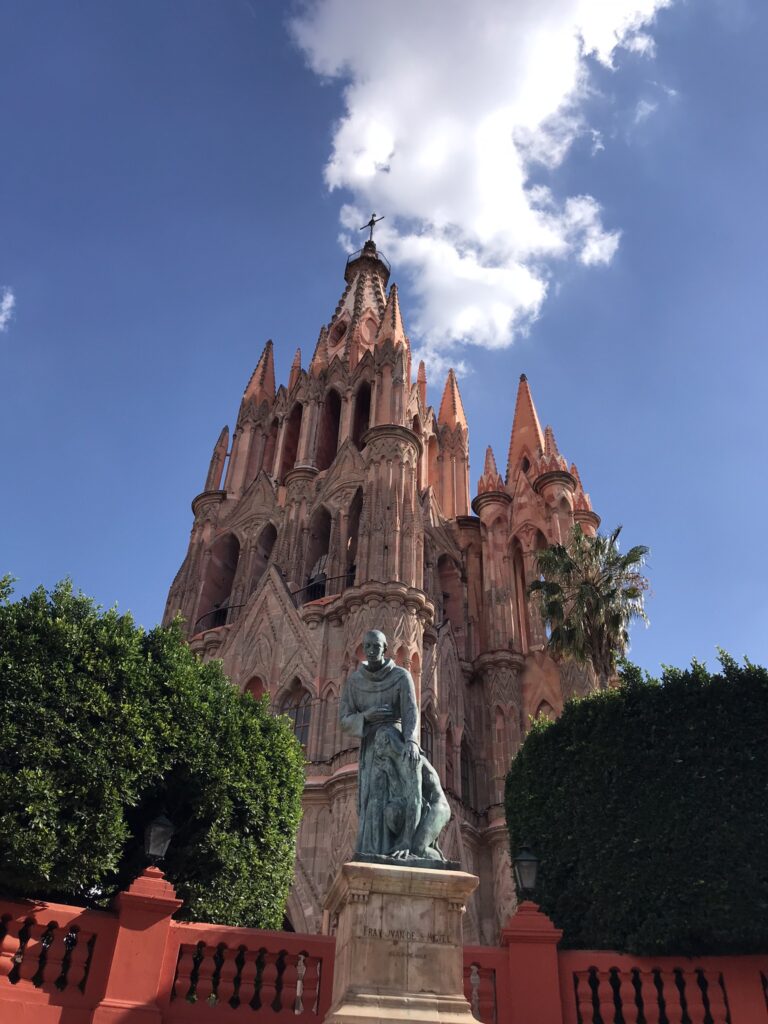
San Miguel de Allende has a contradictory past. Originally a key town in the early days of the Mexican independence movement, in modern years the city has become known for its large expat population. Today tourism dominates central San Miguel de Allende, with plenty of American accents to be heard. Still, the town does retain some of its Mexican character, especially in its grand colonial architecture and colourful Balamory-style streets.
San Miguel de Allende was originally called just San Miguel. It was renamed after Ignacio Allende, a revolutionary hero in the struggle for Mexican independence who was from the town. Allende, along with Miguel Hidalgo, was one of the original plotters against the Spanish government. Hidalgo’s famous call for Mexican independence (Grito de Dolores) took place in the nearby town of Dolores, now renamed to Dolores Hidalgo. Immediately after the cry of independence, the newly formed army led by Hidalgo and Allende marched to San Miguel, and it became the first city to be liberated from Spanish rule.
In the mid-1900s San Miguel became a hub for culture and arts. This saw large numbers of Americans and other foreigners moving to San Miguel and the creation of a significant expat community. The influx of the foreign wealth is evident in the town, it is notable just from looking around the supermarket. I spotted luxury items like French Dijon mustard and smoked salmon, and the shelves were lined with a proliferation of international and American brands that would not usually be seen in a normal Mexican shop. The streets of San Miguel are filled with a myriad of upmarket boutiques selling expensive clothing. We saw cowboy hats for sale everywhere, from street vendors to fancy independent shops. Just outside of the city on the way to Atotonilco we noticed many new gated developments popping up along the main highway, from the billboard advertisements it was obvious these were being promoted to the expat community. We also saw properties in the city centre being offered for sale by American real estate agents.
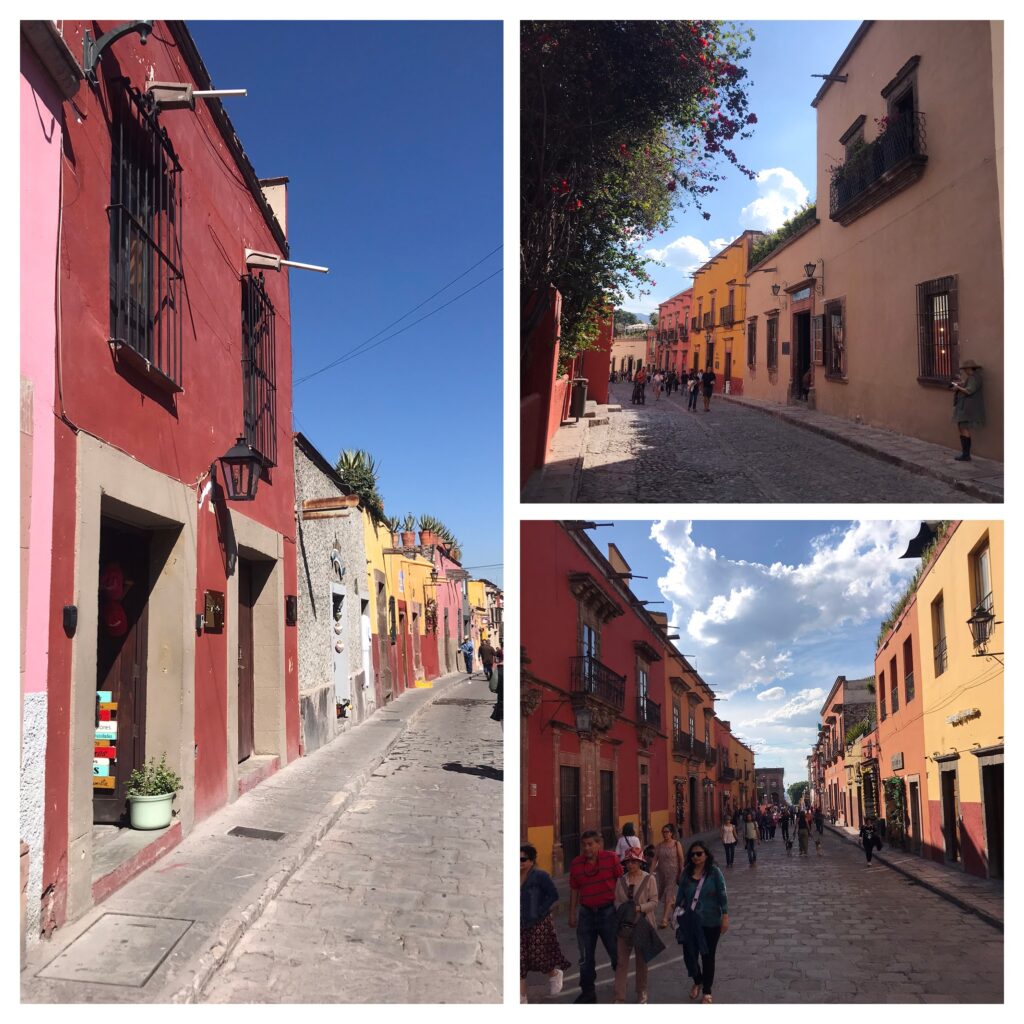
Street scenes from San Miguel de Allende
While the historic centre is gentrified, outside the city centre San Miguel de Allende still has a very local feel. We walked to and from the bus station and there was a totally different atmosphere in the areas away from the touristy centre. People in the region suffered from the closure of local mines and there seems to be a bit of a wealth divide in the city.
We were lucky enough to experience Ignacio Allende’s birthday celebrations in the city on 21st January. This took the form of a really impressive parade that we stumbled upon completely by accident. First local school children paraded through the streets with their uniforms and school banners, their synchronised marching almost with military precision; it was clear they’d all spent a lot of time practising. We then saw students from the local universities and trainees for a variety of professions dressed in their vocational clothing, from young nurses to engineers, chefs and ‘administrators’. Next came the marching bands, so loud!
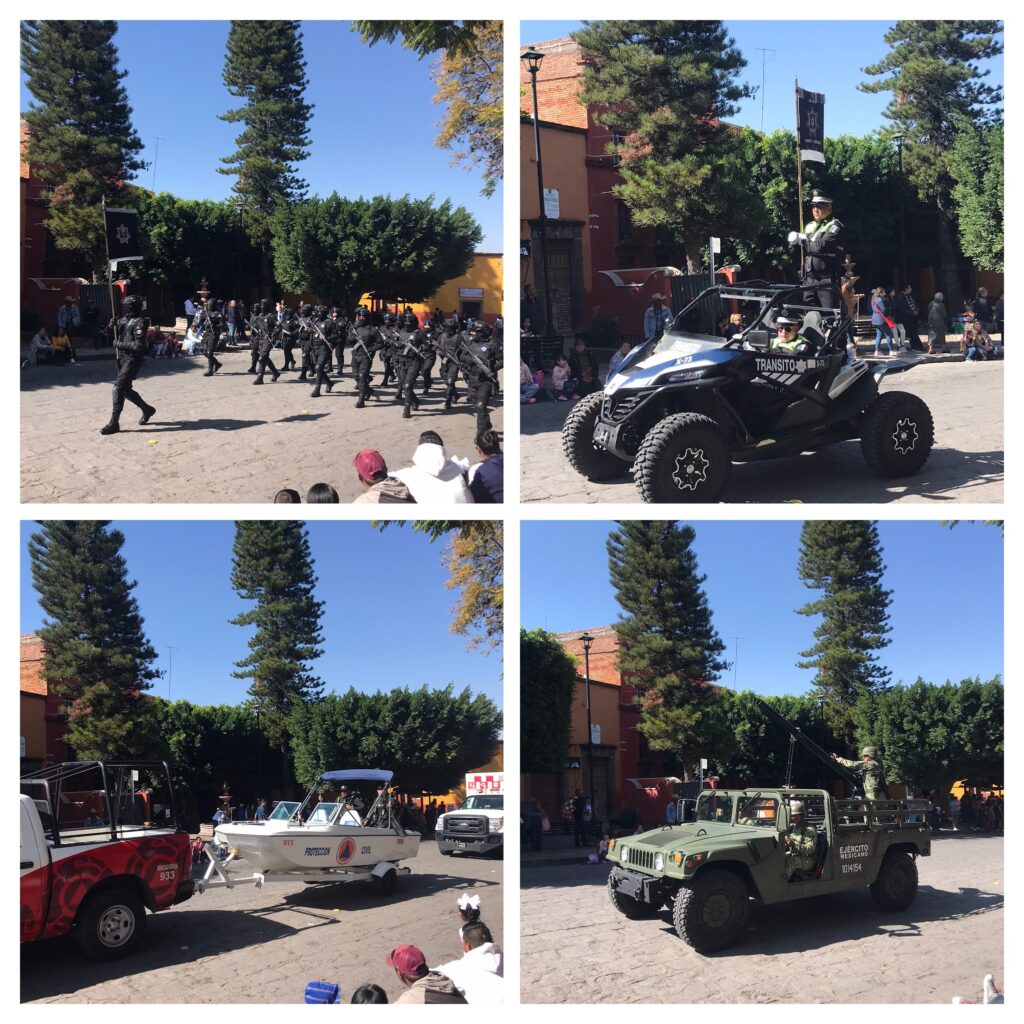
This was hands-down the best procession I’ve ever seen!
After that we were shocked to see a procession of police and military units from seemingly every armed department in Mexico, including the border force, municipal police, drug squads, mounted sheriffs on horseback, elite units and camouflaged soldiers disguised as haystacks. Some were in trucks, others marched, some were in ATVs, the marine scuba unit were in a boat complete with scuba equipment, we saw army jeeps with machine guns, antiaircraft guns and tanks. The local firemen even made an appearance carrying axes. This overt show of military might and power almost gave us a North Korea vibe, but it was warmly received by the locals and I think the parade was more an attempt to show solidarity and community spirit than intimidation.
Accommodation
La Catrina Hostel and Breakfast – within walking distance of the historic centre. A welcoming hostel with a shared kitchen. There was a mix of gringos and Mexican families staying in the hostel. The breakfast was a bit miserly sadly, but the place was fine other than that.
Foodie Places
Chocolates y Churros San Agustín – the best churros we had in Mexico. Rellenos (filled) are the best from here with flavours like nutella and strawberry. You can either opt to takeaway or eat inside at a table. Expect a queue outside the front as it’s a very popular churros house.
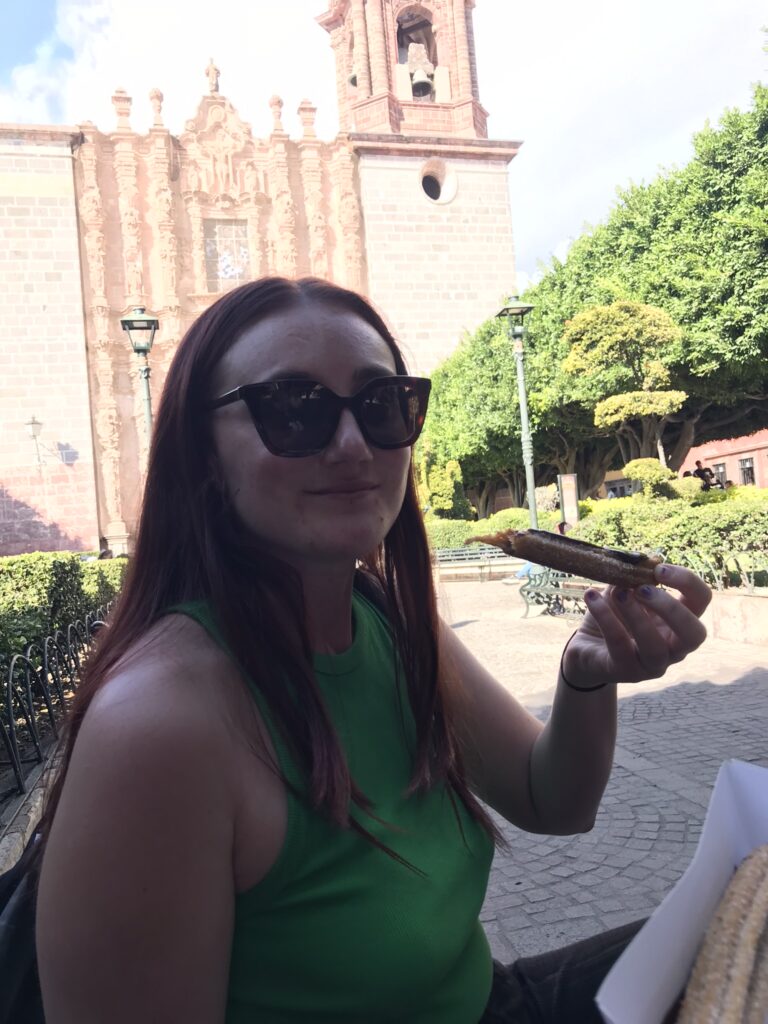
Best churros of the trip: Chocolates y Churros San Agustín
Activities
We took a self-guided walking tour of the city centre, with the main sights including the Jardin Allende, this main square is the beating heart of San Miguel de Allende, full of activity and music. It really comes alive at night! Parroquia de San Miguel Arcángel – the many-tiered birthday-cake-looking church in the Jardin Allende, an iconic and unmissable symbol of the city which is also beautifully lit up at night – a statue of the town’s original founder Fray Juan de San Miguel next to the Cathedral, Museo Histórico Casa de Allende (the former home of Ignacio Allende and now a museum) complete with a statue of Allende on the facade and Templo de San Francisco de Asís – another beautiful colonial church and the gardens are a great spot to gorge on a churro from nearby Chocolates y Churros San Agustin.
Cultural Centre Ignacio Ramirez – previously a convent, this is now an art gallery and place for art students to display their work. I believe art classes are also taught there.
Santuario de Jesús Nazareno de Atotonilco – Atotonilco is a small town located a few miles north of the city centre. It is best known for its iconic church with many pointed steeples decorating the outside. Compared to the Sistine Chapel, this church is famed for its exquisite interior decoration and painted ceilings. It also played an important part in Mexican history, as it is the place where Allende, Hidalgo and their men while en route to San Miguel picked up the Virgin of Guadalupe banner, which became the emblematic flag of Mexican independence. We visited Atotonilco on a Sunday and only managed to get a peek in the front door, as mass was taking place and we got fed up of waiting outside.
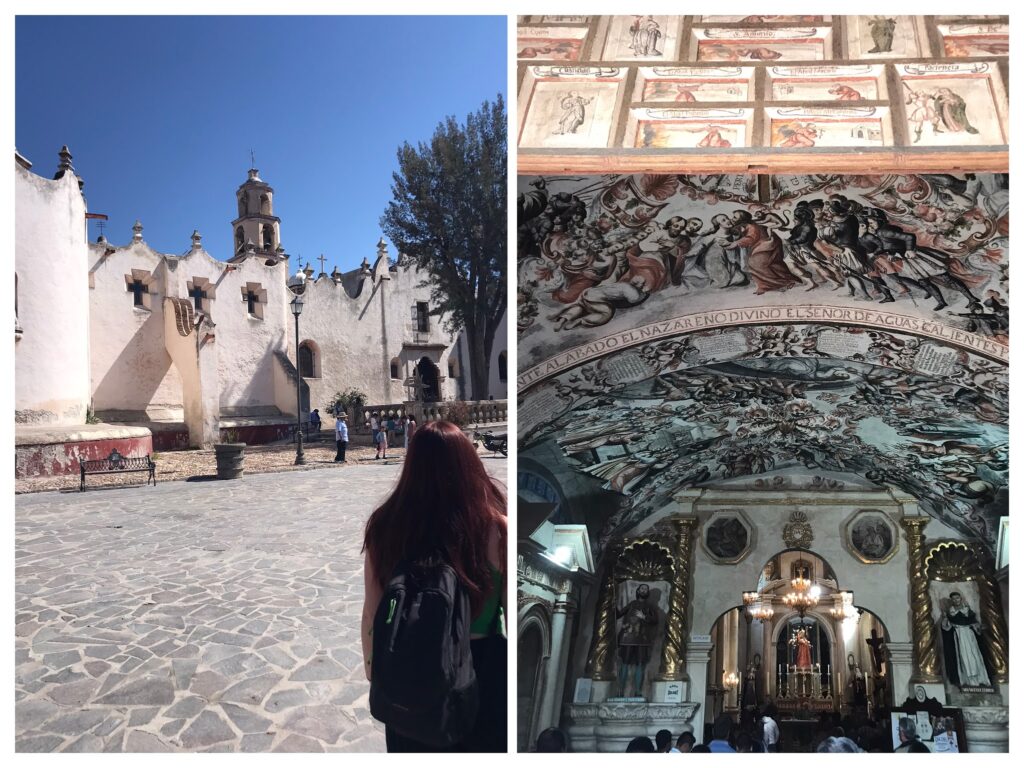
In hindsight, Sunday probably wasn’t the best day to visit the Santuario de Jesús Nazareno de Atotonilco as we had to wait around for ages for mass to finish. In the end, we just gave up!
There was a weekend market in the small town on the way to the church with some affordable street food, we particularly loved the quesadillas and fresh fruit stalls. An authentic foodie experience. From the centre of San Miguel you can catch the local bus to Atotonilco from this bus stop. Make sure you check the return times with the driver to ensure you don’t miss the last bus back!
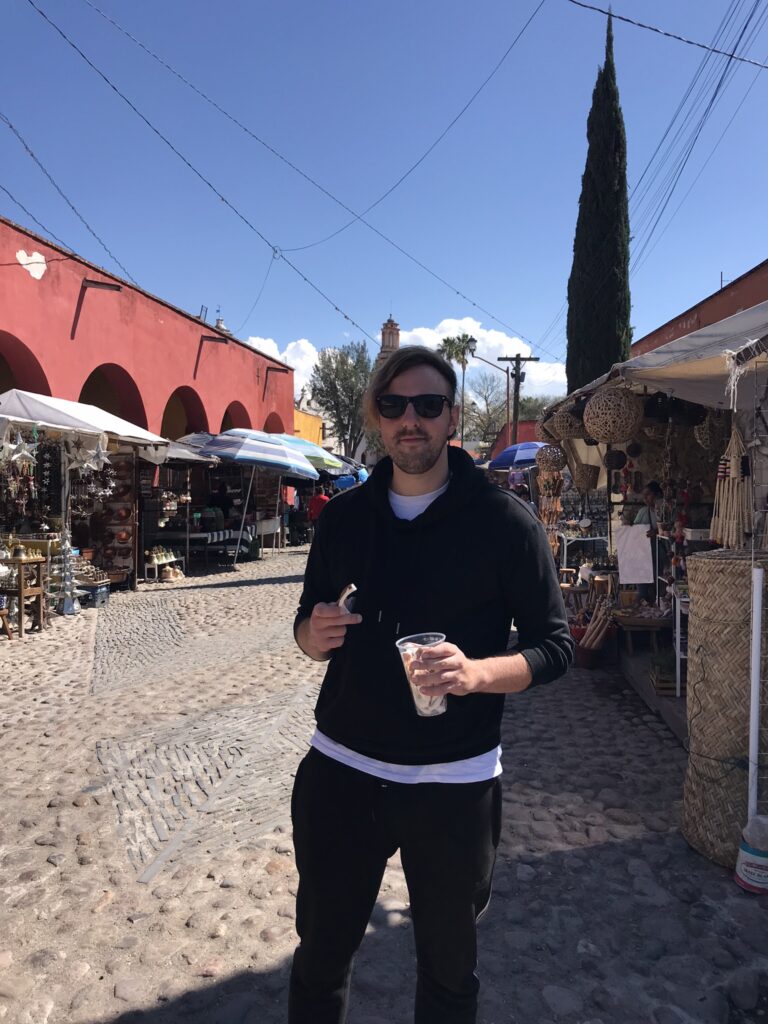
Enjoying the street-food in Atotonilco
Queretaro
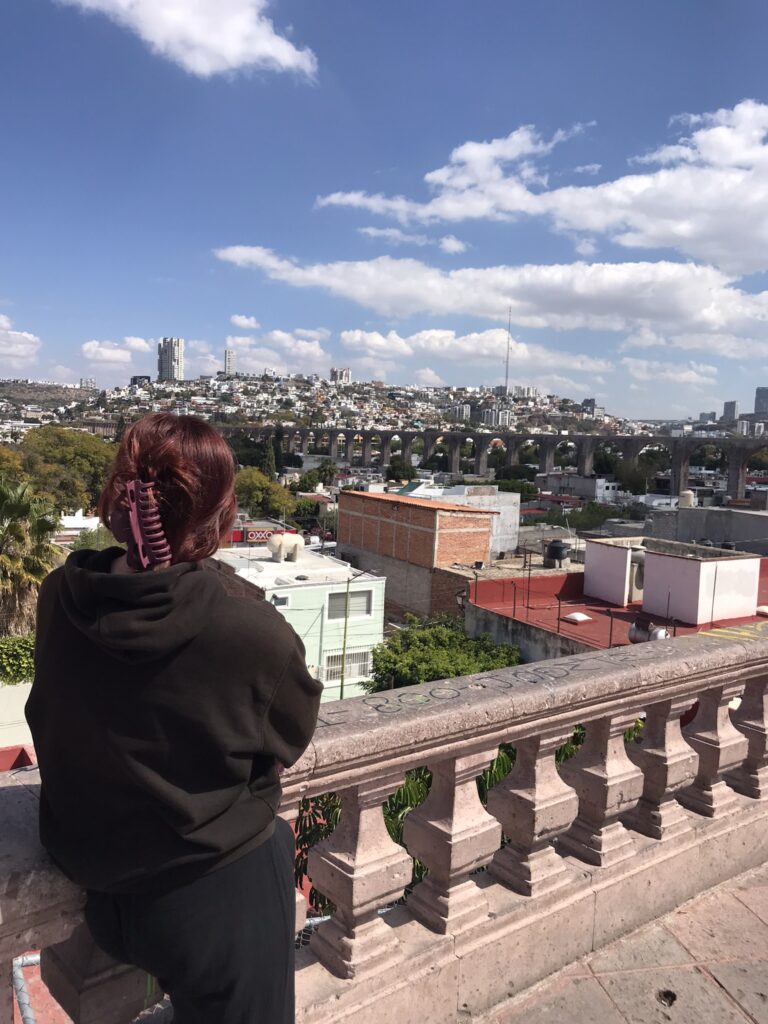
For some reason Queretaro seems to fly under the radar a little bit. Compared to the likes of Guanajuato and San Miguel de Allende we encountered relatively few expats or tourists here and the city doesn’t seem to be as well-known to non-Mexicans as some other nearby towns and cities. Queretaro is a large city with a population approaching 2 million people and we were surprised by the size and scale of the place, it really did seem like a sprawling metropolis. The bus terminal alone was enormous (it was actually several separate bus terminals joined together), clean and well maintained.
The colonial centre of Queretaro is protected by UNESCO and the city is considered to have played an important role in the history of Mexican independence, as it is in Queretaro where the first ideas and meetings among the plotters against the Spanish rule were held. Queretaro claims to be the home of Mexican rag dolls – dolls are everywhere in the centre of Queretaro. Queretaro is also considered to be one of the safest and most peaceful cities in Mexico. We definitely felt a positive atmosphere in the colonial squares in the city centre.
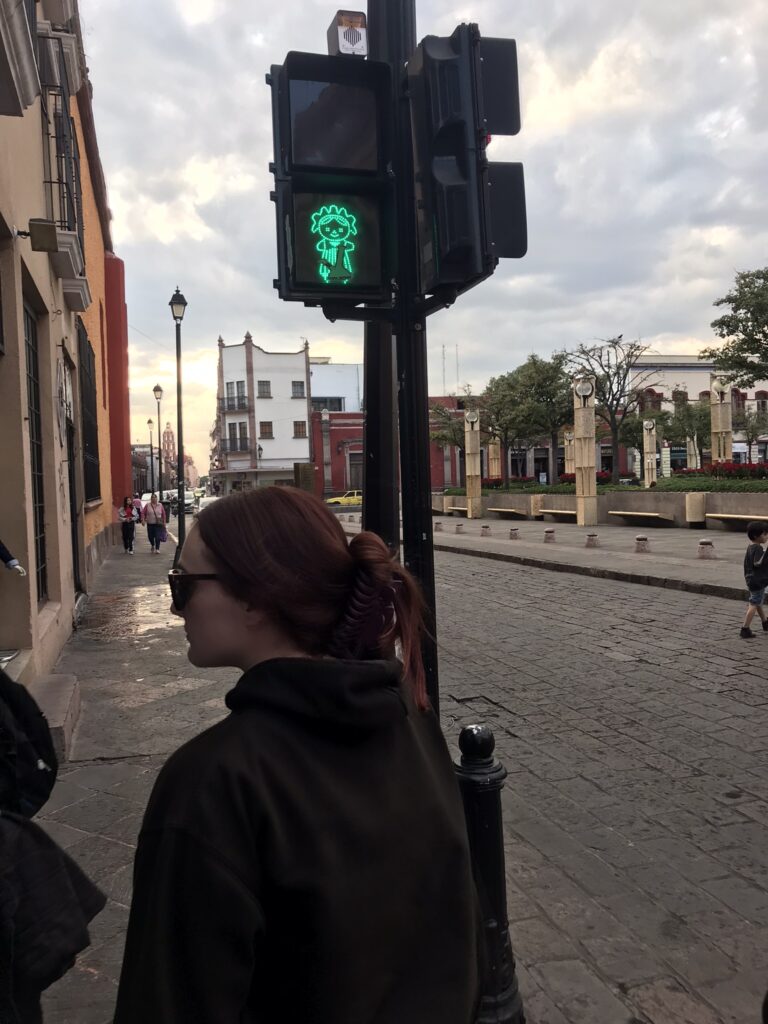
You can even see Queretaran rag dolls on the pedestrian crossing lights in the city centre
Accommodation
Septimo Hostal – a favourite hostel of ours, the room design was very spacious and modern with sliding doors opening onto a first floor balcony. The hostel kitchen was equipped with everything you need to cook your own meals. The vibe was quiet which was ideal for us, the kitchen was the social hub of the hostel. Although it’s not in the city centre, it doesn’t take long to walk to the historic district.
Foodie Places
La Compañía Café – the prices were quite high here and the portion sizes weren’t great. This seemed like a bit of a hipster place. The waiter spoke to us in English and was friendly, but in hindsight we would’ve chosen somewhere else for a more hearty meal and budget price.
Delichurros Querétaro Centro – budget-friendly churros place with a variety of sauces available such as peach or chocolate sauce. Games available. Nice place to stop for a churros and drink.
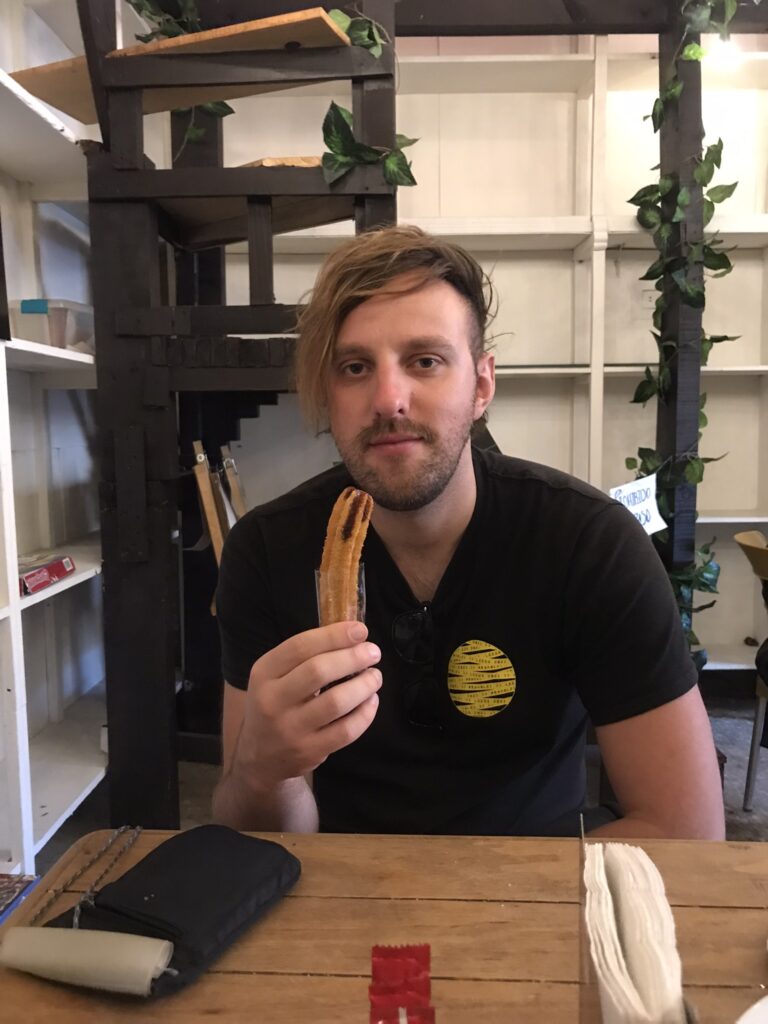
Churros, churros and more churros
Activities
Self-guided walking tour including Plaza de Armas, Andador 5 de Mayo, El Danzante Conchero Chichimeca, Templo de San Francisco, Zenea Garden, Plaza de la Corregidora, Theatre de la Republica, Jardin Guerrero, Fuente de Neptuno. Check out my self-guided tour here!
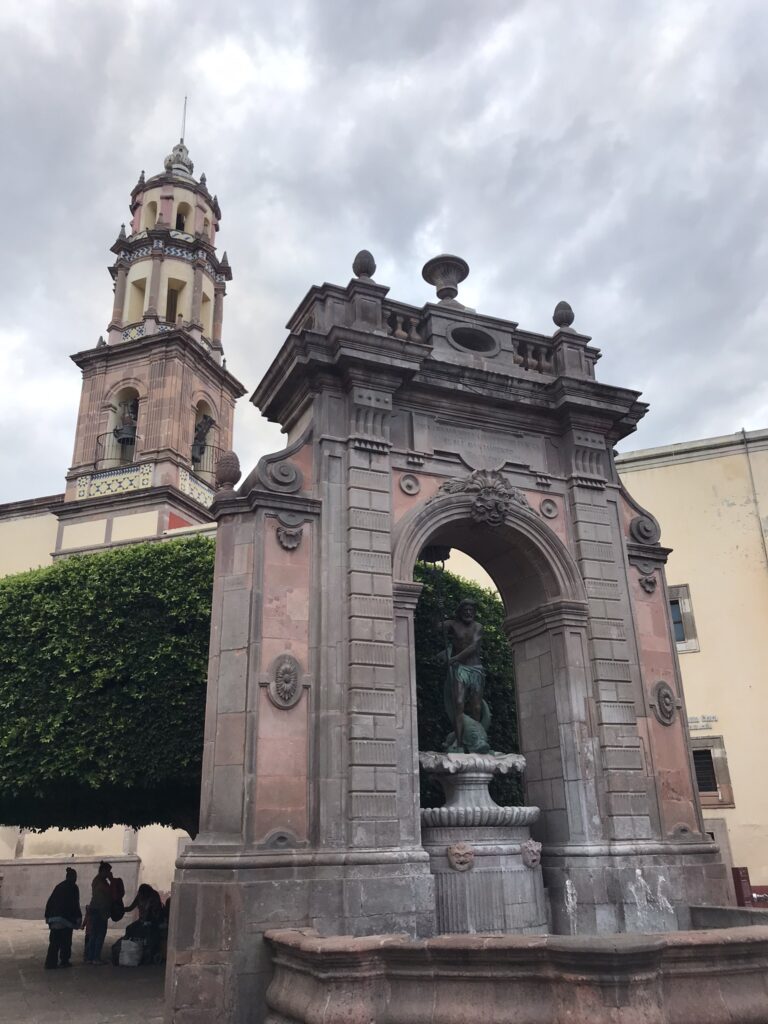
The Fountain of Neptune is an iconic structure in Queretaro
Aqueduct – an impressive engineering feat spanning over a kilometre. The aqueduct is one of the biggest in Mexico and stretches out across the city. The best place to view the aqueduct is here.
Shrine of Heroes – featuring statues of famous Queretarans including doctors, poets, explorers, politicians, theologians and philanthropists. A who’s who of famous residents, almost like the Hollywood Walk of Fame for people from Queretaro. A nice place to visit when you go to the Aqueduct viewpoint.
Regional Museum of Queretaro – housed in a huge colonial-era convent, this museum has displays about the history and importance of Queretaro and the surrounding region.

This convent now houses the Museum of the City
Day trip to Bernal to climb the Peña de Bernal
Bernal is a pueblo magico in Queretaro state, located about an hour east of the city of Queretaro. You can easily get there by bus from the main bus terminal (Central de autobuses de queretaro) in Queretaro. The bus drops you off at the side of the road in Bernal here. This is also the place to wait for the return bus to Queretaro.
Bernal is best known for the Peña de Bernal. This is a huge monolithic rock sprouting out of the ground which towers over the town and surrounding region. It is considered one of the largest monoliths in the world.
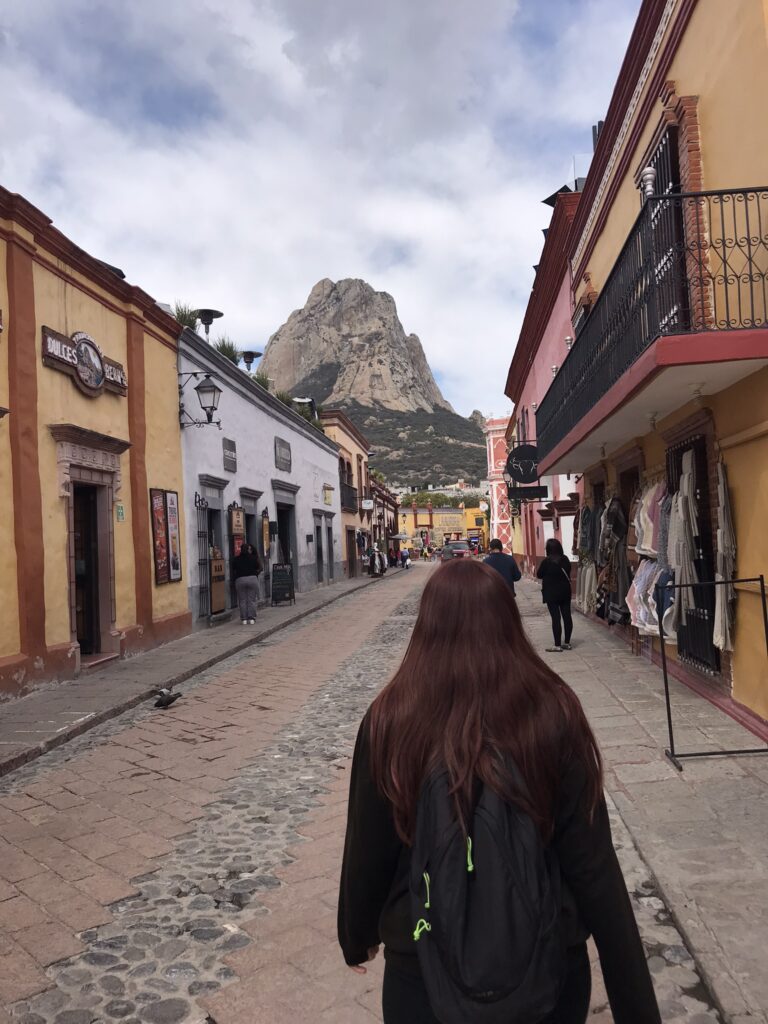
Bernal is known for it’s colourful town centre and massive peña (rock) overlooking the town
The peña is actually the core of an extinct volcano which was left behind after the volcano’s exterior eroded away. It is possible to climb the peña to see the dramatic rock formations and amazing views over the town. We made it most of the way up, but the path becomes quite difficult near the top. After scrambling across a section of slippery sheer rock face which was only passable using a guide rope, we spied a second roped section followed by a further section of sheer rock with no rope. We didn’t want to risk injuring ourselves and so didn’t attempt to scramble up this final section, although we saw locals who did. Make sure you bring shoes with a good grip and also travel insurance if you want to go all the way to the top!
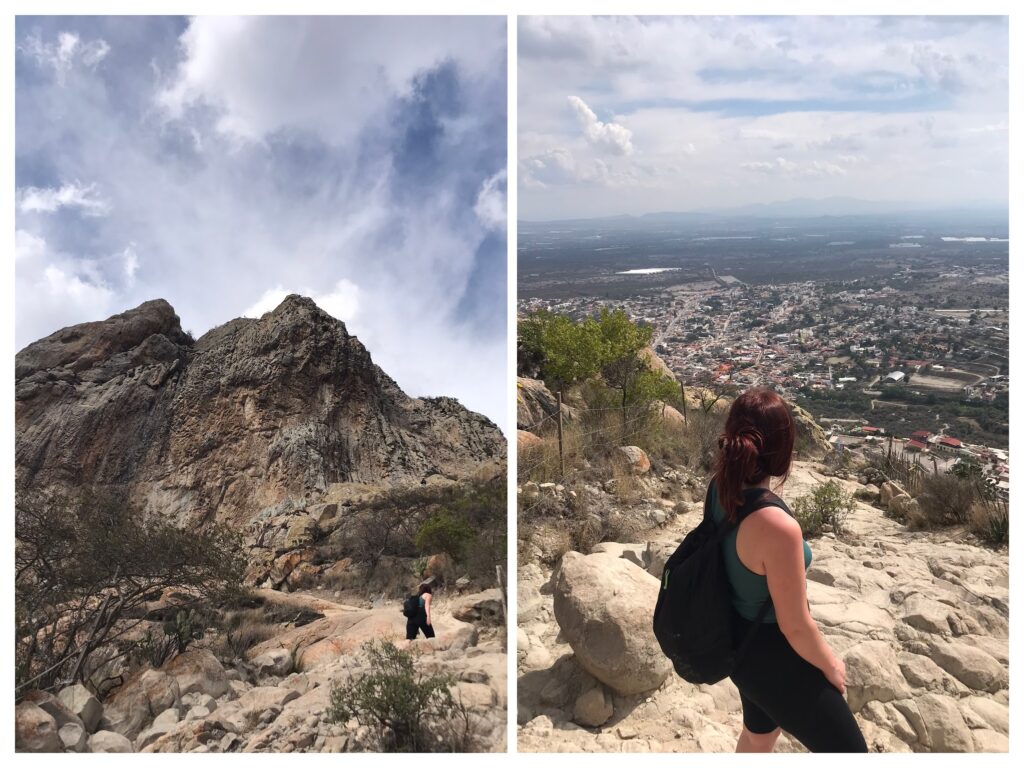
Be prepared for a scramble if you want to get to the top of the peña
Other than the peña, Bernal is a gorgeous small town. The town centre is very quaint and vividly colourful, looking almost like something from a storybook. We purchased Queretaran wine from a local shop, it was super sweet and delicious.
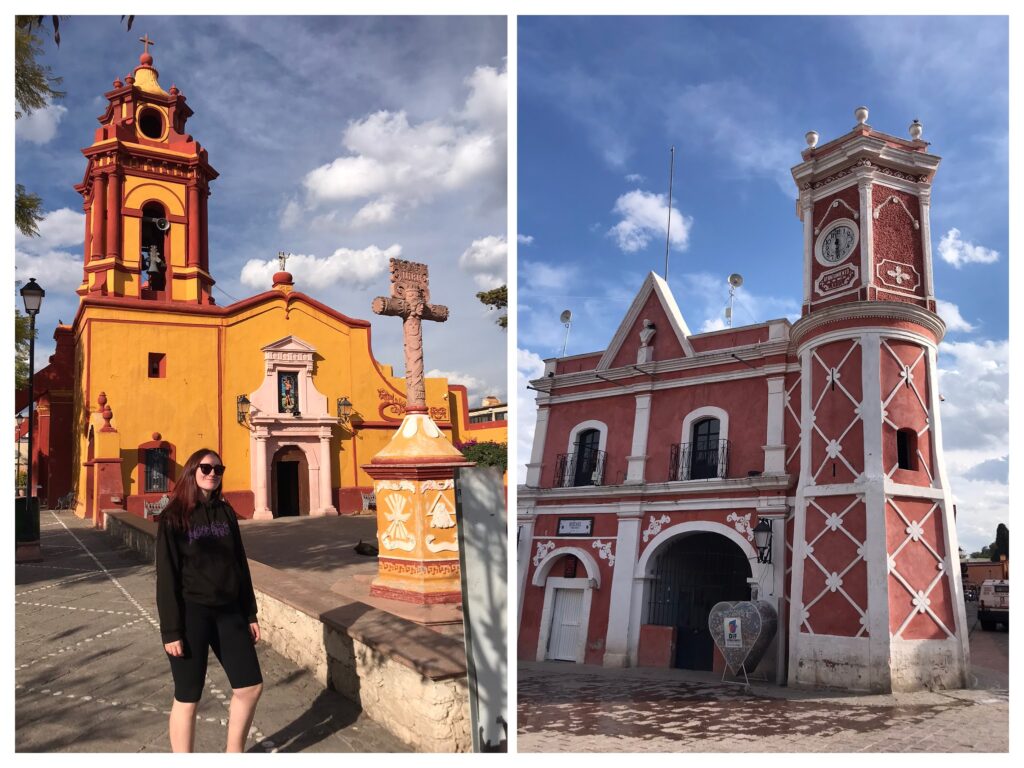
Mooch around the town centre in Bernal and check out the quirky architecture
Foodie Places
Veintidos Cafe – excellent enchiladas suiza with outdoor seating.
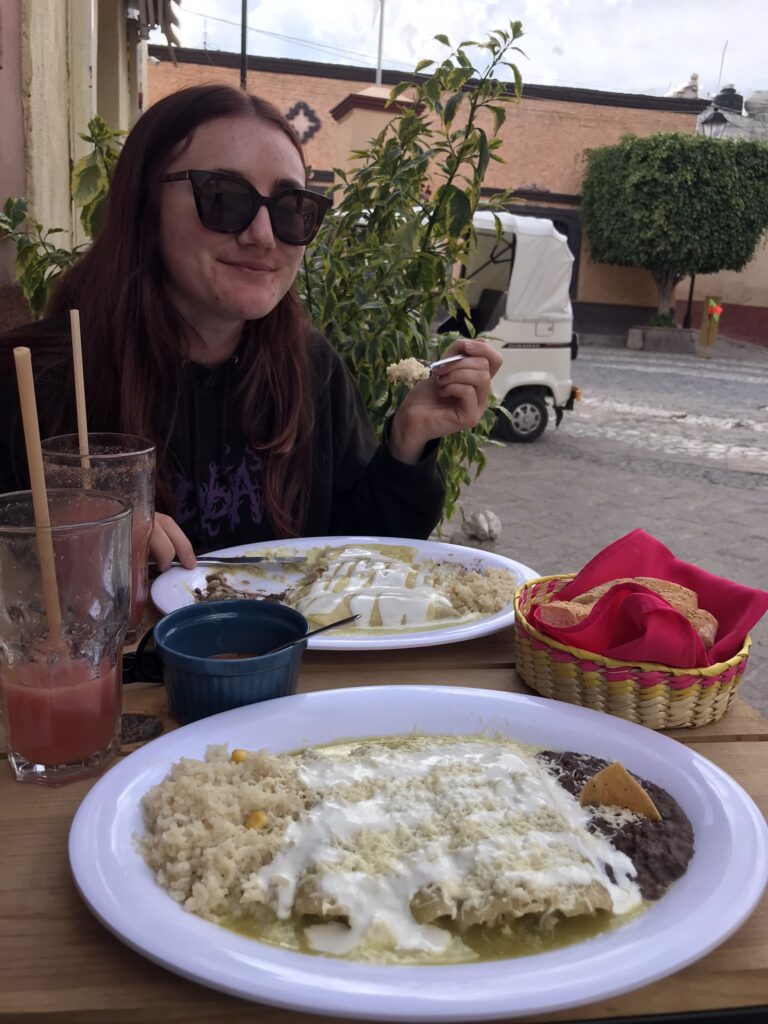
There’s no better way to end a day trip than with enchiladas suiza at Veintidos
Puebla
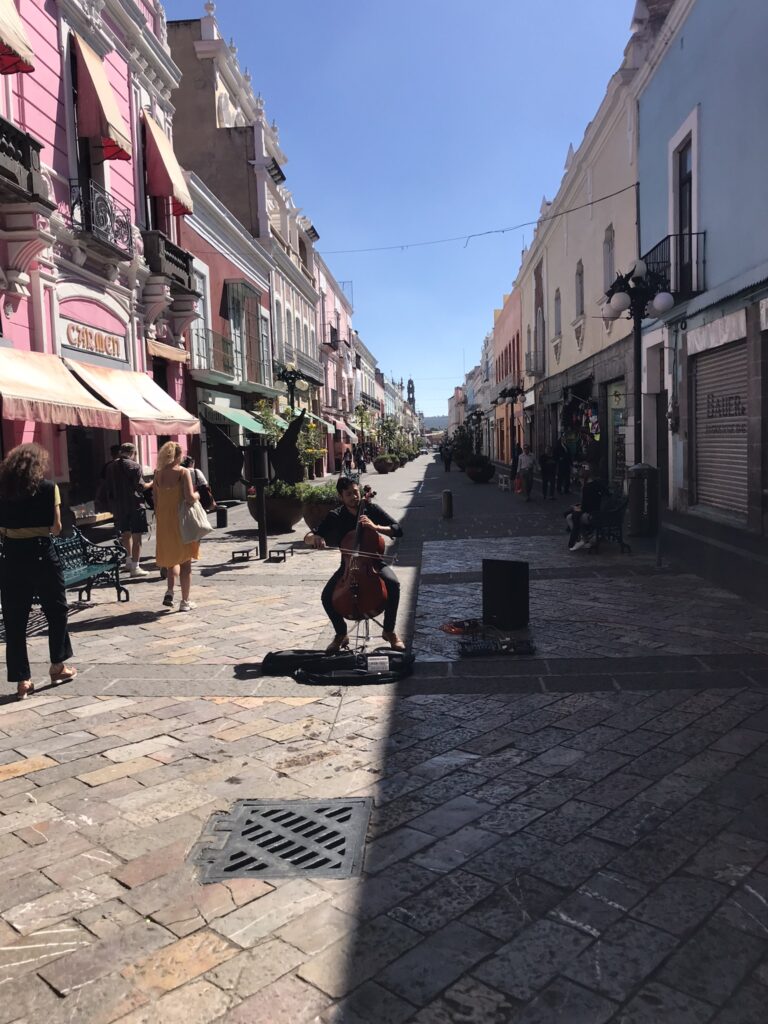
Puebla is the home of pulque, cemitas (a special type of local sandwich) and it also claims mole along with Oaxaca. Aside from the food scene, Puebla is best known for its cathedral, which is the second-largest in Mexico. Puebla itself is one of the largest cities in Mexico with some colonial buildings in the historic centre, although not as grandiose as the architecture in the likes of Morelia or San Miguel de Allende.
We found a strange atmosphere in Puebla. There is clearly a lot of American tourism and influence. In Puebla I met English-speaking Mexicans who couldn’t understand me as I wasn’t speaking with an American accent, which is something I have never encountered before or since anywhere else in Mexico or any other country. We even met one guy speaking English who said he had never heard of England and didn’t know where it was! There were also a lot of hasslers and hawkers in the Zocalo area outside the Cathedral, we experienced surprisingly poor service from most people we dealt with and generally something just seemed a little off during our time in Puebla. Maybe we were just unlucky.
Accommodation
Collection O Al otro lado del rio, Puebla – the courtyard was really lovely with hues of orange and pink. The property has a lively restaurant above the reception, but the noise from the restaurant thankfully did not really make it to the rooms.
Foodie Places
Lasagna Center – Mexican-inspired lasagneria serving interesting types of lasagna infused with Mexican classics, such as hongos (mushroom) or cochinita pibil. There were some unique lasagne options on the menu here. The ultimate comfort food and you don’t feel so bad ordering it because you’re trying Mexican lasagne rather than plain old Italian fare. We couldn’t get enough of this place, the lasagne was amazing!
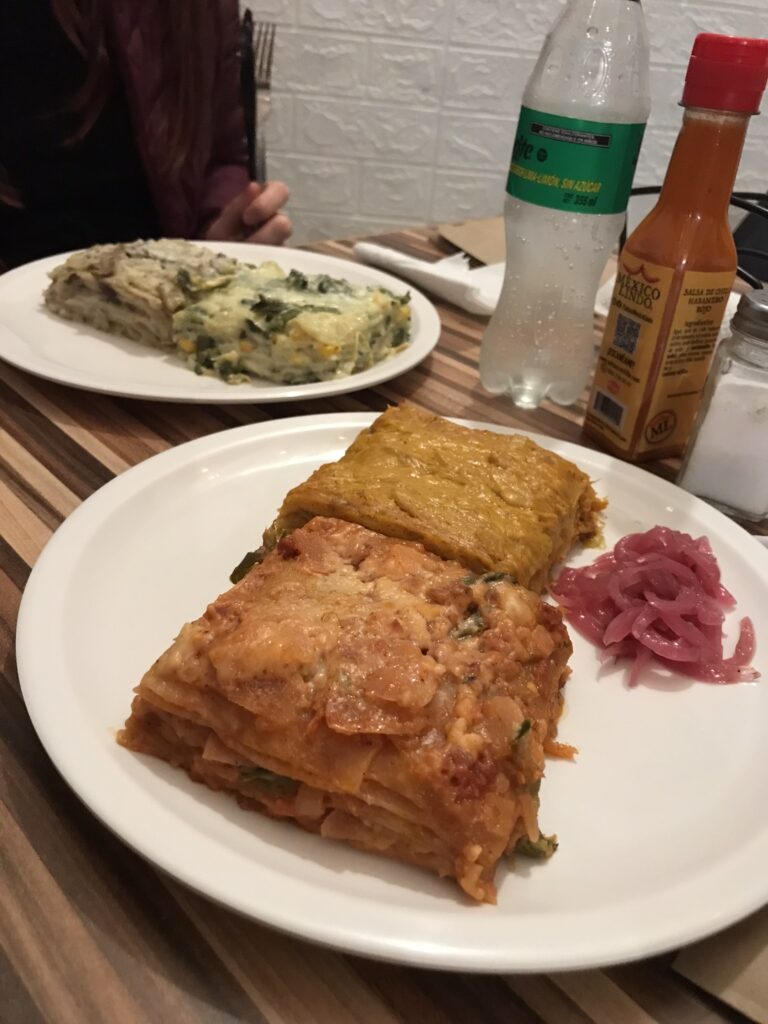
If you’re looking for comfort food look no further than Lasagna Center in Puebla
Comal – right in the Zocalo. We tried the mole here. To be honest this place was a little expensive for what we actually got.
Coco y El Alacrán – a quirky cafe slightly outside of the centre, we enjoyed a mole and cochinitia pibil torta and passionfruit Italian soda. This place mostly attracts a young crowd with skull-shaped glasses and interesting takes on Mexican classics.
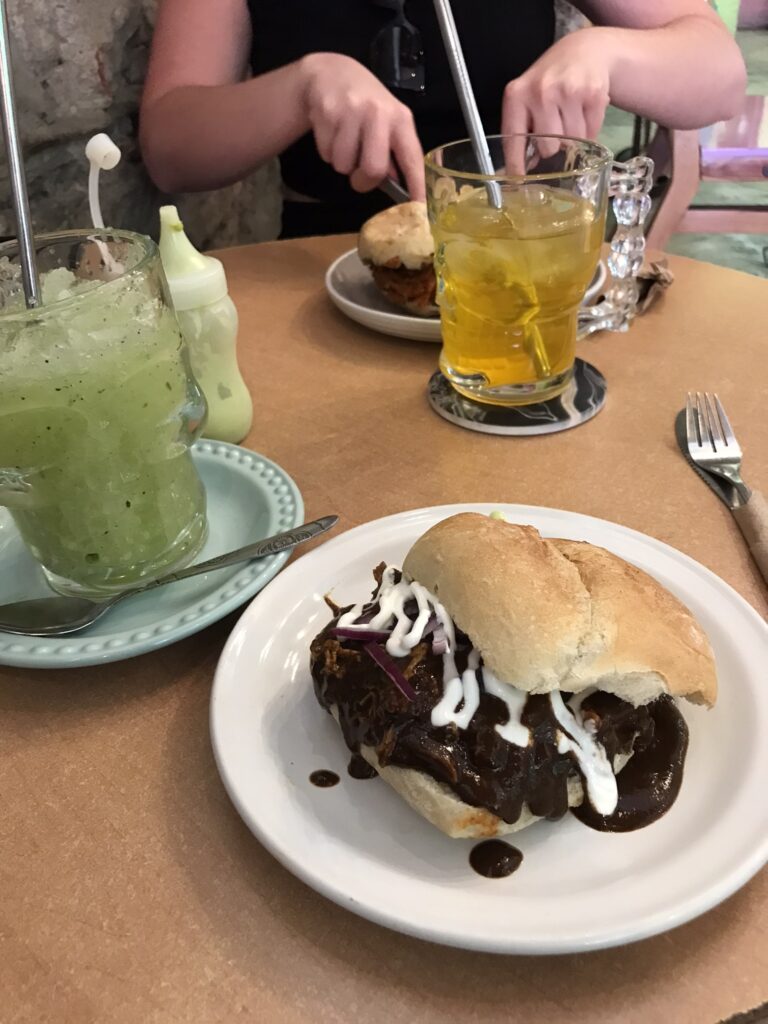
Coco y El Alacrán: A great place to fill up on cochinita pibil or mole tortas in Puebla
El Nahual Pulquería – a great place to try pulque in a variety of interesting flavours such as oatmeal, banana-chocolate, apple, marzipan and mint. Pulque is a thick pulpy drink, slightly alcoholic, made from the agave plant. We loved trying the different flavours at the pulqueria. I wouldn’t order food here as it took absolutely ages for our pizza to arrive (I’m talking close to 2 hours). The bartenders are friendly and willing to suggest combinations of pulque although there was definitely a lot of disorganisation with the food. Still, the pulque here was great and I would highly recommend it (but only for drinks!).
Activities
Guruwalk city walking tour including Street of Candies (traditional sweet shops selling all things sweet), Museo Regional De La Revolución (the facade is covered in bullet holes, previously a family home but now a museum about the Mexican Revolution and Puebla’s part in the movement), Artist Quarter (packed with mini-art studios tucked away into little cubby holes, a place where artists and art students hang out), Parian market (a good place to shop for souvenirs in the city), House of Culture of Puebla (contains an antique library filled with old tomes and volumes, you have to pay to enter the library or peek from the doorway) and the Cathedral (charcoal grey and imposing, not colourful like the rest of the historic centre).
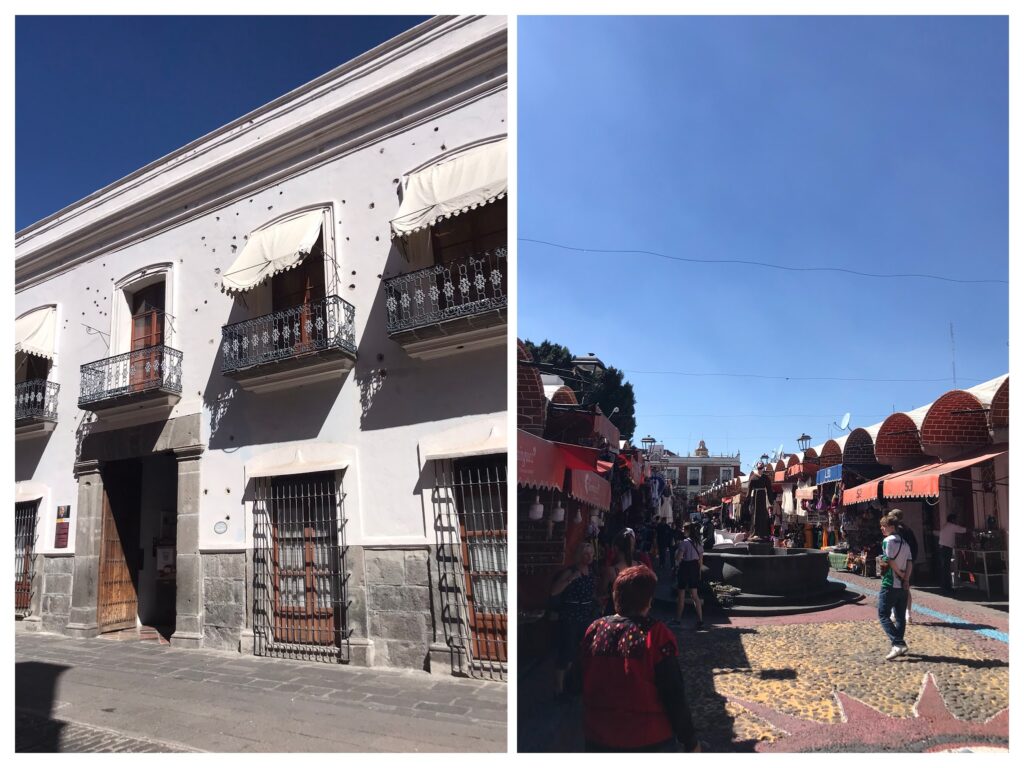
If you look closely you can actually see the bullet holes in the Museo Regional De La Revolución; the Artist Quarter is a great place to head if you want to buy some souvenirs
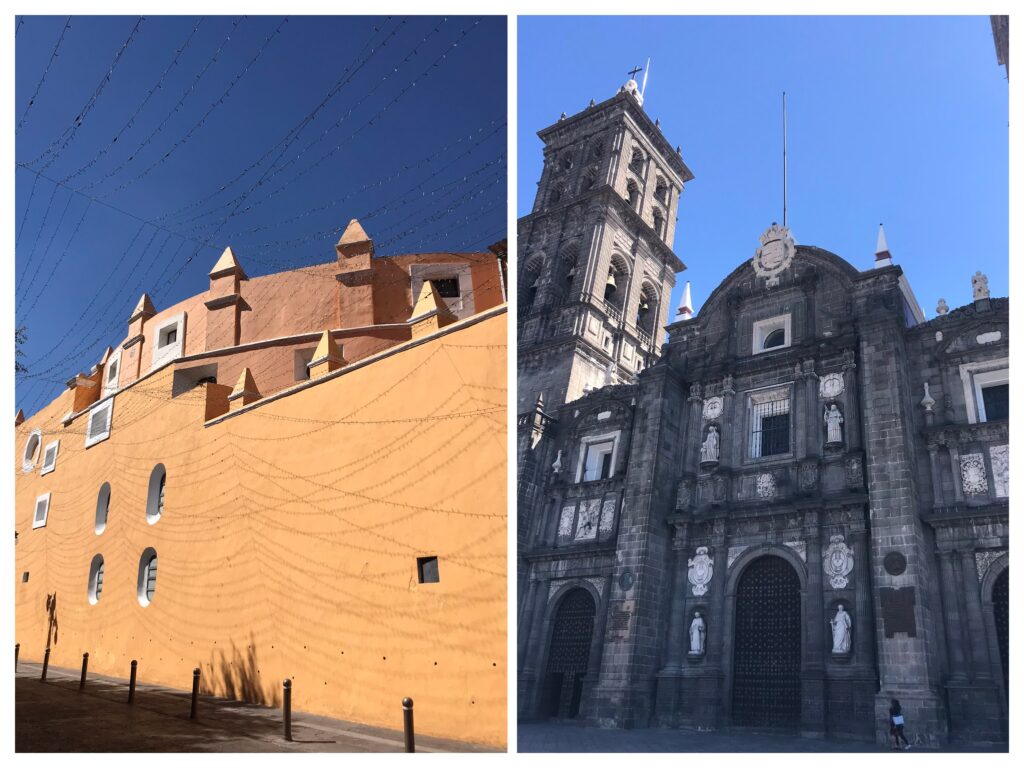
The Cathedral is rather dreary in comparison to other brightly coloured buildings in Puebla
Capilla del Rosario – this small chapel is located in the Templo de Santo Domingo in Puebla’s centro historico. If you ever wondered how much money the Catholic church had in colonial times, all you need to do is have a look at the golden interior of this chapel. Make sure to check the opening times as the Santo Domingo church closes sporadically throughout the day. We were told incorrect information about this by several people we asked.
Day trip to Cholula – Cholula is a pueblo magico just outside the city of Puebla. It is mostly known for its archaeological site, the Great Pyramid of Cholula, which by volume is the largest pyramid in the world. Sadly although it is the largest, this pyramid is far from the most spectacular in the world. Most of it is not excavated and from the outside it just looks like a big hill. The pyramid does have a visitors centre and some tunnels which I think are the main attraction archaeologically, but these were closed during our visit.
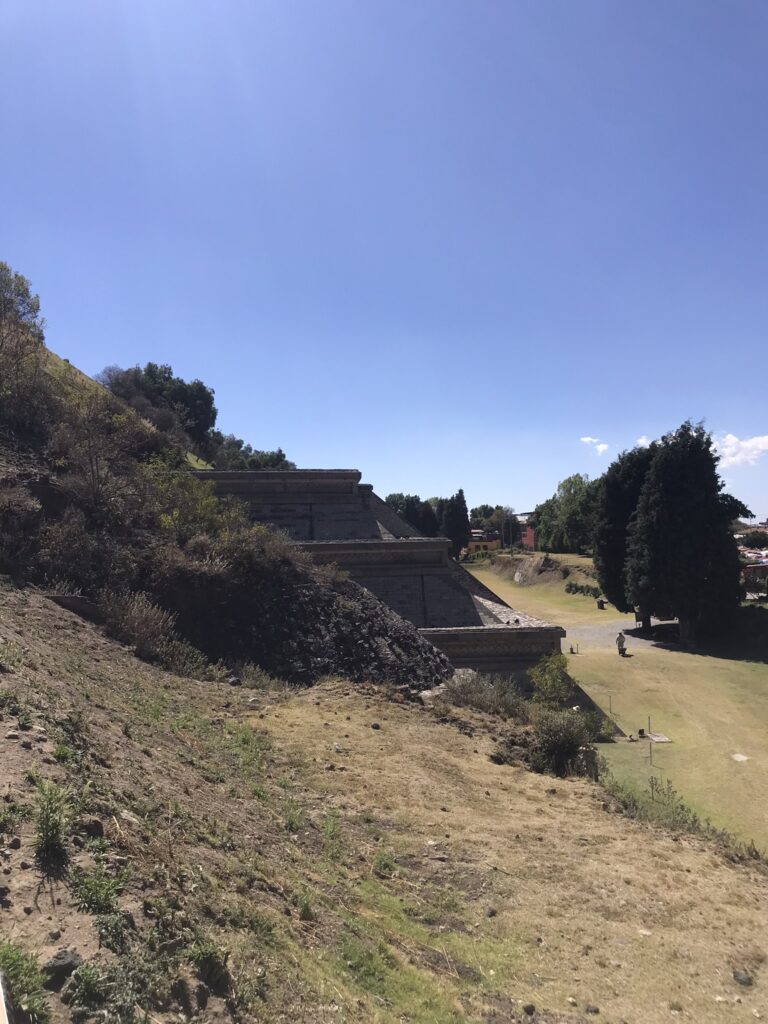
You can actually see the stepped pyramid peeking out from underneath the hill in Cholula
Although the tunnels were closed, it was still possible to walk up the pyramid (hill) to visit the church at the top. The church was built on top of the former sacred pyramid by the Spanish conquistadors to send a message of dominance to the local people, and to illustrate to them that the Catholic church would be replacing their previous religion. The walk up to the church wasn’t difficult at all and the views at the top were pretty cool, with several volcanoes visible in the distance as well as views of the city of Puebla and other surrounding settlements.
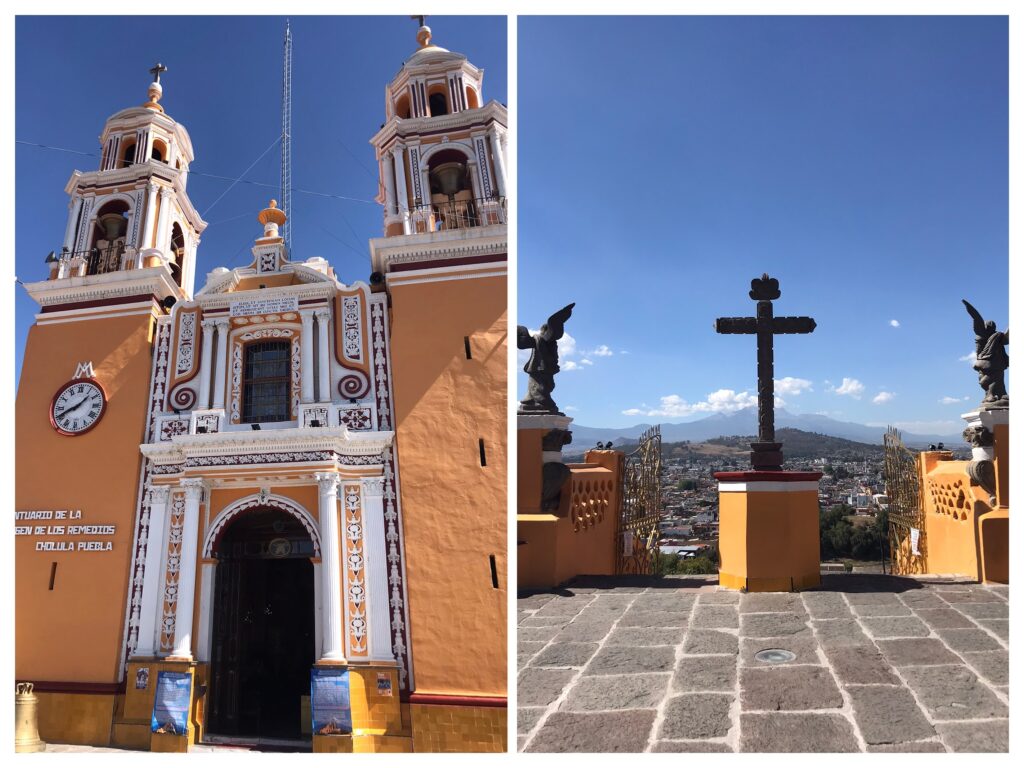
The church at the top of the hill in Cholula is quaint and very colourful
Other than the pyramid, Cholula is a charming town. We enjoyed relaxing in the main square, at one point a 1950s-style rock and roll band appeared and many of the locals immediately jumped up to enthusiastically dance to the music. They even tried to get us involved! Cholula is also known for its churches; there are several notable churches with interesting designs and facades in the surrounding area, although many of these are not easily walkable from the town centre unless you have a lot of time and motivation. We checked out the San Francisco convent close to the main square, which was well-worth a peek.

Roaming the streets of Cholula with a brief stop at the San Francisco convent
From Puebla we took the local bus to Cholula from the small bus station located here (19.051309267776265, -98.20575579797767). It wasn’t clear where the bus was going to stop in Cholula, so we just jumped out and walked once we decided we probably weren’t going to get any closer to the centre. We headed here to get the bus back to Puebla.
Foodie Places
Cemitas El Carmen – huge cemitas (the local Puebla state variety of torta) packed with fresh ingredients like stringy cheese, ham and avocado. Come hungry! We loved this place, it was really good quality, hearty, cheap food and the matronly owner/server was super friendly and kind. The best place we found to try traditional, authentic cemitas.
From Puebla to Oaxaca we enjoyed the bus journey through the Tehuacan-Cuicatlan Biosphere reserve, looking out of the window at all the cacti. If you have more time than us you could probably stop off nearby and properly explore the reserve.
Oaxaca
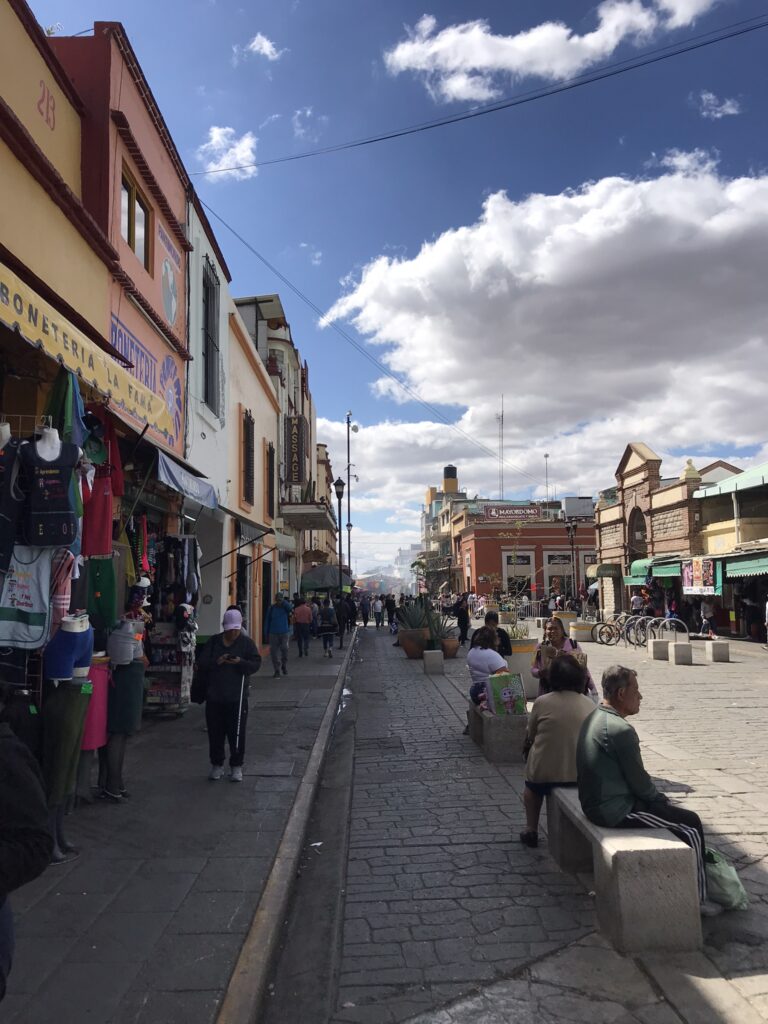
Mezcal heartland. Oaxaca is the second-poorest state in Mexico, but the city itself is relatively prosperous. We arrived to a protest against gentrification due to the overwhelming presence of expats in the city driving up prices for the locals. There is definitely some friction in the community over the issue. Still, Oaxaca heavily relies on tourism for a lot of its wealth and prosperity, and there were plenty of tourists here too. It is a mecca for foodies. Probably the most well-known export is mezcal, but it is also the home of Oaxaca cheese (which is omnipresent throughout Mexico) as well as mole. Dan tried at least three different varieties of mole in Oaxaca.
We enjoyed hanging out in the main square in Oaxaca, it was a vibrant place with a lot going on. Among other things in the square we encountered a large-scale orchestral musical performance, a guy dressed up in pre-Columbian clothing playing a panpipe and some guys reciting slam poetry. I believe there are both planned and unplanned events in the square every day, and the band performs every Sunday.
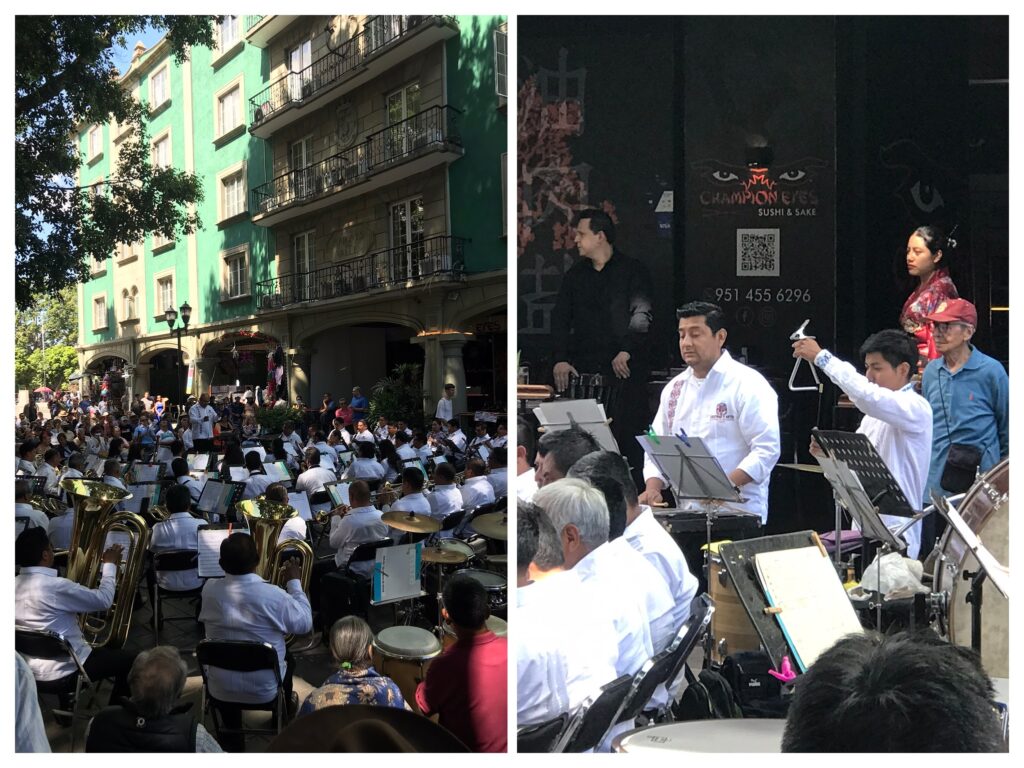
As you can imagine it came as a bit of a surprise to stumble upon a full orchestra complete with triangle-player in the main square in Oaxaca
Accommodation
Yabanhi Hostel and Bungalows – comfortable rooms and a great rooftop terrace with kitchen. You can see all the way to the main plaza, at night we saw fireworks over the plaza. The surrounding area can be sketchy at night with some cases of muggings reported but the hostel itself was secure and safe.
Foodie Places
Mercado 20 de Noviembre – the place to hit for delicious affordable street food, in particular you should try Tlayuda (crispy fried tortilla base with toppings such as bean paste, cheese and meat – almost like a crisp pizza) and mole negro (locals say it’s the best mole in Mexico).
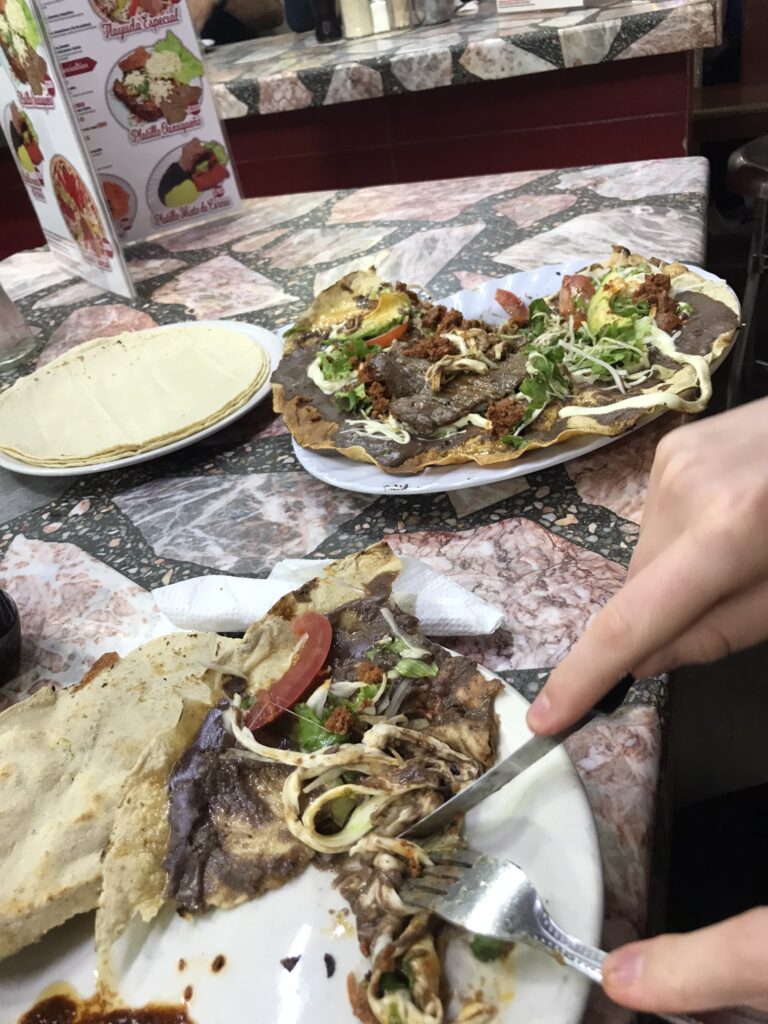
Hit the Mercado 20 de Noviembre up for delicious and affordable street food
BBQ street – the covered area at the end of Miguel Cabrera Street is a great place to try grilled meat (asado) and to have an intense and authentic local dining experience. When you walk into the asado section of the street you’re instantly hit with the smell of sizzling meat on the grill and the loud shouts and cries of the many vendors all trying to get you to look at their menu. It’s an assault of the senses and very overwhelming. You won’t find any carbs on the menu except for tortillas, there are no french fries or bread. You can choose various BBQ combos and small salad accompaniments like avocado, aubergine and fried shallots. After ordering you’ll likely be squeezed onto a small table in close quarters with a bunch of other patrons. We traded accompaniments and sauces with a couple of local builder guys who were crammed in next to us happily enjoying their meat.
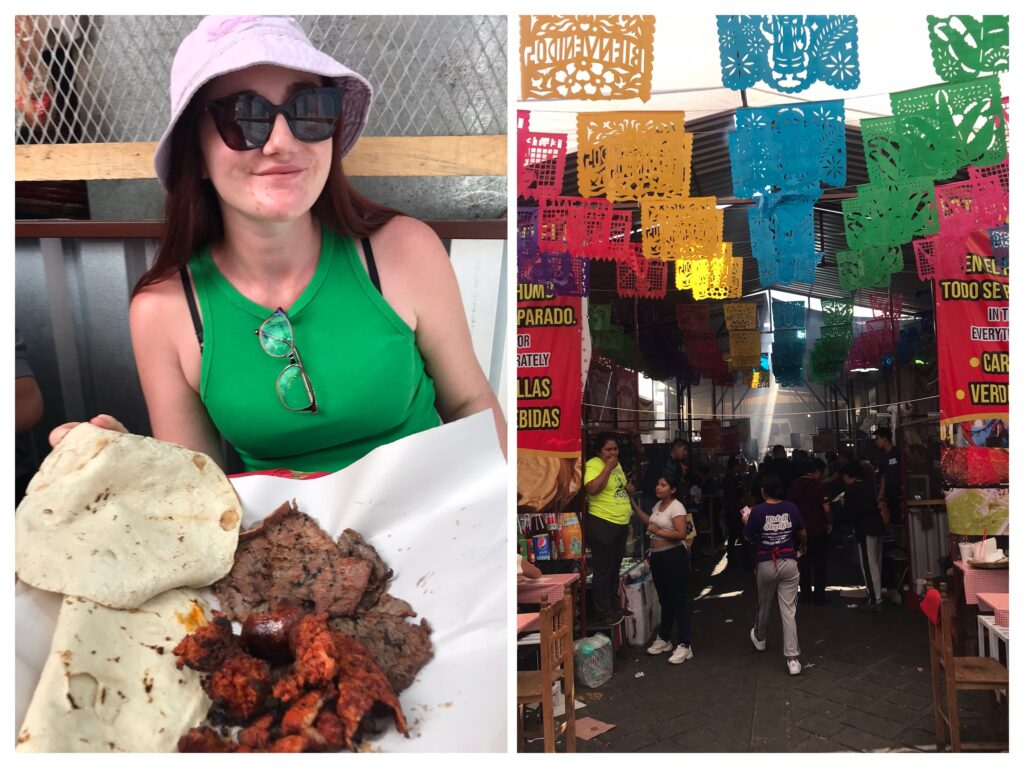
As a rule of thumb – eat where the locals eat and this place is definitely one of them.
Chocolate Mayordomo – a popular chocolate shop chain serving ‘the best’ ice-cold chocolate drink.
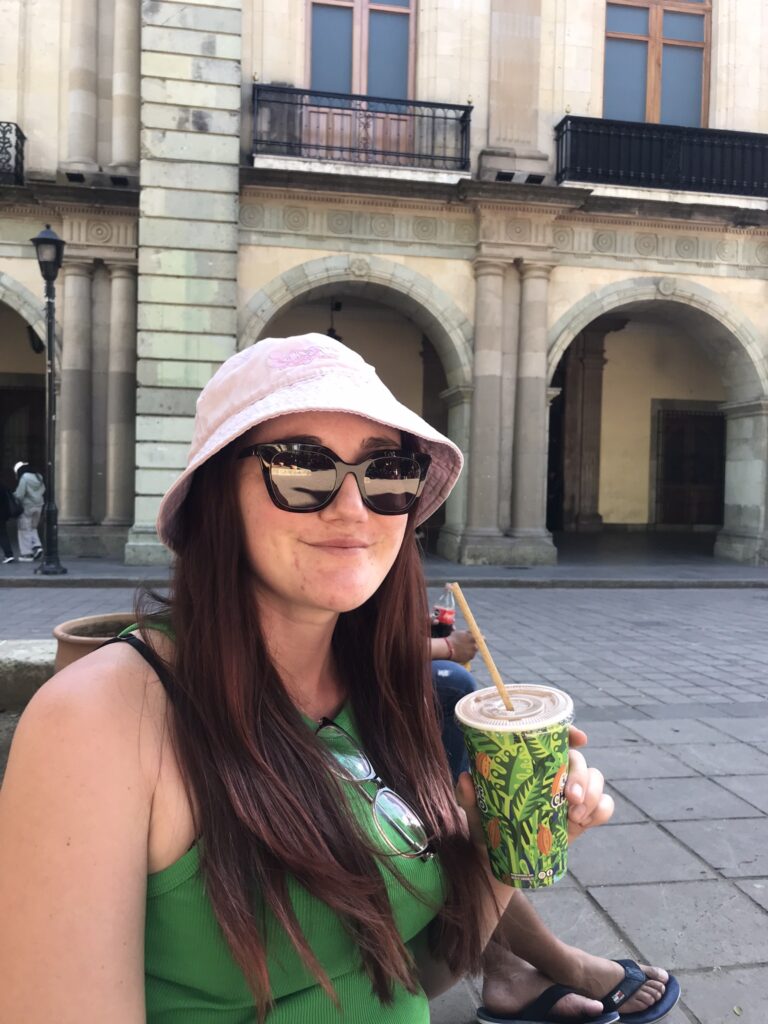
We couldn’t get enough of these iced chocolate drinks from Mayordomo in Oaxaca
Activities
Guruwalk city walking tour, which mainly provided an orientation of the main churches/squares as well as info about the culture and history of the city.
Building where Porfirio Diaz was born – the controversial former president (some call him a dictator) was born in Oaxaca, there is a plaque marking the building which is at times surrounded by anarchistic graffiti. Not really an attraction as such but an interesting thing to spot while walking past.
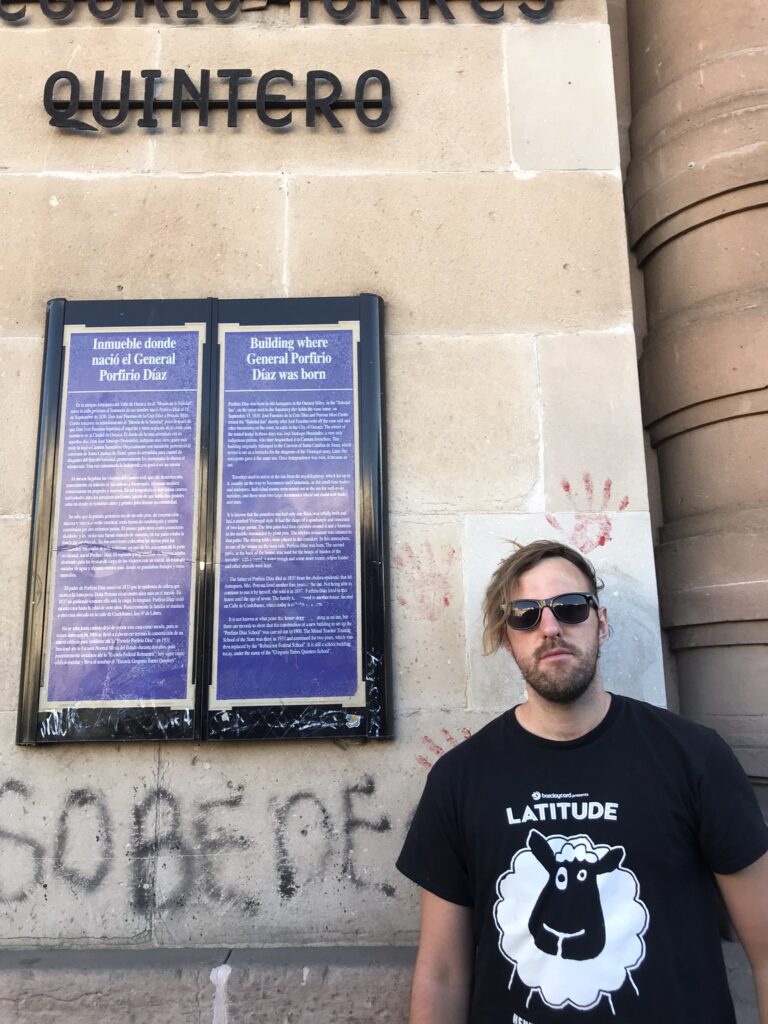
Bloody handprints cover the building where Porfirio Diaz was born
Lucha libre at Arena Pepe Cisneros – this was an indie wrestling show, the actual name of the promotion wasn’t clear as all the promotional material just displayed the name of the arena. The ‘arena’ was actually just a large gymnasium. The setup wasn’t as professional as the big companies in Mexico City, the audience was basically crowded into the gymnasium on plastic chairs. There was a raised viewing platform with reserved seating available for a little extra money but we had a pretty good view from the general admission. We arrived early to the show and had to wait ages for it to start as there was only one lady selling tickets, which caused a big queue. The show was a little late starting and continued quite late into the evening as a result. The audience was a mix of locals and gringos, it was basically sold out and everyone seemed to be having a good time. Beer and snacks weren’t overpriced like in the big arenas in Mexico City, which helped. The lucha action mainly consisted of matches between local wrestlers but it was fun and a good standard, and for people who closely follow lucha libre this promotion does seem to be able to attract one or two nationally-recognised stars per show. Keep an eye out for the promotional posters around town in Oaxaca, as they will be advertising the details of the next match.
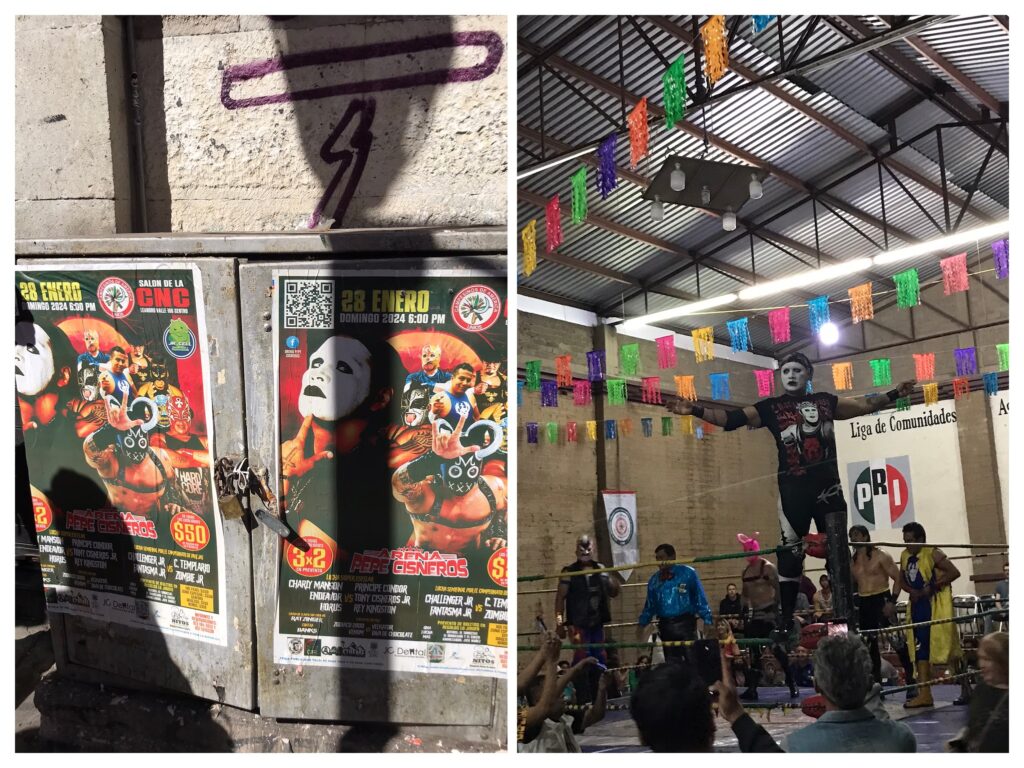
Keep an eye out for posters around the city centre advertising lucha libre matches
Day trip to Monte Alban – Monte Alban is one of Mexico’s most well-known and important pre-Columbian archaeological sites. Similar to Teotihuacan, it was one of Mexico’s oldest and largest cities, the home of a lost civilization. The city was abandoned hundreds of years before the arrival of the Spanish to the area. Just like Teotihuacan, the name Monte Alban is not the original name of the city, which is unknown. Today Monte Alban is a vast archaeological complex on the top of a hill. There are huge monumental structures and sweeping vistas over the nearby countryside.
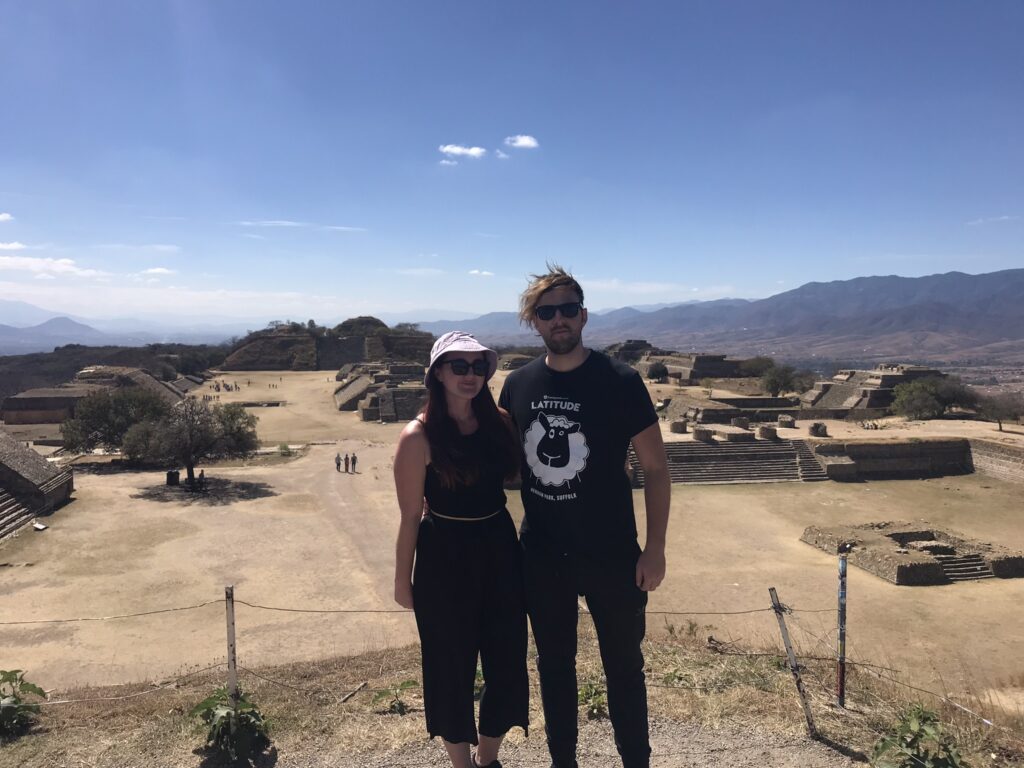
Monte Alban is a vast archaeological complex with many temples situated on a hill close to Oaxaca
From the centre of Oaxaca we got a cheap shuttle bus to Monte Alban, which departs regularly from outside the Hotel Rivera del Angel (located here). There was some conflicting info about the bus times, we were told it was supposed to depart every hour on the hour but we arrived 10 minutes late and the bus was still there. We were able to quickly jump on just before it left. The bus driver sells open return tickets and there should be a departure and a return from Monte Alban every hour. Overall I think this is definitely the easiest way to get to the site. We spent just over three hours at the site in total checking out the many impressive structures and platforms, there is also a small onsite museum. Guides are available at the entrance but there are also information plaques in English around the site.
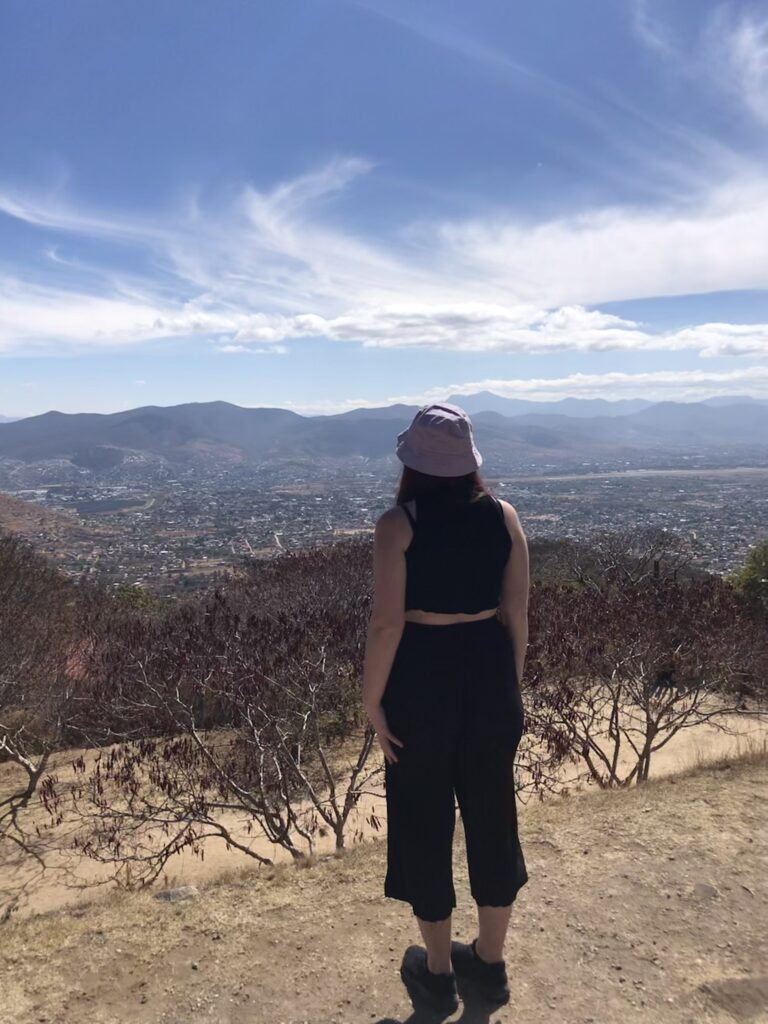
The view from Monte Alban over the valley below is stunning
Mezcal Tasting Room by Gül-Roo – the most affordable mezcal tasting I could find in Oaxaca, booked via Instagram as the building isn’t always open. We tasted, I believe, 13 different mezcals and the host was very good, providing a lot of info about each of the mezcals as well as mezcal in general, its history and local production. There were many different flavours of mezcal to try, even mole mezcal. I also really liked the nibbles such as cocoa nibs, plantain chips and nuts which were paired with some of the mezcals.
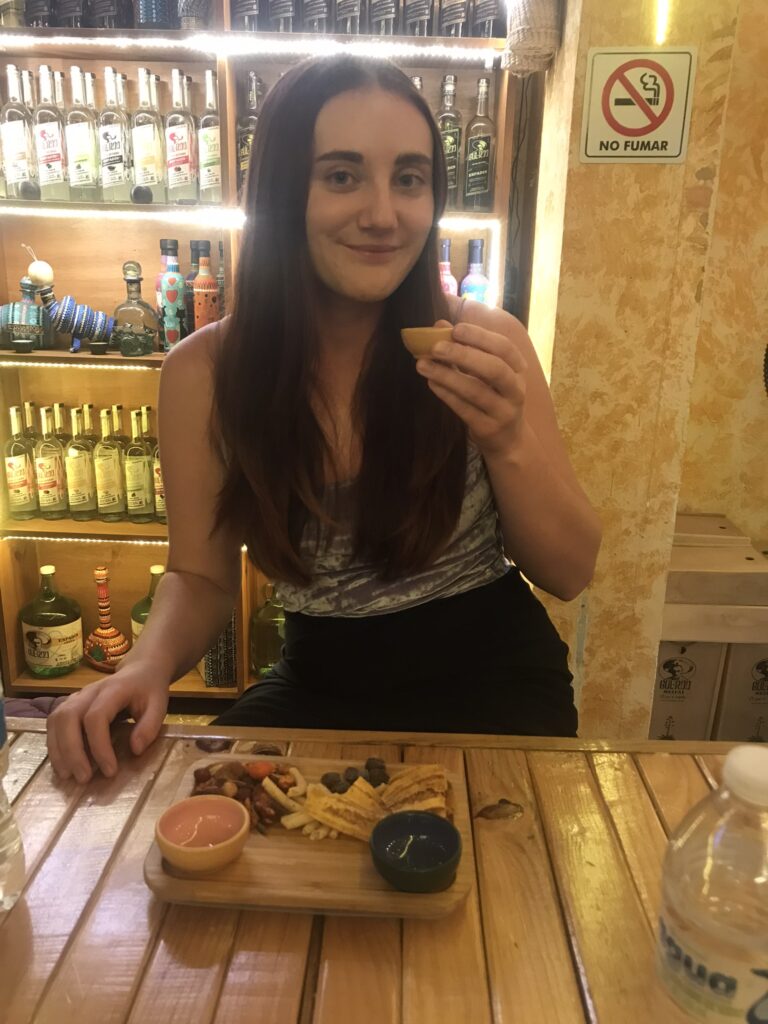
We even tried mole flavoured mezcal at Mezcal Tasting Room by Gül-Roo
Museum of Cultures at Santo Domingo Convent – this museum is located in a former convent building. Like most ‘exconvent’ museums in Mexico, it was of a pretty good quality with lots of local artefacts from the prehispanic and colonial periods. The most famous room here is the one containing the artefacts that were found in a regal burial tomb (tomb 7) at Monte Alban, including lots of intricate golden pieces and a magnificent decorated skull.
Xochimilco neighbourhood – we took the opportunity to have a walk around the Xochimilco neighbourhood, which is known for its street art. It is a quiet neighbourhood and there were some really cool and interesting murals here.
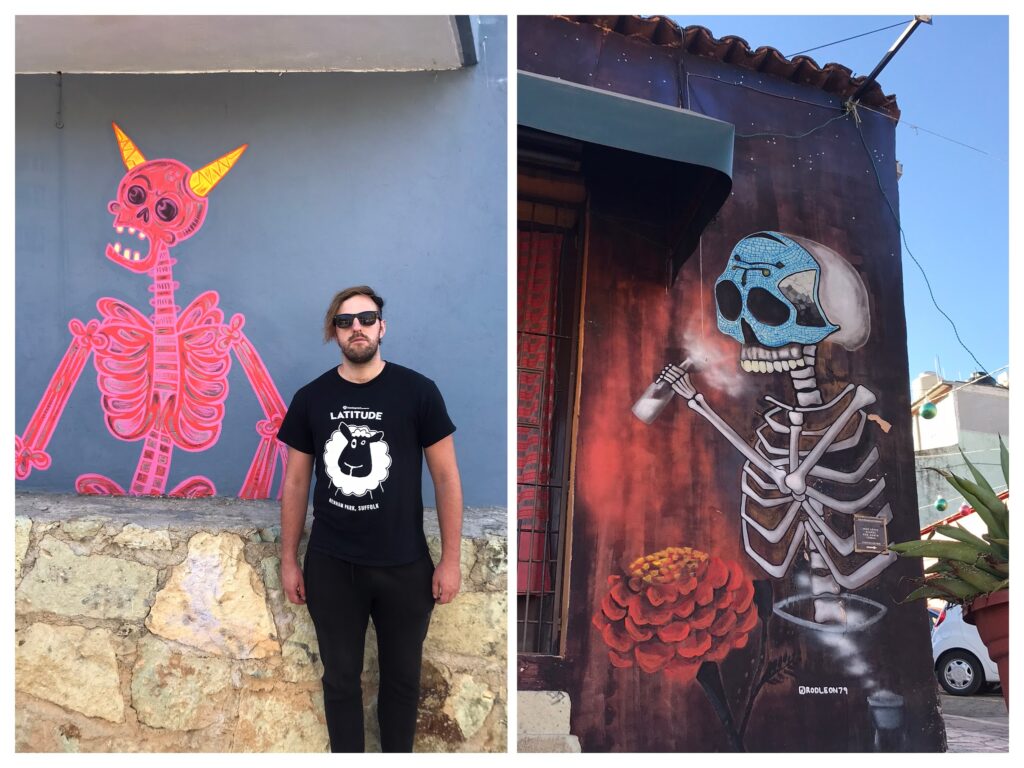
Head to the Xochimilco neighbourhood to check out some seriously impressive Oaxacan street art
Day trip to Mitla and Hierve el Agua – we were going to attempt a DIY trip to Mitla, Hierve el Agua and the Yagul archaeological site in a day, but in the end we spent so long waiting at the bus station for the bus to Yagul that we decided we wouldn’t have enough time to complete the trip. We gave up and booked an organised group tour for the following day instead, which to be honest was a reasonable enough price and a lot more convenient. We booked the trip through the tour agency located in the lobby of Hotel Rivera del Angel (the same place that the shuttle bus to Monte Alban departs from). If you do want to make your own way, you can get a bus to Mitla from the Terminal de Abastos here, and then from Mitla I believe there is onward travel to Hierve el Agua in a shared colectivo/jeep. Just make sure you set off early if you do want to do it all in one day, unlike us.
As well as Mitla and Hierve el Agua, the group tour also included a brief stop at Tule. Tule is the home of the widest tree in the world, situated in a courtyard in front of a church. There is a small admission fee to enter the courtyard for people who want to get up close and personal with the tree, but there isn’t really any reason to enter other than to look at the tree and you can see it well enough through the fence. After Tule we also stopped off nearby for a weaving demonstration by a local family, and some people bought rugs from them. Apparently some of the designs are so intricate that it can take up to a year to make one rug.
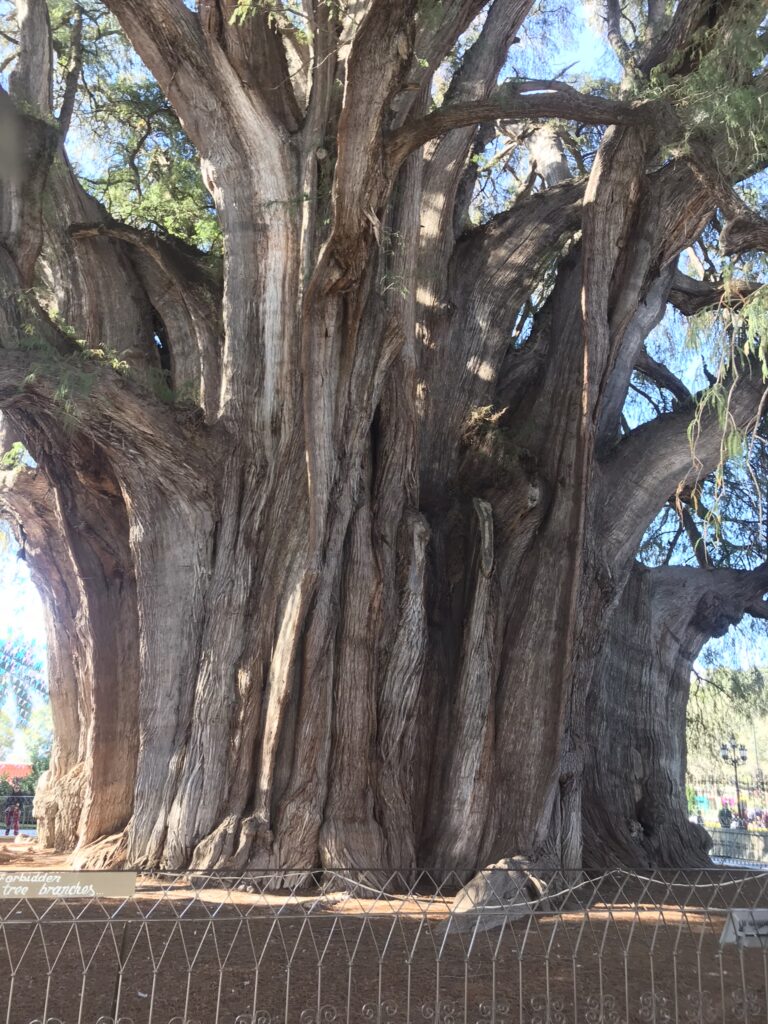
Widest tree in the world at Tule
We eventually headed to Mitla archaeological site, which is mostly known for the fascinating geometric designs on the buildings, and then to Hierve el Agua, which is a lot more remote than I was expecting.
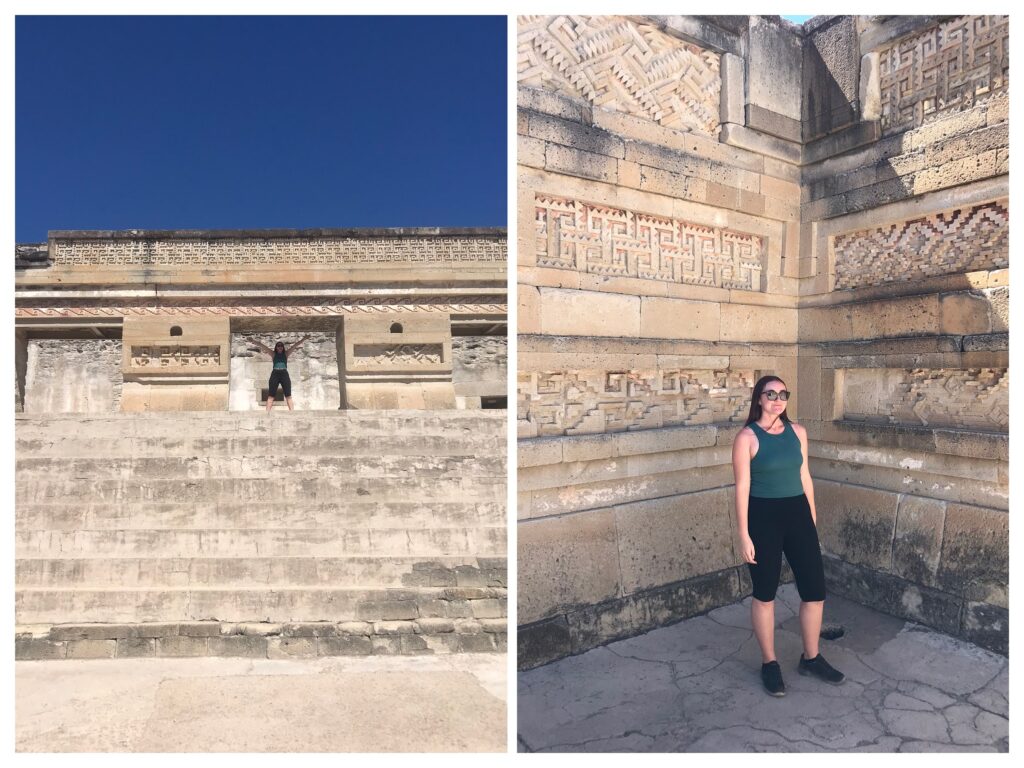
Exploring the archaeological site of Mitla
We didn’t fancy going for a swim at Hierve el Agua because the water didn’t look very clean, instead we just walked around and enjoyed the fantastic views. Head to the top of the hill overlooking the main area for the best views of the petrified waterfall and valley below.
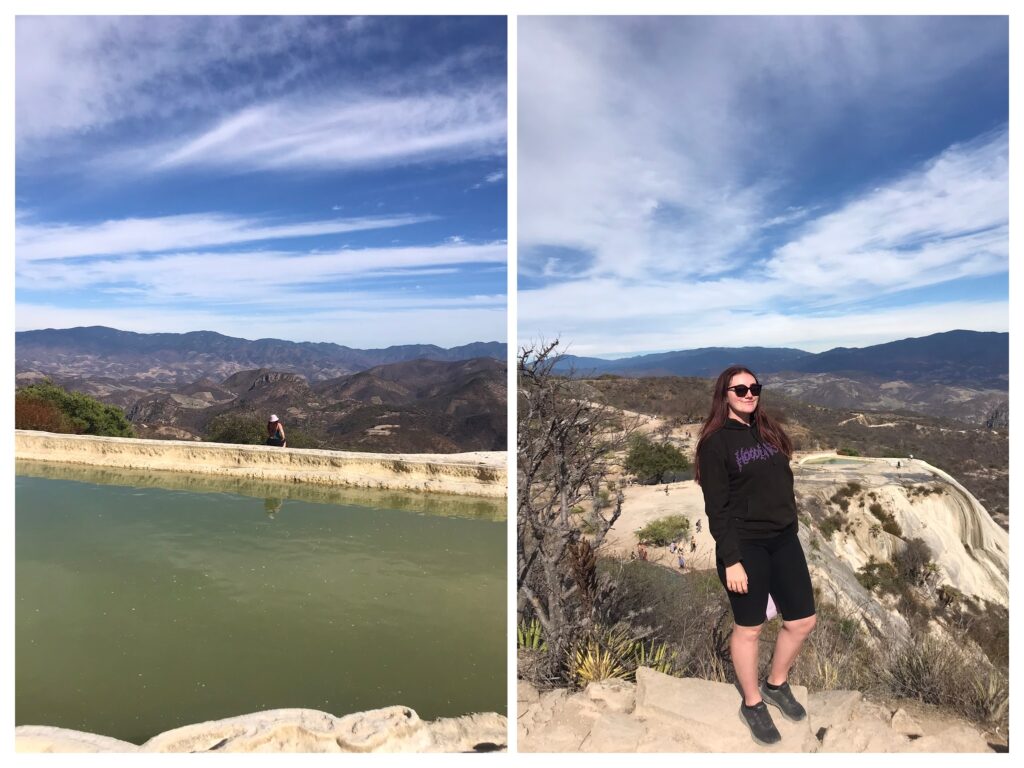
Admiring the petrified waterfall at Hierve el Agua from afar
Hierve el Agua is full of signs warning of the dangers of falling over the edge. We watched some tourists get dangerously close and even saw one group climbing down the waterfall, mad! After Hierve el Agua the group tour finished with a stop at a mezcal distillery with a quick tasting. Overall this tour was probably a more rewarding and less stressful experience than trying to arrange our own transport to and from all these places. The route passes by many agave fields and mezcal distilleries and it was nice to be able to enjoy the day without worrying about transport logistics.
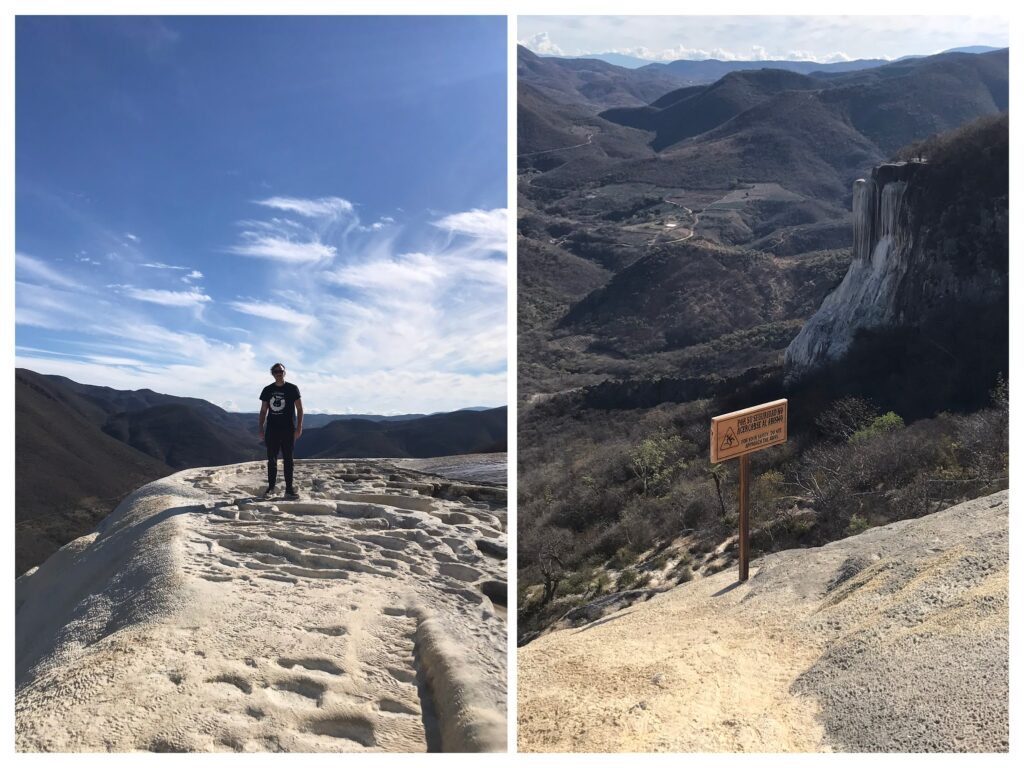
Beware of the steep drop over the edge of the waterfall
San Cristóbal de las Casas
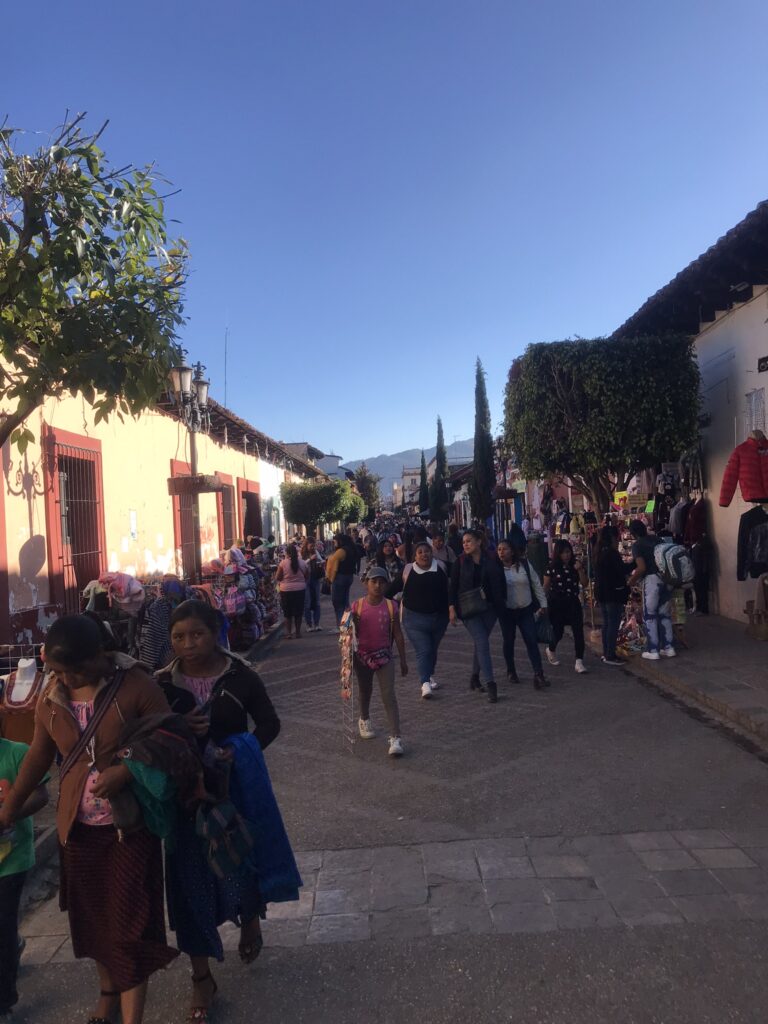
San Cristóbal de las Casas is the former capital of Chiapas, which is the poorest state in Mexico and one of the most unique. Culturally, we found that Chiapas seemed to have more in common with Guatemala than the rest of Mexico. In fact, Chiapas was actually considered to be part of Guatemala during the colonial times.
The state has a large indigenous population and indigenous culture dominates the city of San Cristobal and the surrounding regions. While San Cristobal initially looks like a typical Mexican town with its city planning and colonial architecture, there is a strong and visible indigenous presence in the city. If you look closely you can see that Mayan symbols are built into the walkways in the city centre.
Indigenous women from the nearby communities travel to San Cristobal to sell their handmade crafts in the streets. At night the main square is transformed into a huge market, with the women displaying their wares on mats on the ground. The indigenous communities all have their own unique styles of dress, and it is easy to spot many indigenous people from the nearby towns and communities in the city centre of San Cristobal along with a varied mix of expats, tourists and Mexicans from other parts of the country.
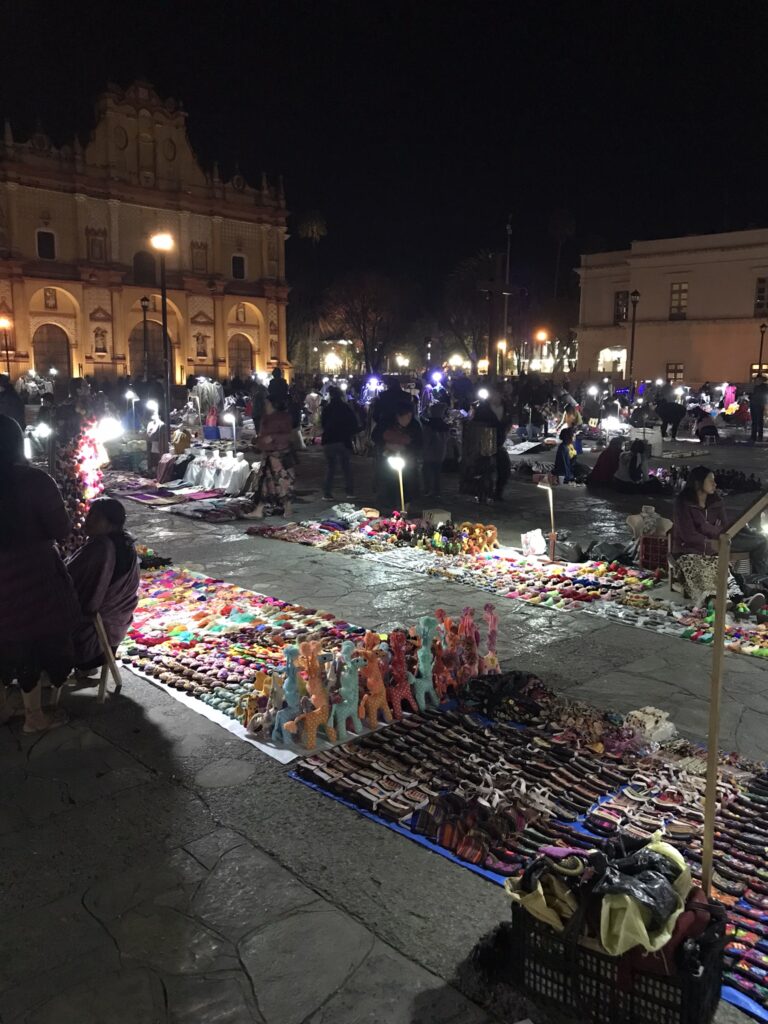
The night market outside the Cathedral in San Cristobal de las Casas
Chiapas state is known throughout Mexico as the home of the Zapatista movement, a peasant uprising that occurred in the 1990s when local farmers and workers rebelled against the government and occupied several towns in the area, including San Cristobal de las Casas. Prior to this, the indigenous communities of Chiapas had been largely ignored/forgotten and even actively oppressed by the Mexican state. We heard first hand how indigenous people in San Cristobal were previously treated as second-class citizens, they were expected to move out of the way if a Mexican was passing by on the street and so on. There were allegations that the government had sold the local people and their resources out to major corporations and that companies like Coca-Cola were draining water sources that were previously used by local communities, forcing the people to buy bottled water and further increasing poverty in the region. While the Zapatistas are no longer at war with the Mexican government, Zapatista sentiments and support for the Zapatista movement is still strong in San Cristobal. We visited a shop where you could buy Zapatista souvenirs, with profits going to the movement which continues to fight for government accountability and local indigenous rights.
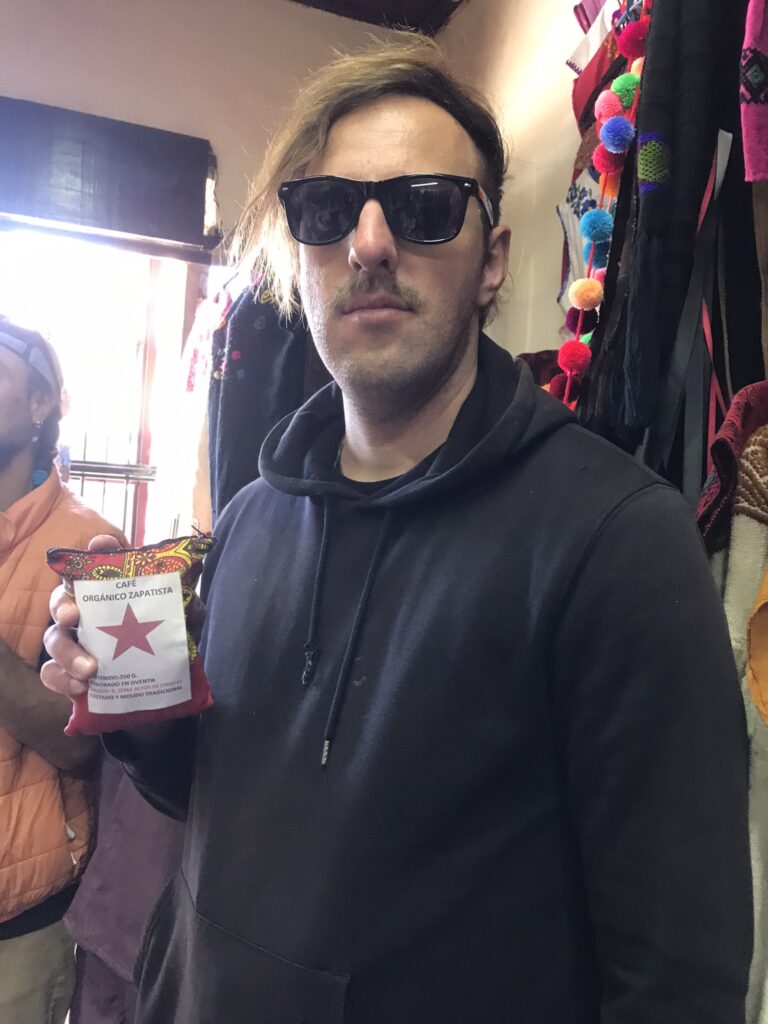
Dan proudly displaying some Zapatista coffee – all proceeds from the sale go towards the Zapatista movement
While there is an expat community in San Cristobal, it wasn’t as visible as in some other Mexican cities. The city felt like a bit of a meeting point of indigenous and more cosmopolitan cultures, and generally seemed to have a positive community atmosphere despite the wide mix of people from different backgrounds.
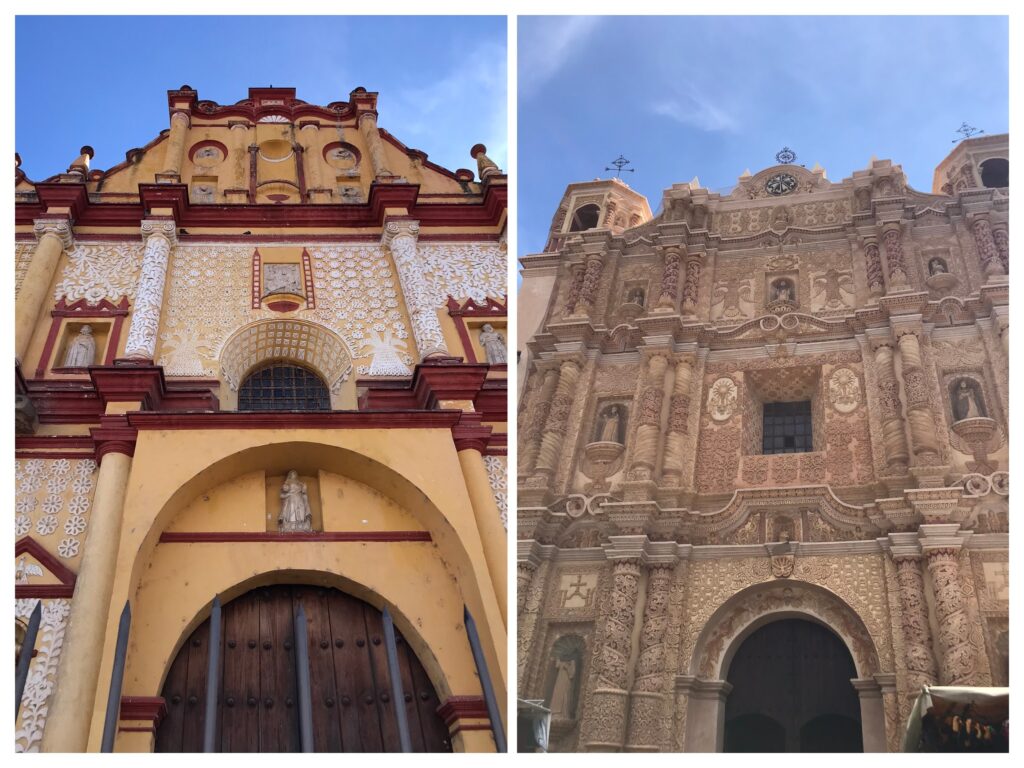
Ornate churches in San Cristobal de las Casas
Because of its rural, mountainous location, San Cristobal de las Casas can be a little difficult to get to. The only available option to travel directly from Oaxaca when we visited was a night bus. When travelling on to our next destination (Palenque) we had to take a long route round via the state capital Tuxtla Gutierrez and Sumidero Canyon, as most reputable bus companies will not pass through the centre of Chiapas for safety reasons. Sumidero Canyon is a popular destination or day trip in its own right, but we didn’t have enough time to visit other than passing through on the bus.
It’s widely publicised that coca cola has created issues in this area but overusing the water supply which has then resulted in droughts in local indigenous communities. Coca cola is seen as the enemy here – stealing water from local communities and then selling them sugary drinks instead. This area of Mexico consumes the highest amount of Coca Cola per person and its consumption is intrinsically linked with daily life and religious rituals.
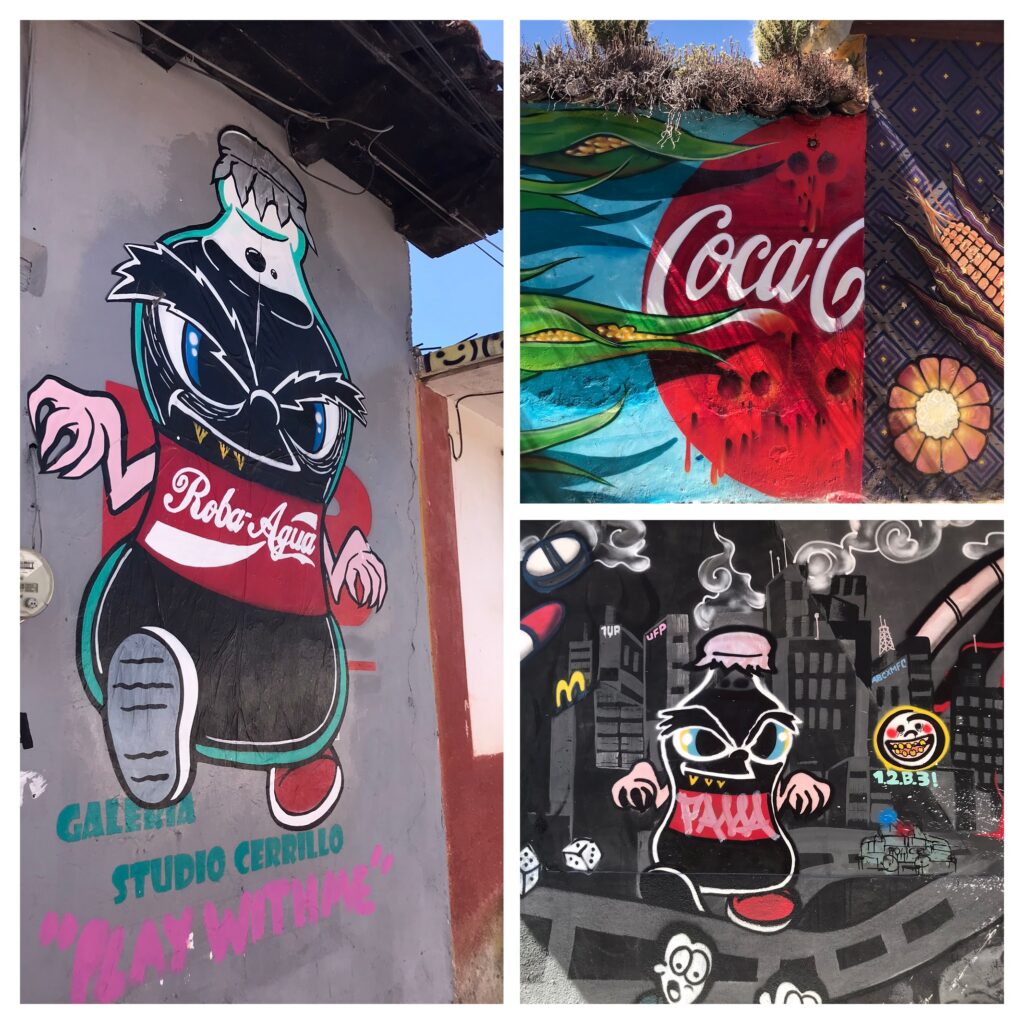
Coca Cola as the villain, as seen in street art in San Cristobal de las Casas
Accommodation
La Abuelita Hostal & Terraza – popular hostel with a shared kitchen. We saw several people without bookings being turned away as the hostel was full. They let us store our luggage and shower when we arrived first thing in the morning after our night bus, but we couldn’t check into our rooms early as they were still occupied from the night before. We also booked a trip to Chamula and Zinacantan through the hostel, which turned out to be one of the best and most memorable experiences we had in Mexico.
Magic Oven – delicious bakery close to the main square, the prices were slightly above average but the baked goods were top quality. A great place to grab a breakfast pastry before heading on the walking tour if you arrive on the night bus like us.
Xocol-Na Chocolate & Churros Cafeteria – we had a late night snack of thin churros with dipping chocolate. The hot chocolate was served in clay mugs in a rustic style. There was a local family with children running around, it seemed quite a local place.
Click – cheap tacos with a huge variety of sauces available, lined up from the least spicy (pineapple relish) to the most spicy.
La Casa De Las Lolas – we really missed heading to Lolas after we left San Cristobal. The food was incredibly tasty and very affordable with a huge range of options. The cheese and ham quesadillas were great! We ate here numerous times. The breakfast deal was particularly good as it included a breakfast dish, juice, hot drink and toast. There are lunch deals too which include a juice of the day, main meal and dessert of the day. The meals also came with free tortilla crisps and dips (sour cream, chiapas cheese and tomato salsa) – a great starter!
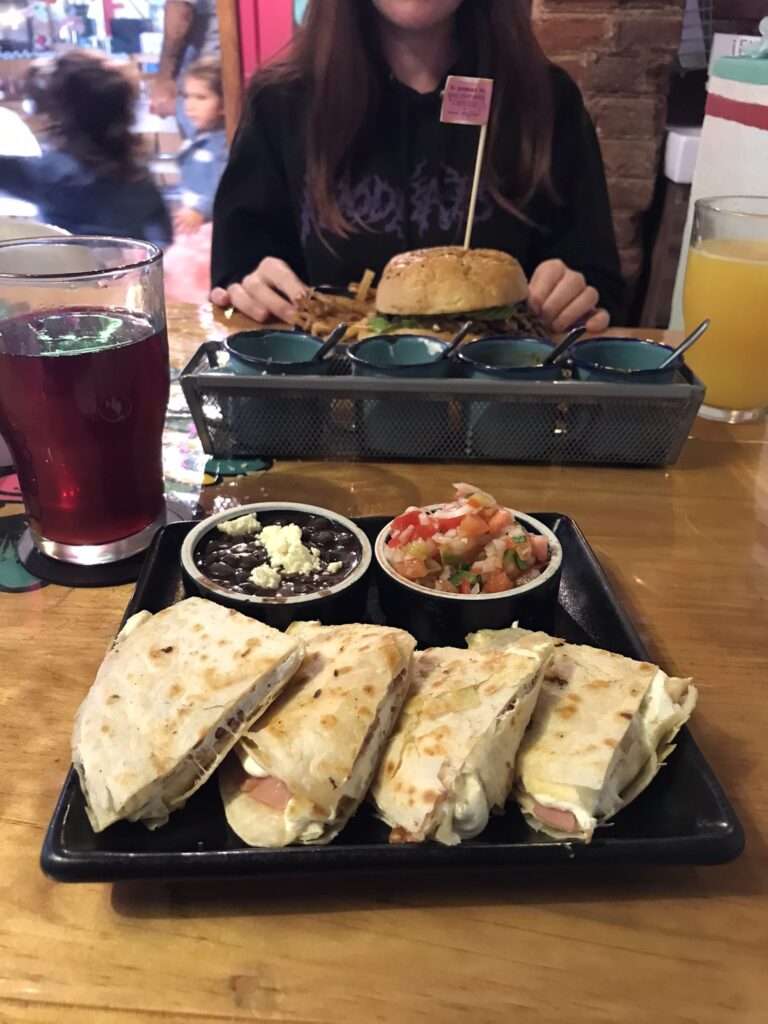
The quesadillas were to die for at Casa de las Lolas!
Activities
Free walking tour with pox tasting – the tour leaves from here, we just turned up after our night bus and were accepted on the tour but it’s probably best to make an advance booking if possible. The walking tour guide was a very interesting, eccentric character, the tour was fun and we learned a lot about the city and state. The tour also included a tasting of pox (pronounced ‘posh’), a local alcoholic spirit which is popular in Chiapas.
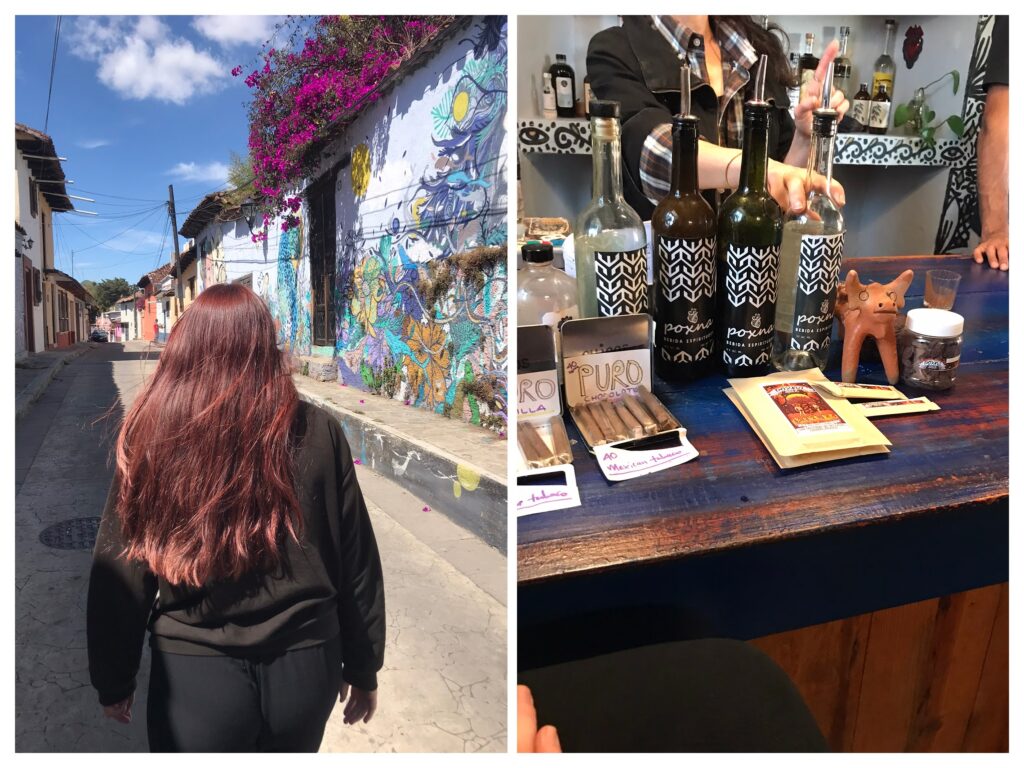
You can’t beat a guided walking tour to learn about local culture, history and fermented spirits!
Chamula and Zinacantan trip – we booked this activity through our hostel, La Abuelita. If you only do one thing in San Cristobal it has to be this tour.
Chamula and Zinacantan are indigenous towns near to San Cristobal. The indigenous communities are given a type of unofficial autonomous status by the Mexican government and are effectively allowed to organise and police themselves. State intervention is minimal and outsiders are not able to join the communities. There are many strict customs that locals must follow to remain accepted in their communities, or they risk being banished. The people of these communities effectively have their own type of religion, which is a unique fusion of indigenous and Catholic beliefs. Chamula is best known for its infamous church where the ritual sacrifice of chickens is commonplace, but there are many other fascinating aspects about the towns and communities too.
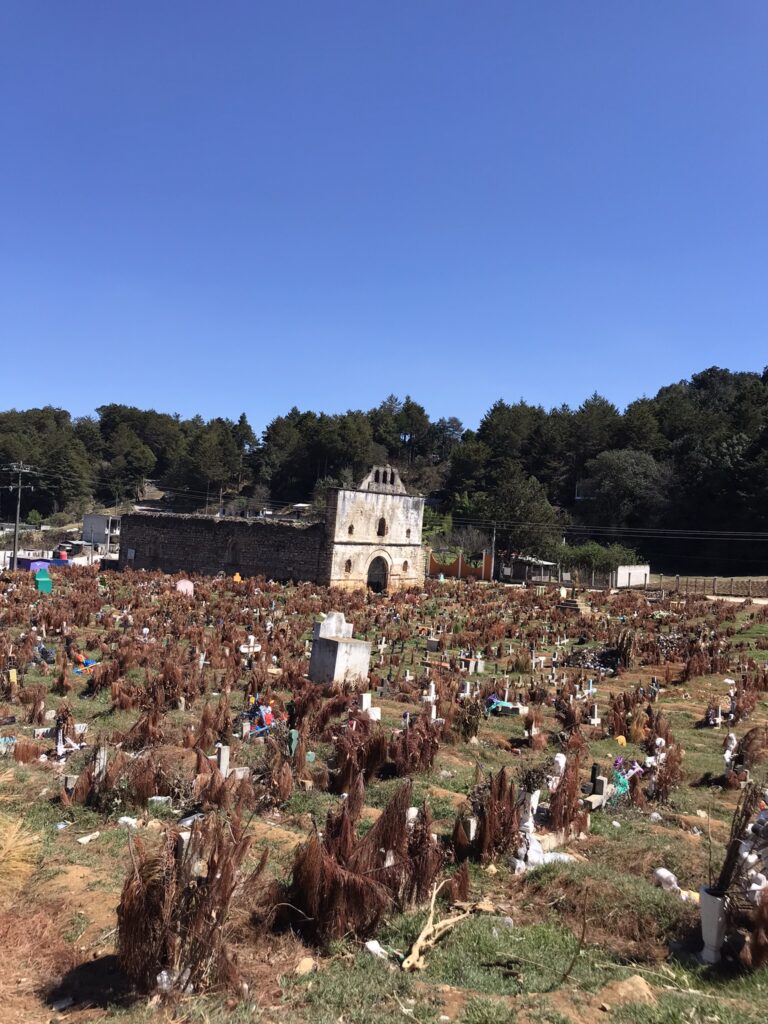
The graveyard in Chamula is dotted with palm branches
The indigenous towns police themselves, they have their own rules and punishments. We heard that there was one public lynching in the main square in Chamula in the last 5 years. Chamula has a small jail in the back of the town hall, where drunks and people who commit crimes are held for up to 3 days. The jail is visible from the street and you can see the prisoners inside as it is also intended to be a public shame for those who have committed crimes or misdemeanours. The stench of urine from the jail was notable. There was one forlorn-looking guy already in the jail cell when we got there, and we actually saw another man being taken to the jail by the local community police a couple of minutes later while we were heading towards the church square. The police and local council men wear special clothes (white sheepskin or black sheepskin vests) to differentiate themselves from the regular residents. We saw a morning council and police meeting where they finished by drinking shots of pox for good luck/protection before heading out to duty. We were offered some pox too by one of the council guys and happily accepted.
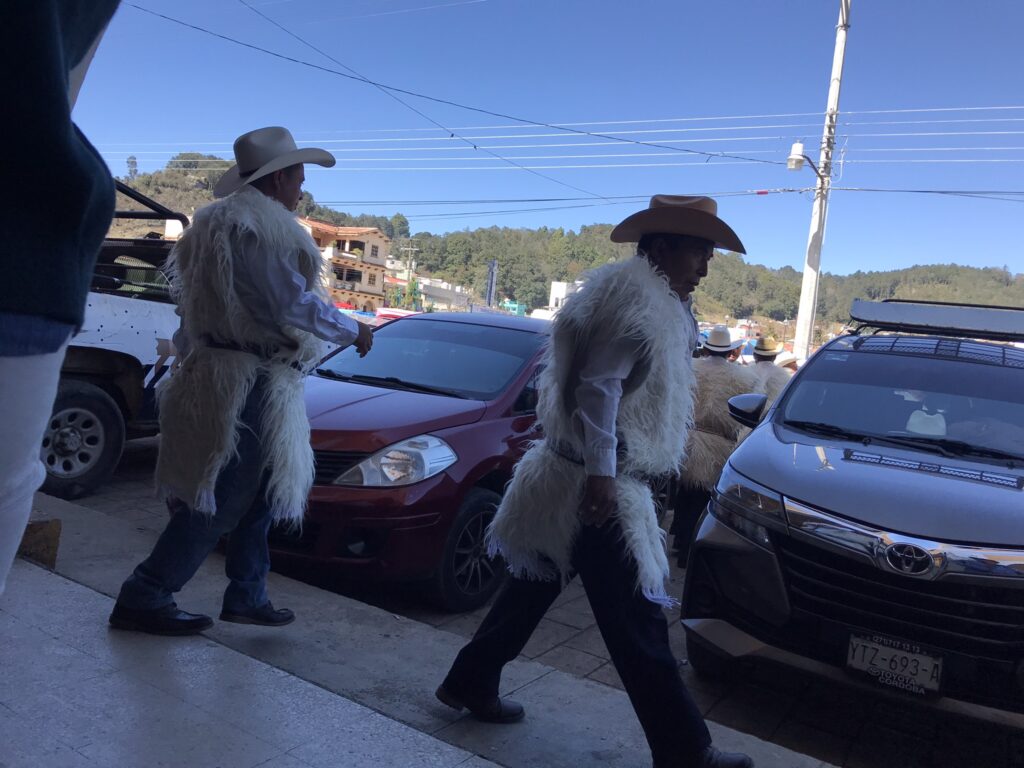
Local council members wearing their traditional sheepskin vest
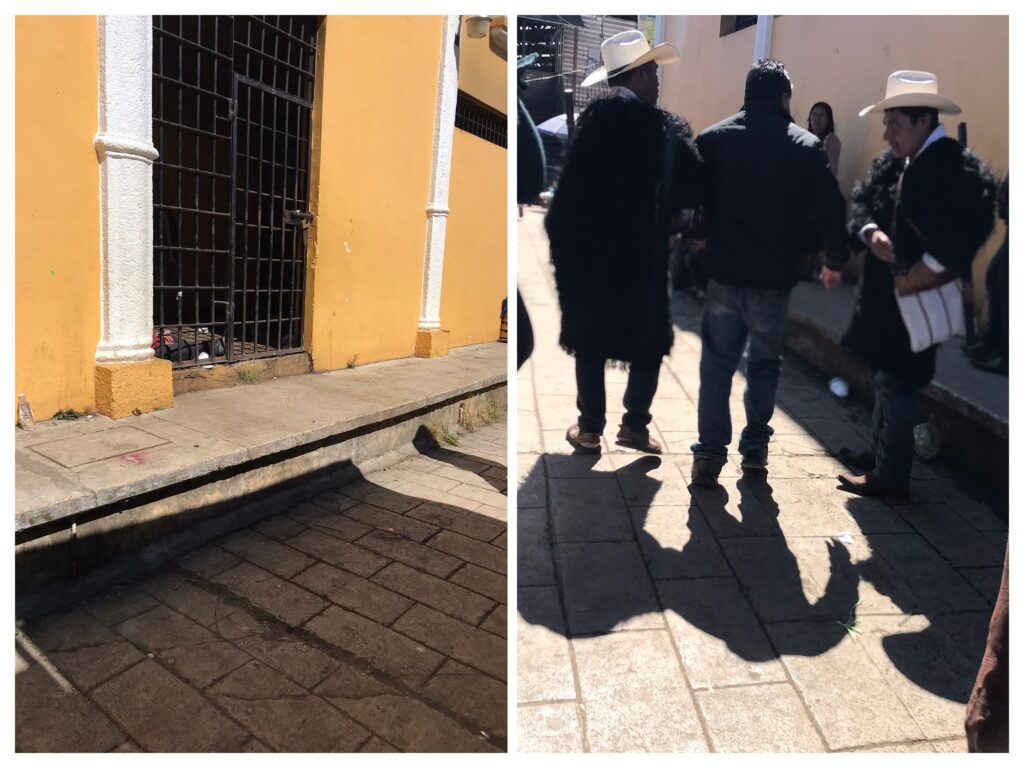
Arresting a man and placing him in the town jail – Chamula polices itself
While it looks normal enough from the outside, the church in Chamula is not like any other church anywhere in the world. Pine branches cover the floor, there are no pews, no vicar and no real altar. To one side of the church is a row of images of Catholic saints, but the religion practised here can’t really be described as Christianity. Worshippers kneel on the floor near to their chosen saint surrounded by hundreds of multicoloured candles, you almost have to step over people to reach the front of the church. When we entered the air was thick with the smoke of the coloured candles. According to the beliefs, each colour represents a hope or wish such as luck, wealth or happiness; the colour and density of candles depends on the prayer.
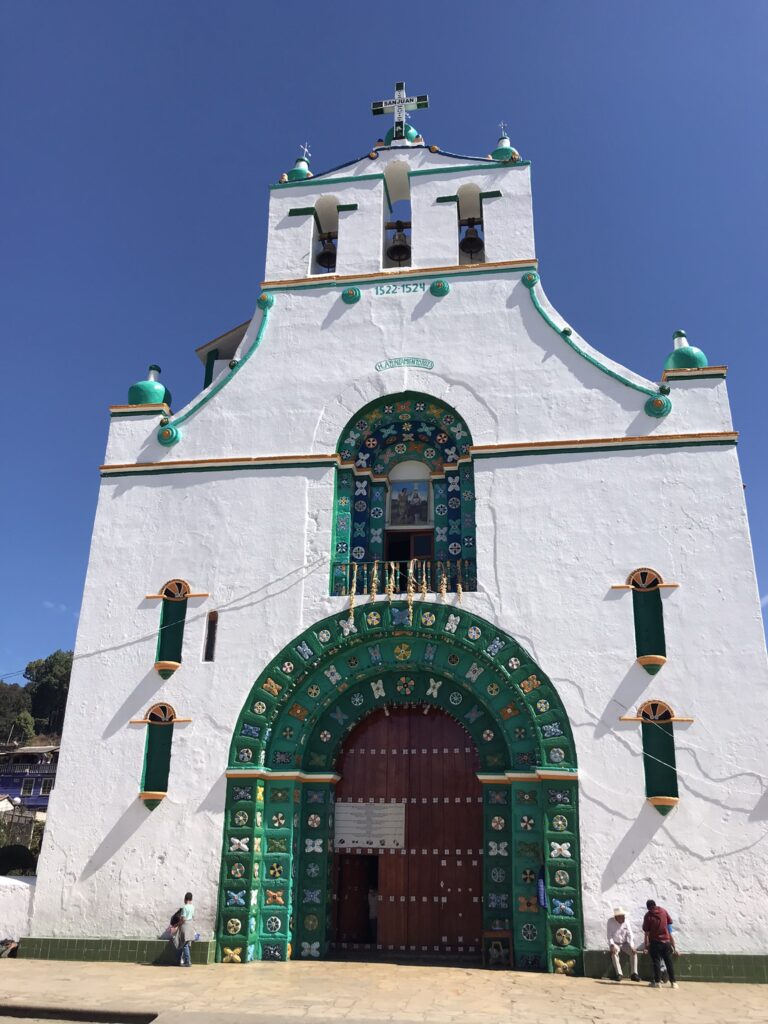
The outside of the church in Chamula
As well as candles, bottles of fizzy drinks such as Coca-Cola were everywhere. The fizzy drinks are part of the ritual, they are thrown around the floor to placate the saints and are drunk by the worshippers to induce ritual burping. The worshippers were whipped up into a trance-like state with their candles burning, chanting prayers and waiting for the moment for the sacrifice of the chicken. A priest/shaman kneeled with the worshipper to assist with their offerings, lead prayers, point out which saint they should pray to and eventually perform the sacrifice of the chicken. The sight and sound of the chickens being killed was shocking and could be upsetting to some, but all these elements have ritualistic meaning to the local people. I won’t forget the sight of the shaman/priest breaking the neck of a chicken.
Going inside the church was a special experience. There is a small entry fee and no photos are allowed at all, this is really strictly prohibited and anyone caught taking photos in the church would likely face dire consequences.
As well as the church, we learned that some residents perform a religious public duty by looking after a shrine to a particular saint. As part of the tour we visited one of the shrines which, like the church, was also filled with palm branches. Citizens perform this service for a year, creating a financial burden for them as they aren’t able to work during this time. We also heard loud bangs and explosions throughout our time in Chamula, which was described as normal. We later saw that the cause of these blasts was local men setting off extremely large firecrackers (almost like mortars) in the street, apparently also as part of some sort of celebration or ritual.
As well as Chamula we also visited Zinacantan, another indigenous town which is a major flower producer and exporter in the region. The Zinacantan flower market is one of the biggest in the country. The church there was slightly more traditional with pews and the usual religious iconography, however there were mirrors in the church which is usually forbidden. There were also loads of flowers in the church, and randomly a turtle shell. While in Zinacantan we visited a local family who showed us how they produced the traditional fabrics used to make their dress, and also made tacos for us.
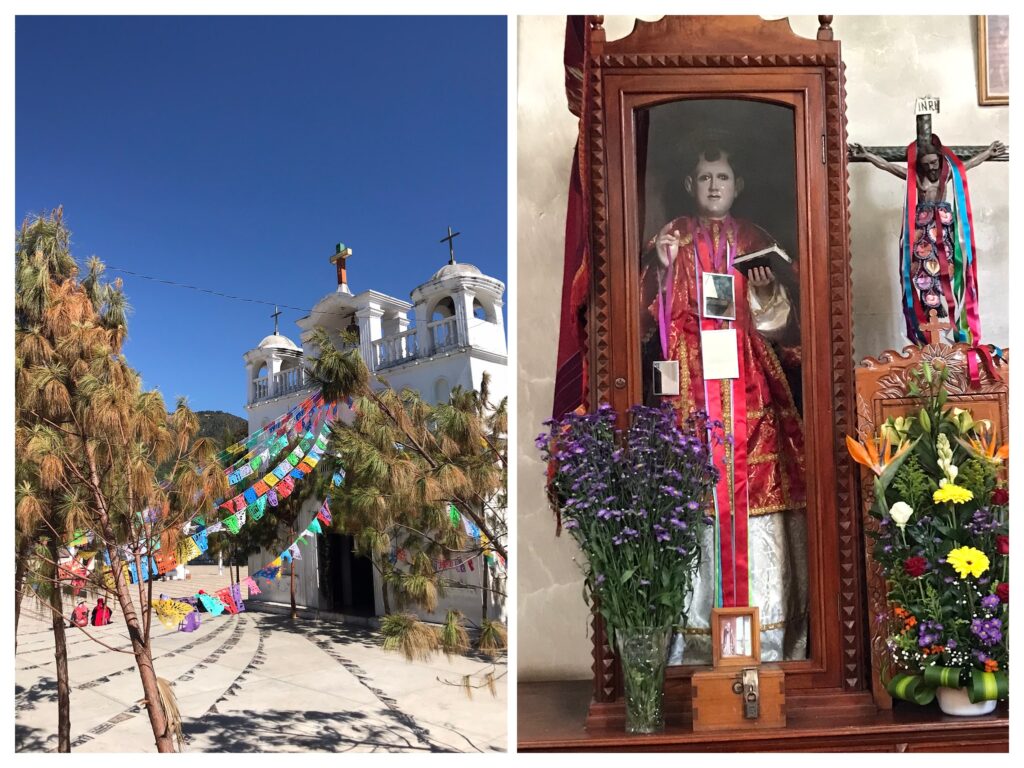
The most interesting aspects of the church in Zinacantan were the mirrors lining the walls and the statues
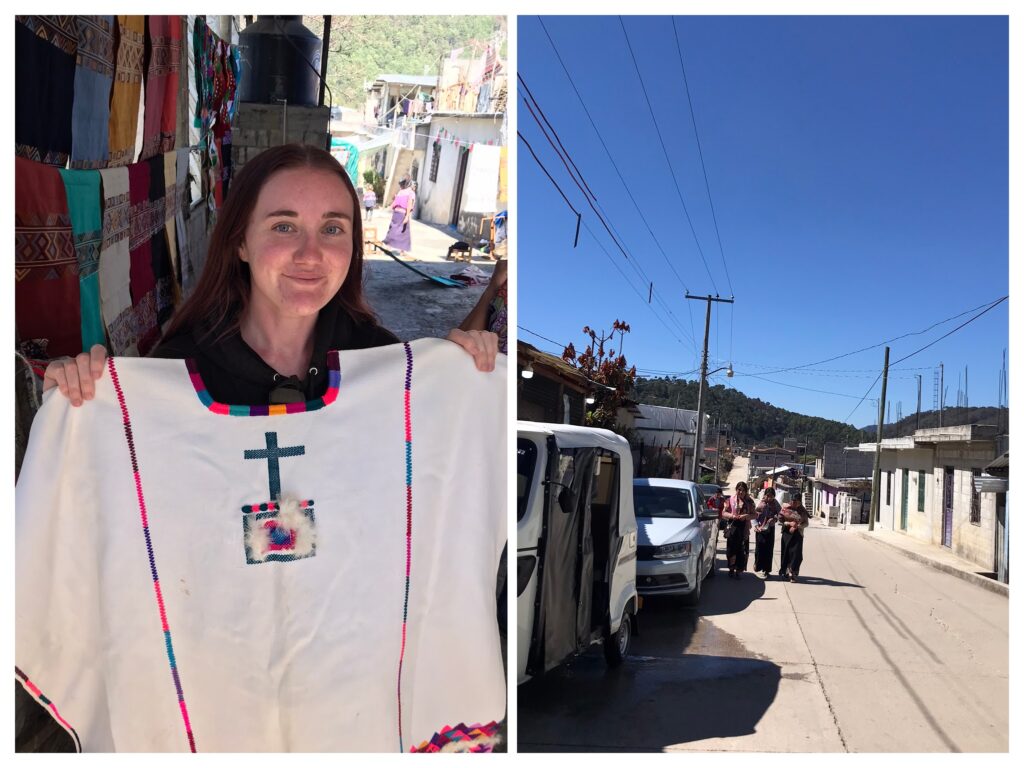
Admiring the traditional local clothing in Zinacantan
If you want to visit Chamula and Zinacantan, I highly recommend going on a tour with a local guide rather than attempting to do it yourself. At first glance these seem like fairly average small Mexican towns, it is only when things are explained that you are able to see below the surface and get a fuller picture and understanding of the communities and their unique customs. The guide can also help to explain the boundaries of where you can and can’t go and what can and can’t be done, as these communities have their own rules and customs which may be different from other parts of Mexico. Without a guide to explain things, the church in Chamula would be a baffling and overwhelming experience. It kind of was anyway.
Chamula and Zinacantan are not the only such indigenous towns and communities in the region, but they are two of the most open and accessible for visitors. We were told that some of the other communities might not be so welcoming.
Palenque
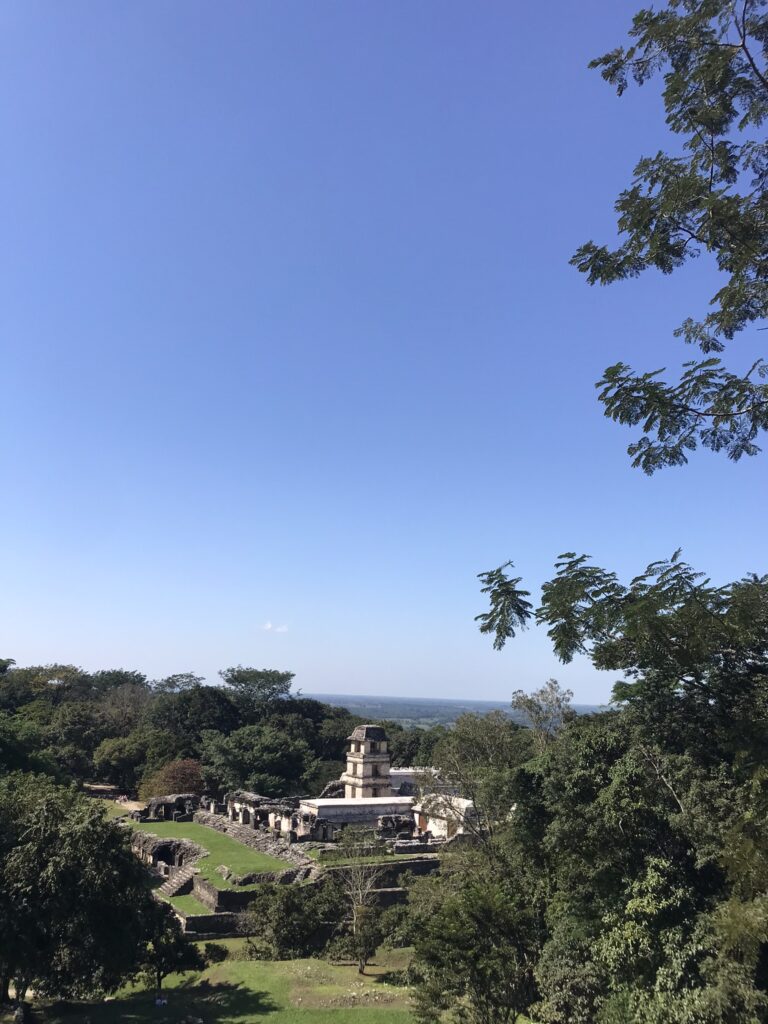
The small city of Palenque is best known as the gateway to the ancient Maya ruins at the Palenque archaeological site. To most people the word Palenque just refers to the archaeological site, but the town was actually in existence for 200 years with that name before the archaeological site was discovered. Palenque is in a remote part of Chiapas surrounded by rainforest, it was humid and really felt a lot more jungle-like than the mountainous regions of Chiapas to the south. The journey from San Cristobal de las Casas took a very long time, diverting around a long and winding route and passing through Campeche state as the direct route through the centre of Chiapas isn’t safe for intercity buses to travel.
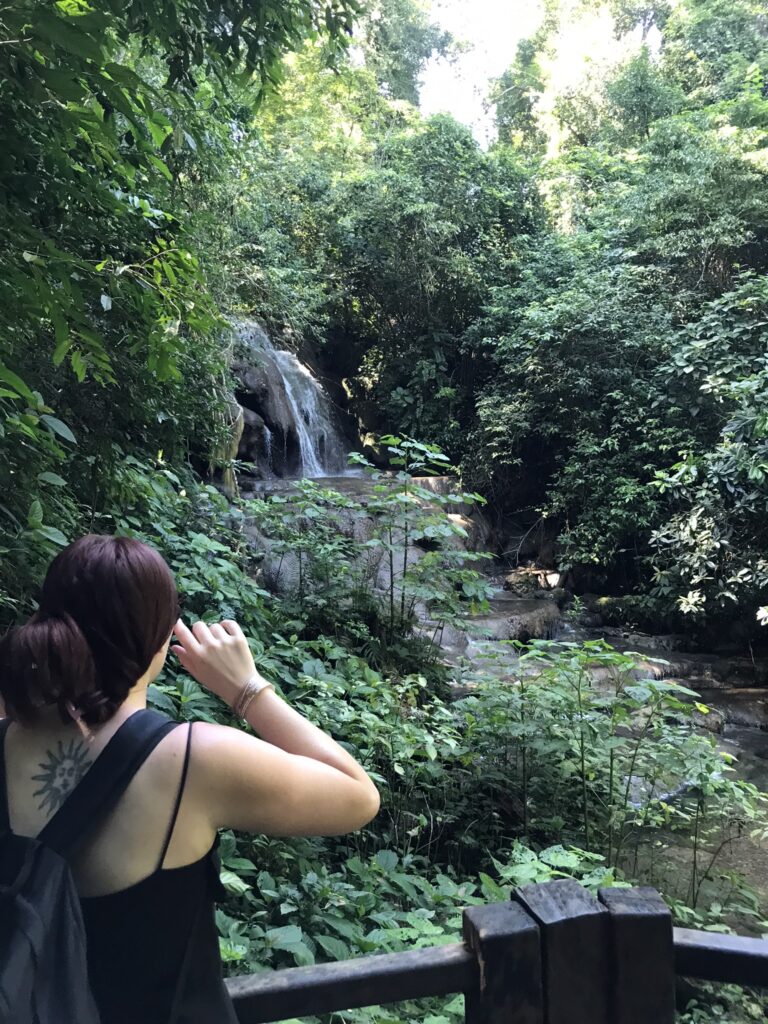
Palenque definitely felt more remote than anywhere we’d visited so far in Mexico
Palenque has recently become a lot more accessible to tourists coming from the Yucatan peninsula due to the construction of the Tren Maya. Only the route between Palenque and Playa del Carmen was running when we were there. We drove past the train station and saw that it was very modern, almost like an airport terminal. We’re not sure how well Palenque will cope with the huge influx of tourists that the train is expected to bring. The small city isn’t all that developed and I’m not sure if the amenities for mass tourism are there yet. We found that the train was quite expensive when compared with the price of the public bus. It is clearly aimed more at wealthy holidaymakers than backpackers or locals.
Accommodation
Casa Hadassa La Cañada – an affordable place to stay, almost like a large house. The shared kitchen was well equipped and spacious and the rooms had good air-con, which was important as Palenque is quite hot and humid. The terrace backed onto a wild jungle-like area which was a nice place to sit and drink coffee in the morning. There are lots of bugs around the place. Expect some wildlife to appear in your room at some point – it is in the middle of jungle terrain after all.
Foodie Places
Cafe Campo – a no airs and pretences sort of place serving up Mexican classics. This place was on the cheaper end of the spectrum. There are lots of mid-range and more expensive restaurants in Palenque catering to international and domestic tourists but we opted for the budget choice and were happy with the food we got from Cafe Campo.
Chedraui Palenque – this supermarket was massive and stocked just about everything you could possibly need, from clothing to electrical appliances to Chiapas cheese. It’s a short walk from the town centre and great if you have a kitchen in your accommodation as we did.
Activities
Palenque archaeological site – it is possible to get a colectivo from the city centre to the archaeological site, but the vans didn’t seem to be running from any of the expected pickup points on the day we visited. We ended up splitting a taxi with some French people we met outside the bus station who also couldn’t find the colectivo. The entry process to Palenque is quite strange, you have to queue up and purchase a ticket near the museum and then walk quite a long way uphill from the ticket office to the actual site. There are two entrances to the site, if you follow the paved road all the way to the top you will eventually reach one of the entrances, there is also a small optional nature walk along this route if you get tired of walking on the road.
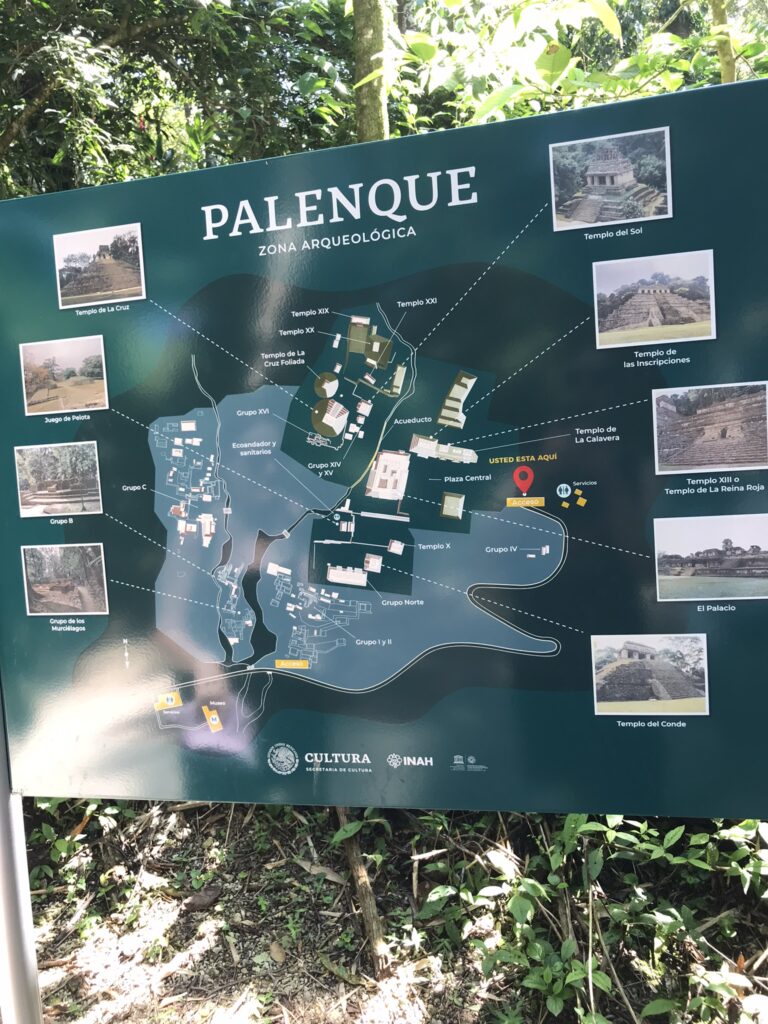
Map of the Palenque Archaeological Site
Palenque is definitely one of the most grand and impressive Mayan sites. You can climb to the top of most of the temples and go inside the burial chamber in the Temple of the Red Queen. As well as the many magnificent temples, the rabbit skull and carved tableau of rulers were particularly fascinating. As usual we opted to visit without a guide and just used a self-guided tour that we found online. Guides were loitering at the entrance though for people who prefer to have a guide/can afford it.
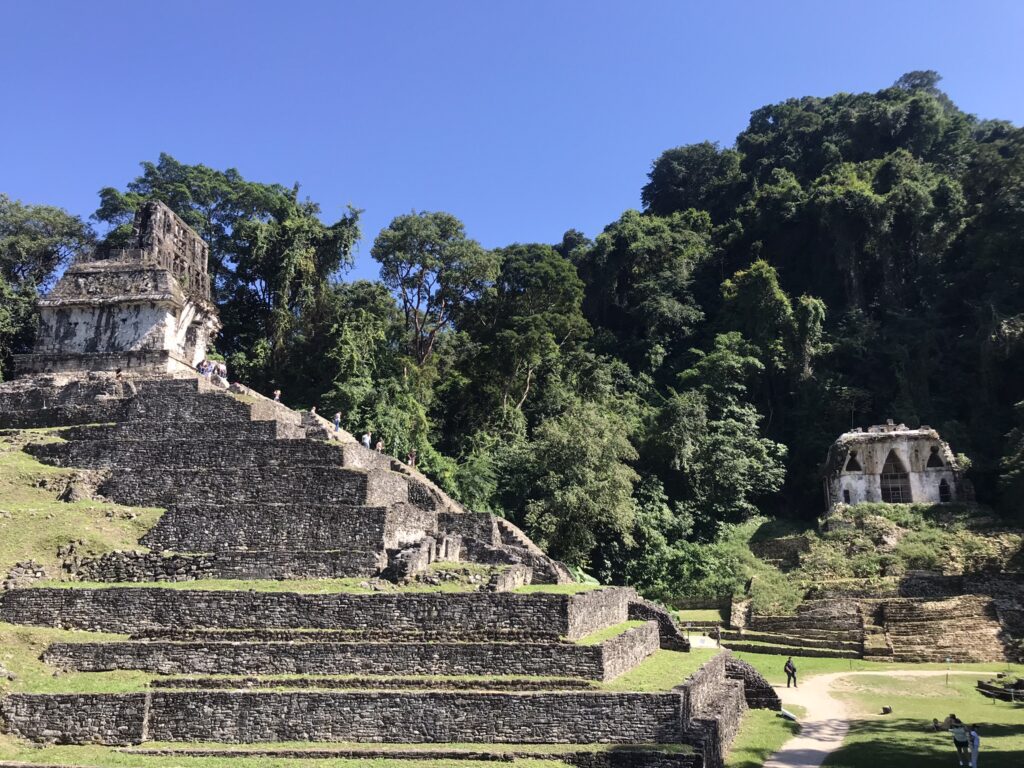
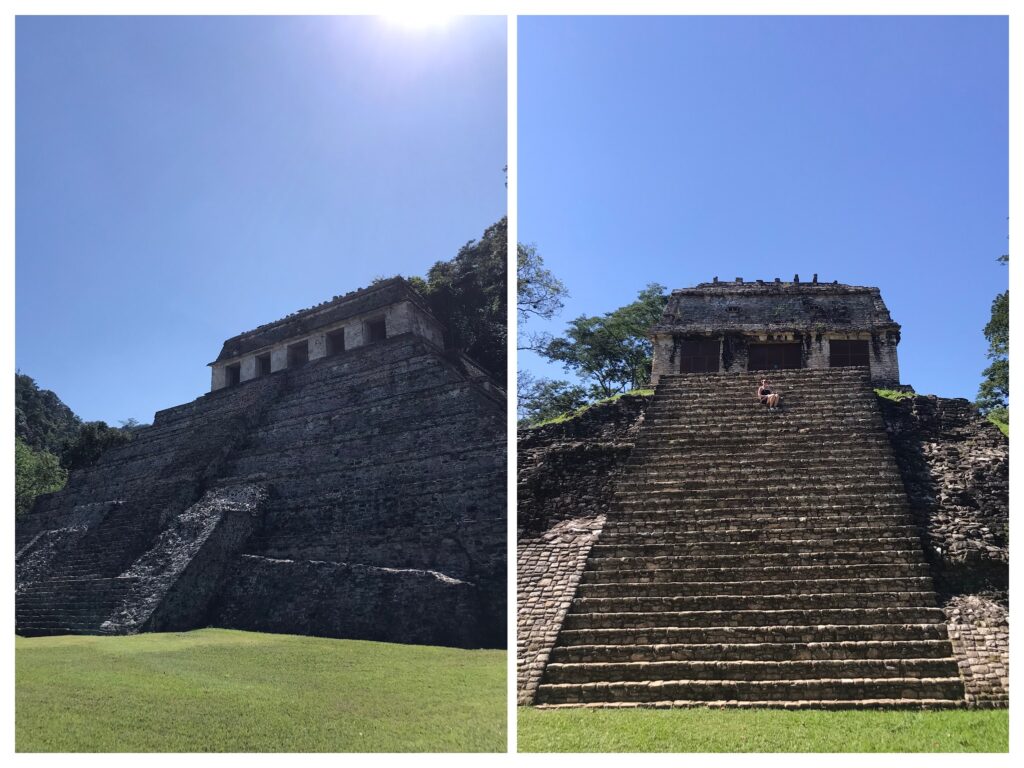
The stepped temples at Palenque are perfect examples of Mayan architecture
The general consensus is that it is better to get to the archaeological site in the morning, as there may be cloud formations on some of the temples giving the site a mystical feel, and also as the temperature in the mornings is cooler. I can definitely vouch for this advice, we went in the afternoon and it was scorching.
Campeche
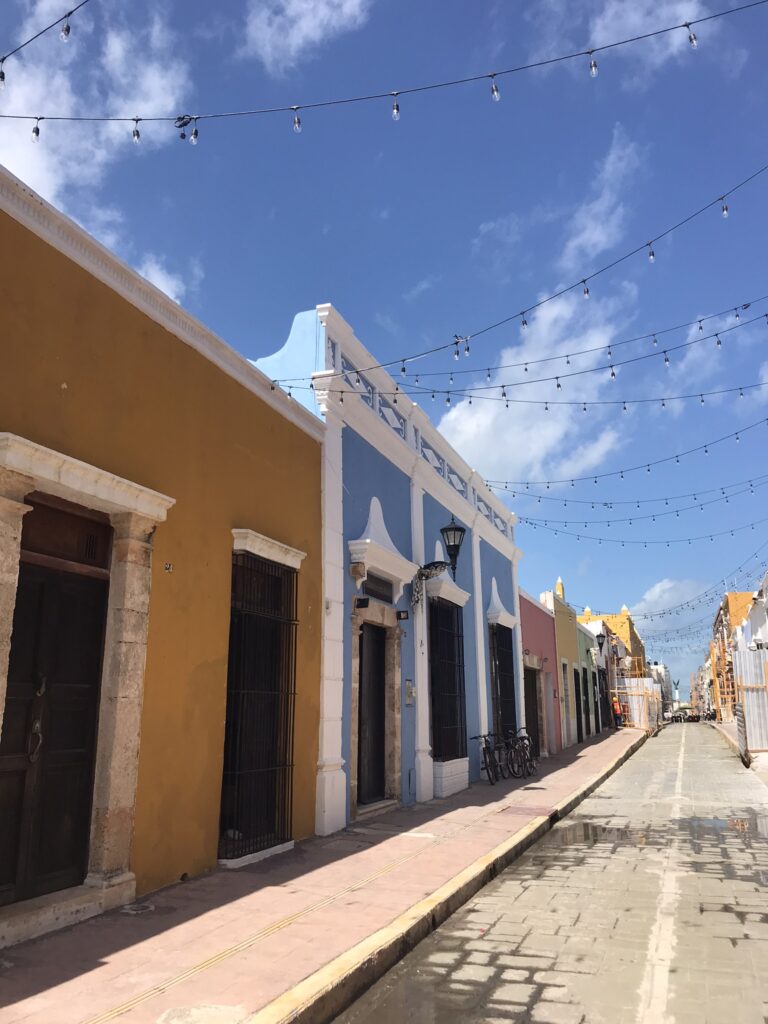
Campeche is a colonial walled city on the coast of the Gulf of Mexico. Strangely, Campeche seemed to have far fewer tourists than a lot of other cities and towns further east in the Yucatan peninsula. I’m not sure if this is normal or if we just happened to come at a quiet time. Either way, I was surprised that it was so quiet as the city has an interesting history full of buccaneers and pirates and also because the historic walled centre of Campeche is extremely walkable and pretty. Firmly situated in the Mayan heartland, Campeche also boasts some impressive nearby archaeological sites.
The historic district is full of colourful streets with mostly one-storey colonial buildings. The colonial houses are both a blessing and a curse. Similar to Havana, the humid atmosphere has decayed and destroyed a lot of the old houses. Some buildings are now just the outside facade with nothing inside. Those that are well maintained suffer from extremely high maintenance costs.
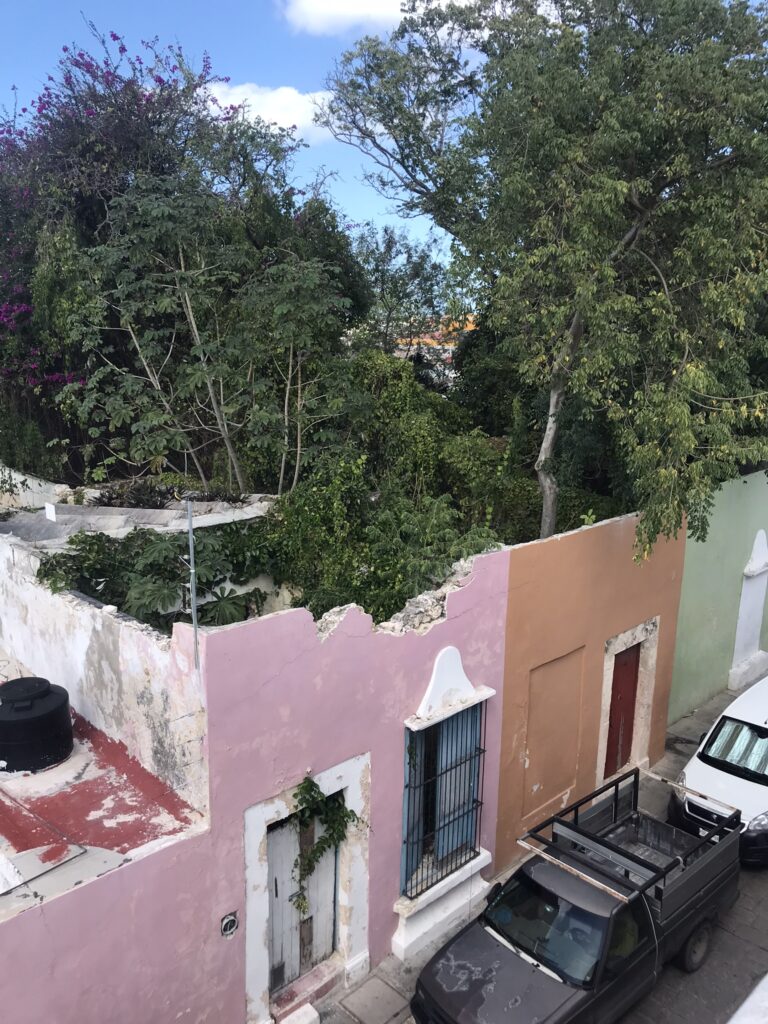
From the city walls you can see that some of the crumbling buildings are actually just a facade
To get to the historic district you have to go through a gate within the city walls. Campeche is much bigger than just the walled city, the modern city lies outside the city walls and is where most of the local people live and work.
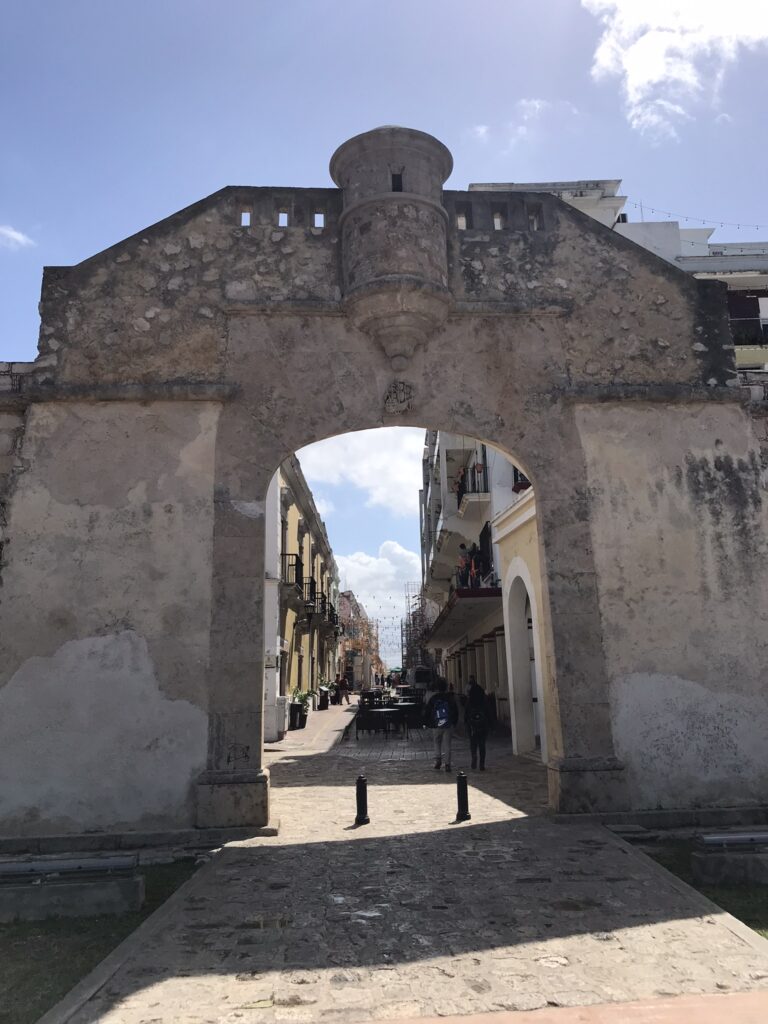
Sea Gate is the entrance gate closest to the seafront
As well as the historic area, Campeche has a clean and modern malecon stretching for a few kilometres along the waterfront – a great place for walking or just relaxing and enjoying the sea air.
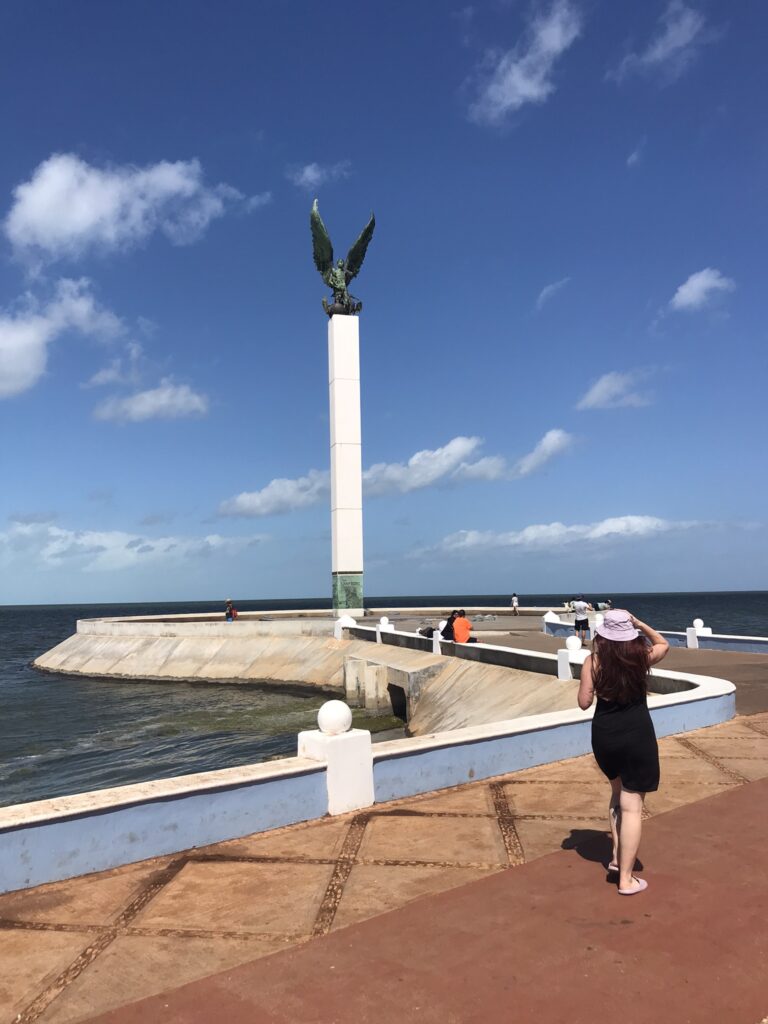
Hold onto your hat on the malecon in Campeche
Accommodation
We stayed in an Airbnb close to Calle 59. Most tourists opt to stay in the historic walled city as that is where most of the attractions and museums are located.
Foodie Places
Calle 59 is the most popular pedestrianised street for dining out, although it was quite quiet when we visited, maybe because it was during the week. You will find lots of waiters and waitresses on the street trying to get passers-by to look at their menus.
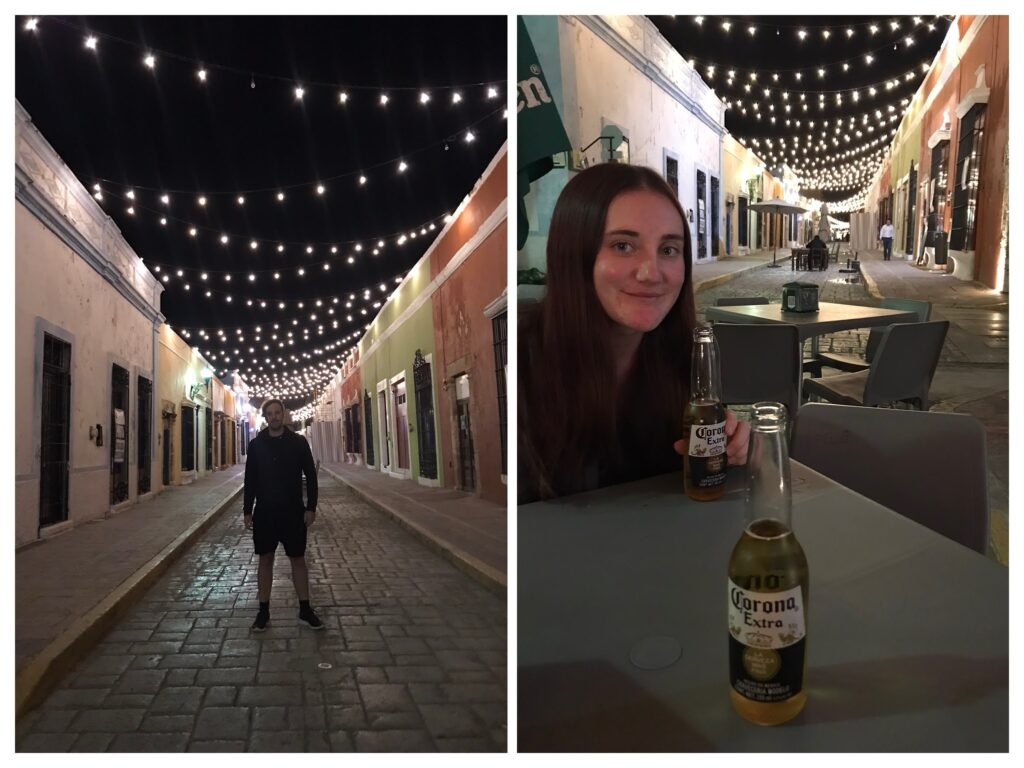
Calle 59 is the perfect setting for a romantic meal
Taquería Los Toños – about as authentic as you can get. The taqueria is quite a way out of the historic centre and is full of local patrons, there were local guys coming straight from football practice and local families eating out. We were very happy to see wheat tacos on the menu as we aren’t big corn tortilla fans. All the classic taco flavours are available as well as some other interesting combinations, including a jacket potato with tortilla combo.
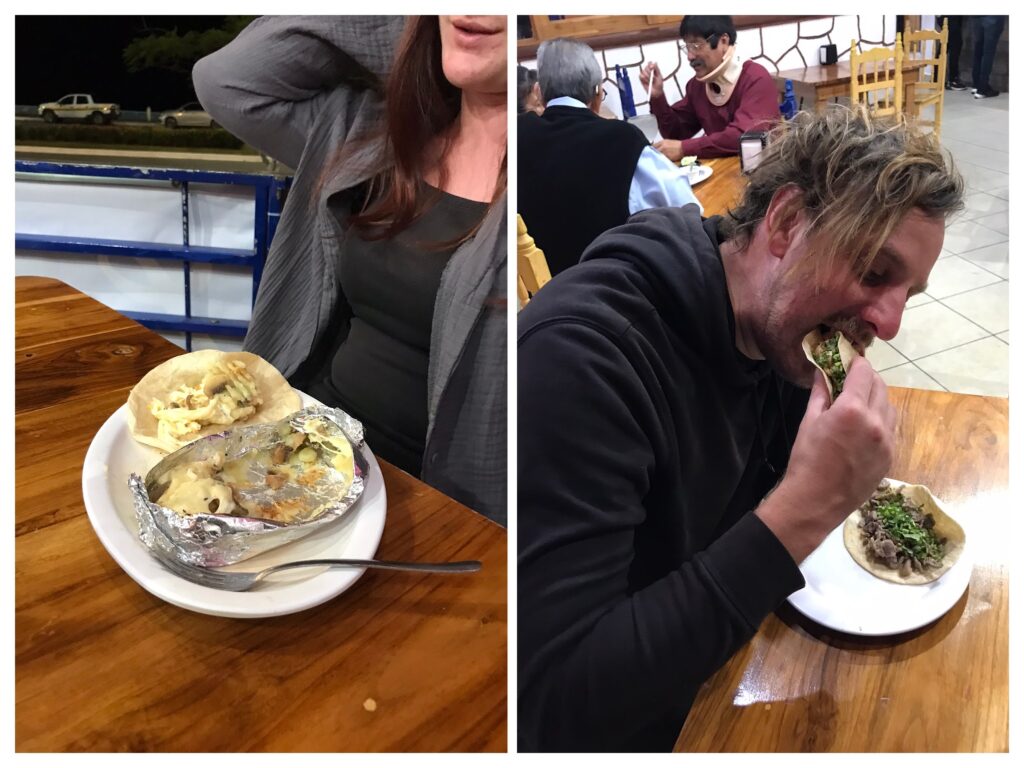
Tucking into our wheat tortillas at Taquería Los Toños
La Parroquia – a central spot to try local delicacies such as lime soup, shark tortilla, tamales and horchata. It’s a place frequented by locals and tourists. Not the cheapest but definitely worth a visit if you’re interested in the local food of the region – this place was recommended by our walking tour guide.
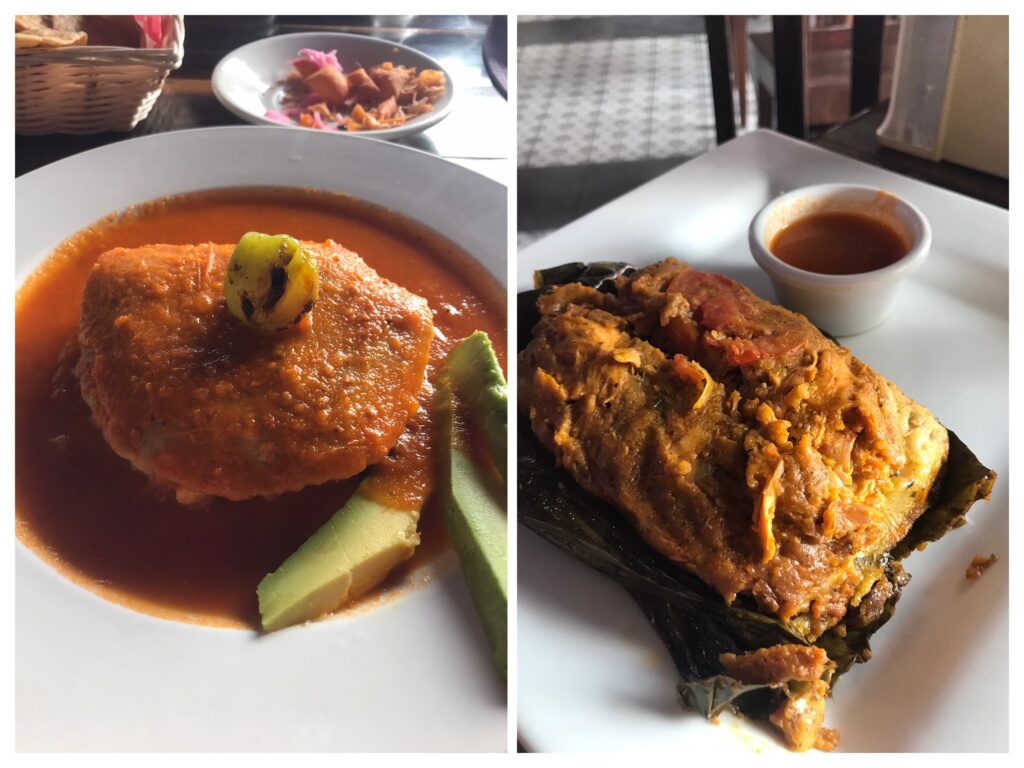
For travellers wanting something a bit more special head to La Parroquia for local specialities
Activities
Guruwalk walking tour including Centro Cultural Casa 6 (a restored colonial house in the Plaza de Independencia, a very costly renovation), the Land Gate and Sea Gate of the city walls, Catedral de Nuestra Señora de la Inmaculada Concepción, Independence Square, Templo del Dulce Nombre de Jesus (a church historically frequented by black residents and slaves in the city, segregated from the white congregation) and Iglesia de San Roque y San Francisquito (a church containing a controversial painting depicting a black slave being stepped on by an angel).
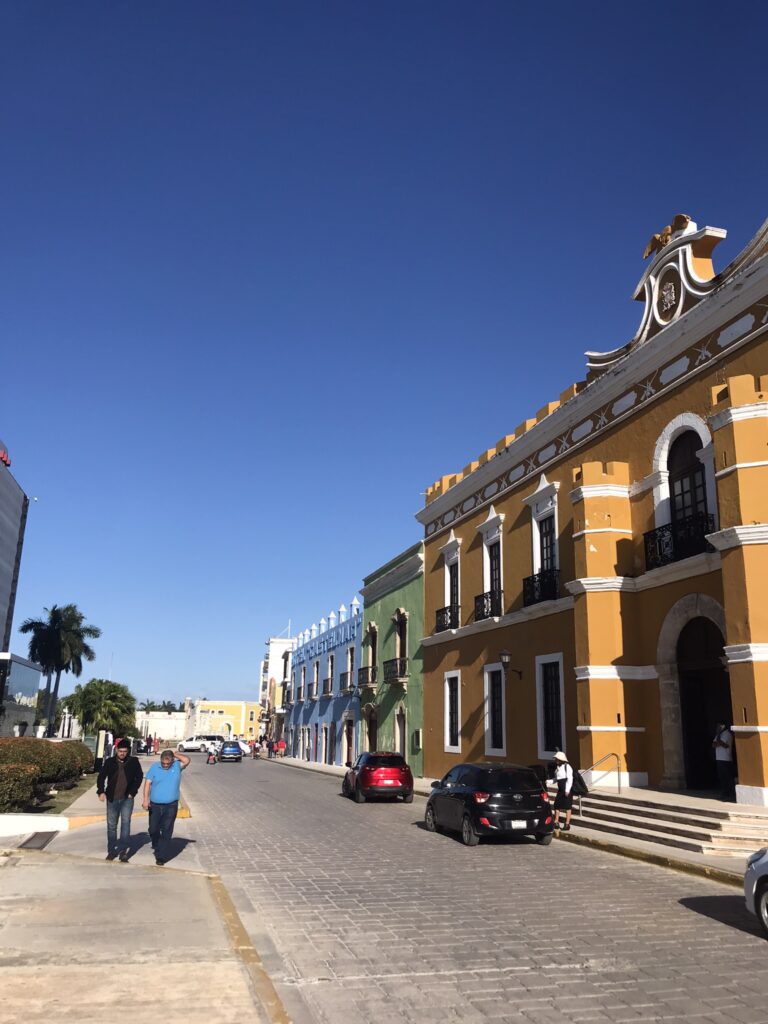
The main square in Campeche is the focal point of the city
Puerta de Tierra – this is the place where you can climb and walk the city walls. Pay the guys in the kiosk and they will unlock the gate to let you up onto the walls. When you’re finished you have to ring a bell to come down. We found it interesting to look down into some of the collapsed houses, which seem completely normal from the street as the facades are still maintained as if they were functioning buildings.

Climbing the city walls gives you a different perspective of the walled city
Mayan Architecture Museum – this museum contains many impressive Mayan artefacts, including huge stelae with inscriptions. There are also small displays of gold and other valuable items. The museum contains lots of information in English and interesting info and translations of the Mayan language. The centrepiece of the museum is the famous jade mask which was discovered at the Calakmul archaeological site.
El Palacio Centro Cultural (Museum of the city) – set in the edifice of the library in the main square. The museum contains information about famous pirates/privateers, one room has been completely transformed into the deck of a ship. There is also religious iconography and colonial reliquaries. Admission is free.
Malecon – a nice place to go for a stroll at sunset.
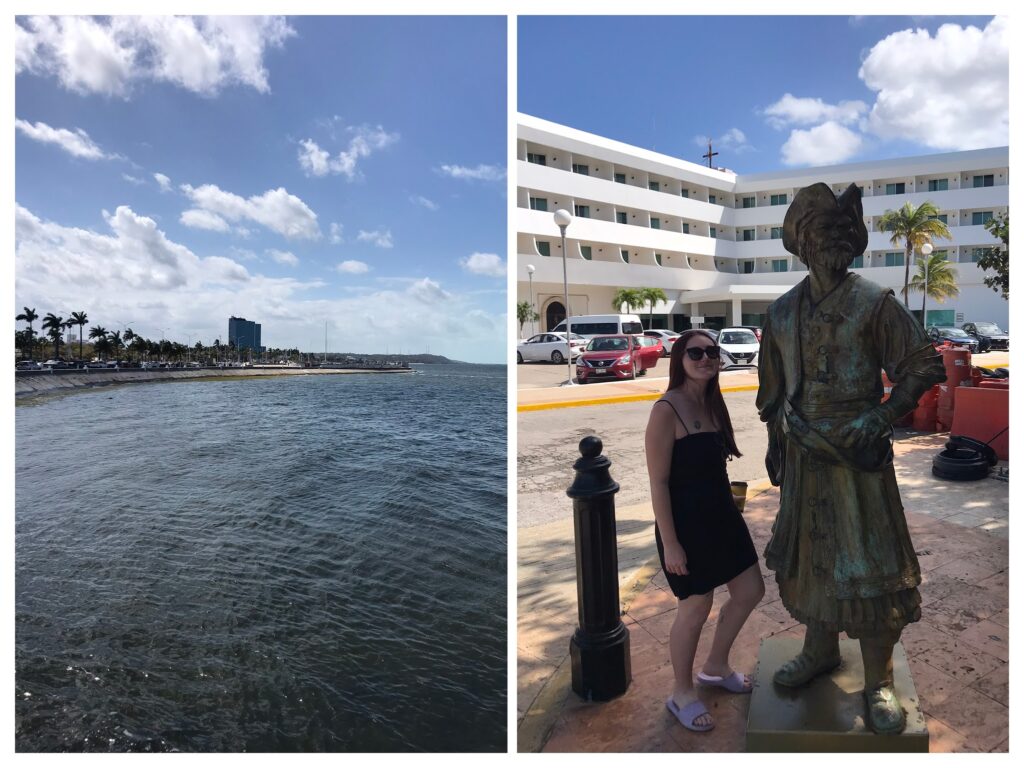
Keep an eye out for the statue of the pirate!
From Campeche we headed to Bacalar via Merida. We had enough time to dash to the main square in Merida and back to the station in between buses.
Bacalar
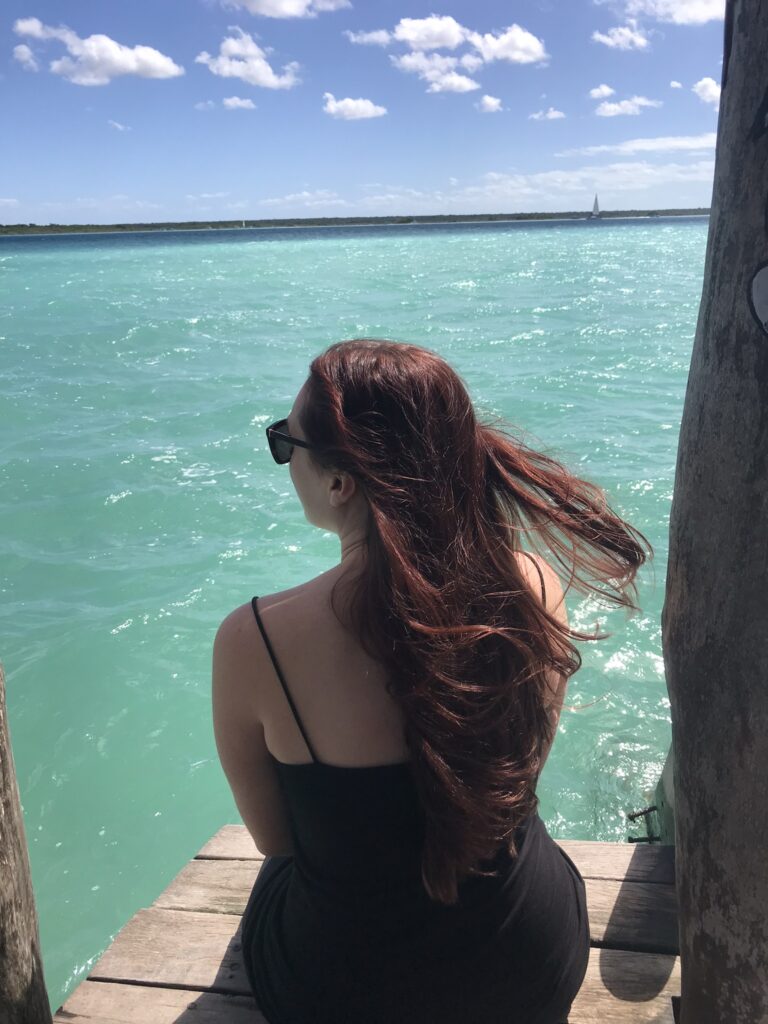
Bacalar is best known for the Lagoon of 7 Colours, which are mostly variations of blue and green. We stopped over for a day on the way to Belize. The lagoon is beautiful and definitely worth seeing. Unsurprisingly, other than the lagoon we found Bacalar to be a bit of a tourist trap, perhaps due to its proximity to Cancun. Prices were high, there were more gringos around than locals and lots of hustlers trying to sell boat tours on the lagoon.
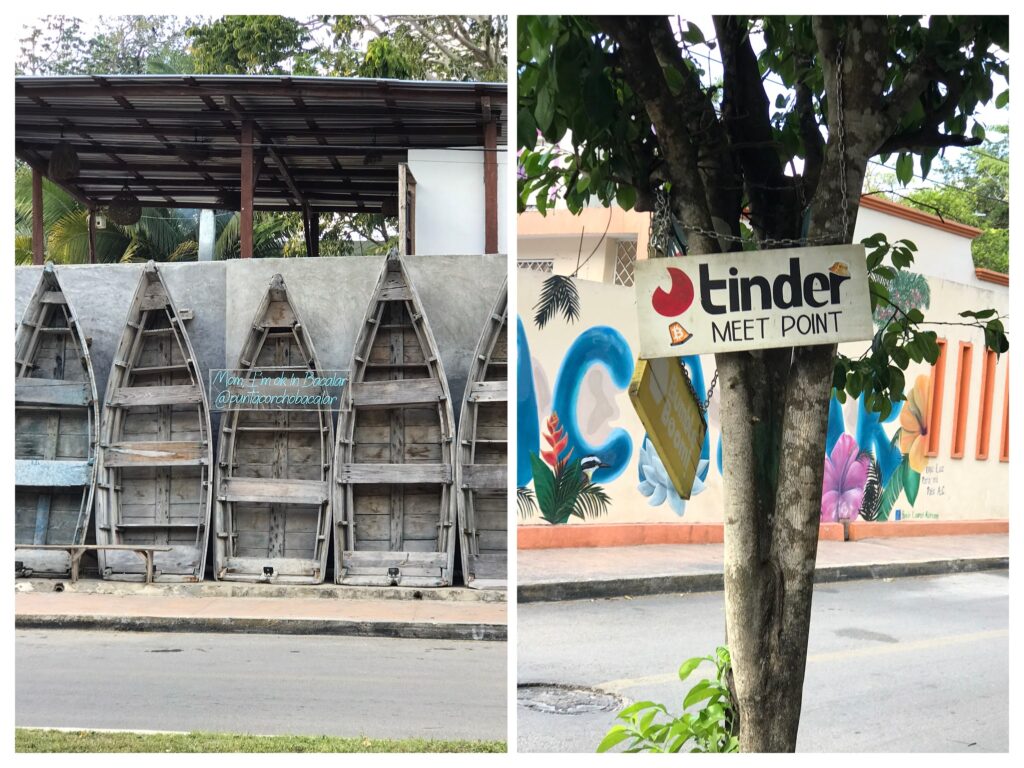
Quirky signs in Bacalar
Accommodation
Hotel Balché – The room itself was very modern, clean and comfortable. It’s a short walk from the centre but close to the docks overlooking the water. I booked this place specifically for the kitchen however when we arrived at 8pm we were told that the kitchen was closed. I subsequently found out that there weren’t actually any hobs or a cooker, only a kettle. This was slightly disappointing as we’d brought pasta to cook.
Foodie Places
There are really limited cheap food options in Bacalar. Most of the restaurants have sky high prices which presumably is an attempt to squeeze as much money as possible out of tourists.
Gregor’s Pizza – we ended up eating here two nights in a row due to the lack of any other affordable food options in Bacalar. This is a local pizza takeaway place, very basic and I think the owners were a little confused that we were eating in. This seemed to be a go-to place for locals though and was constantly busy with takeaways and collections. The prices were cheap, the owner was honest and didn’t try to short-change us and the pizza was decent enough.
Hakuna Matata Restaurante – associated with the nearby Hakuna Matata eco huts, this cafe/restaurant has a smaller than average menu. We had breakfast here, the price we were charged was slightly different to what was advertised on the board outside, not sure if this is to lure in tourists and then scam them? The food was tasty but it is annoying to be charged more than advertised.
Maracuya Beach Club Bacalar – a mixture of pop-up street food stalls including pizza, sushi and taco vans. We particularly loved the fish tacos. There are cool views over the lagoon here. The food was slightly more expensive but it’s a beach club so after you order you can hang out on the sun-loungers by the lagoon front for free.
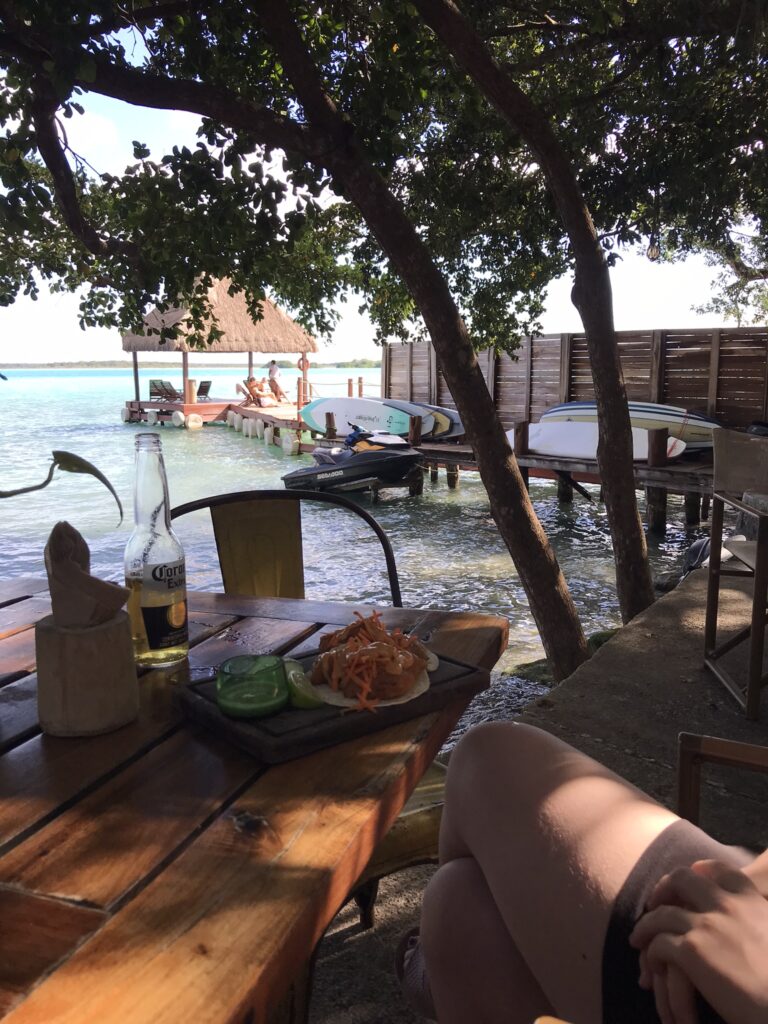
Delicious fish tacos and beautiful views over the lagoon at Maracuya – what more could you ask for!
Activities
We only spent a day in Bacalar and opted for free activities rather than paying for an expensive boat tour. For those with the time and inclination, there are many different boat tours available to explore the lagoon.
Fort San Felipe – it is possible to go inside this fort, we just looked at it from the outside as we’ve seen plenty of colonial forts and didn’t want to pay the entrance fee.
Sunbathing on the boardwalks – probably the most famous image of Bacalar is the wooden boardwalk piers leading out into the lagoon. There are several boardwalks along the waterfront, some of them are private but a couple are public and you are free to wander down to them and spend as much time as you like. There are benches or you can just sit on the edge of the platform with your feet in the lagoon watching the changing colours. The boardwalks can sometimes become crowded with sunbathers or just groups of people hanging out, which can create a jovial atmosphere at times. We ended up listening to an impromptu musical performance by a group of young guys on one of these piers.
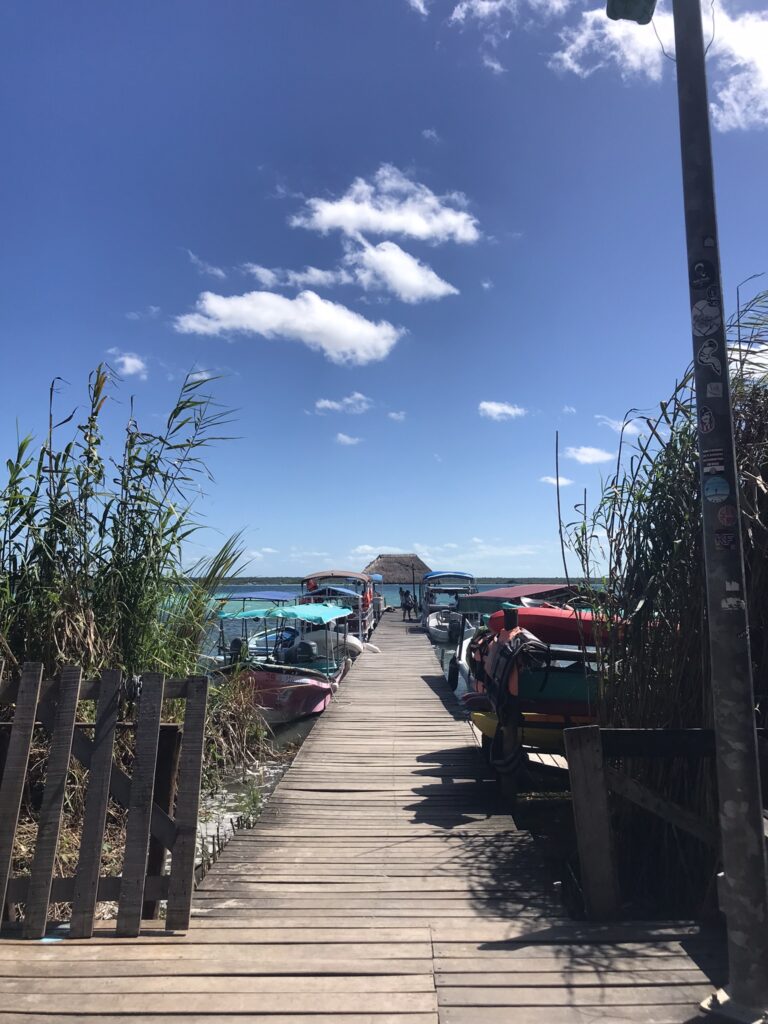
The boardwalks are free to lounge on – make the most of them!
After Mexico, we headed to Belize. Read about our experience with the border crossing here!
